Tokyo (5 days)
The start of our journey kicked off with a flight from Melbourne to Tokyo aboard Philippine Airlines, the flight itself is about 12 hours long, but including the 8 hour layover in Manila we spent closer to 20 hours neither in Melbourne nor Tokyo, hooray for the airport lounge we managed to book! 🫠 I don't think I would have survived without the buffet and a comfortable chair to have a snooze in. 😴
After the very long layover and "short" 4-hour flight, we finally arrived at Haneda Airport and took a taxi to a hotel which we could recharge at, about 10 minutes away. Although let me tell you, it took us a good 20 minutes to figure out which one of the many levels of the airport we actually needed to be at so we could get a taxi (without being ripped off). 😅
Once we arrived at our overnight hotel, we checked in and caught up on some much-needed sleep — lights out!
The following day, we woke up early to catch a shuttle bus back to Haneda Airport and hop on a train. Despite expecting warm Spring weather, we were instead greeted with a brief snowy morning and grey skies all around. 🌨️🥶
Akihabara
After being dropped off at Haneda Airport, we took some time to get our Suica cards (a prepaid card for public transport) and then hopped on the train to Akihabara, the famous district known for its electronics shops, anime, manga culture, and maid cafes (this particular one was actually a male maid cafe)... 😳🚆
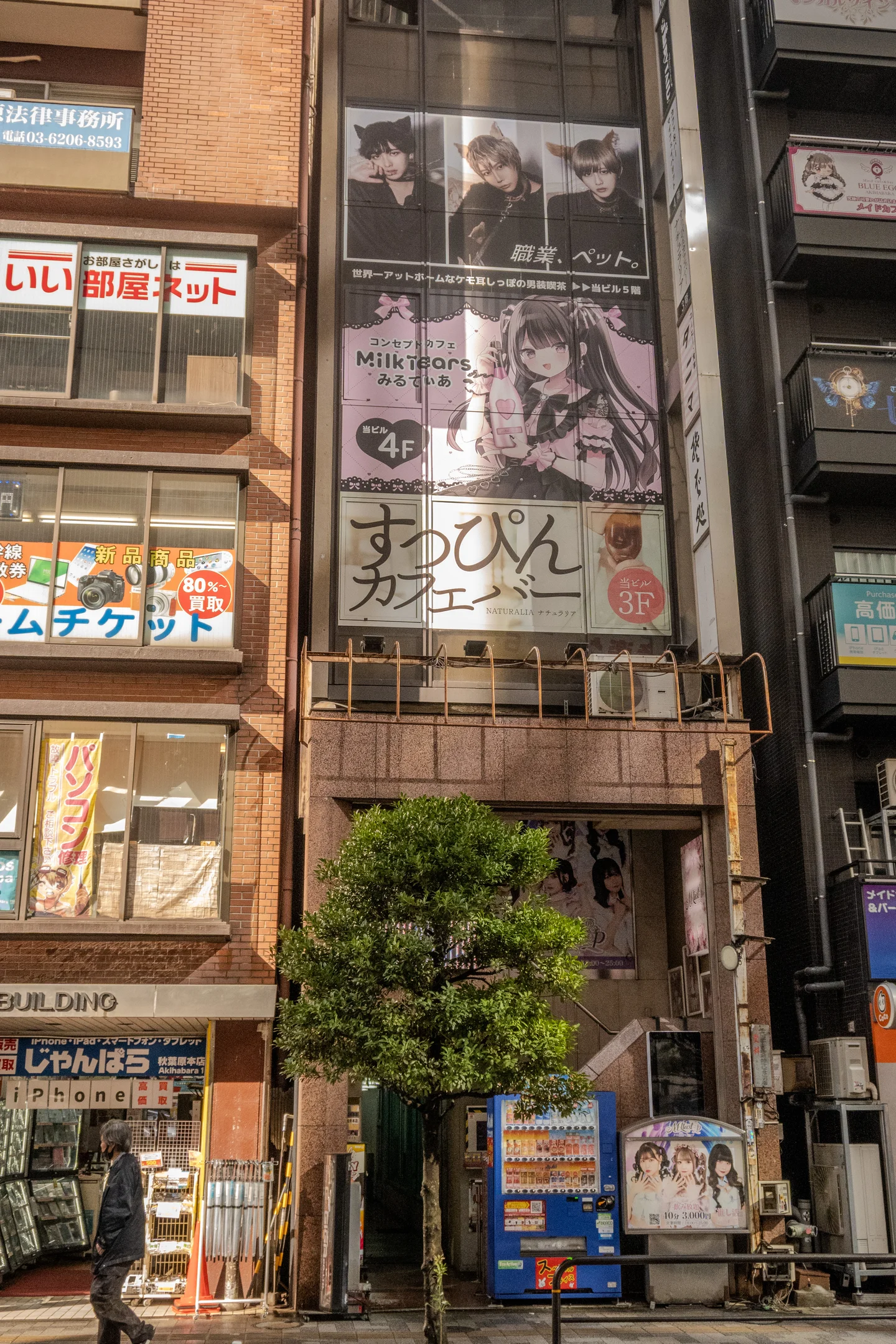
Getting to Akihabara was a breeze. The train system in Tokyo is very efficient and easy to navigate (with a bit of a helping hand from Google Maps). We arrived at Akihabara Station, and with our luggage in hand, we set off to venture around and find a storage shop to drop off our bags.

We search for a good 30 minutes, walking around in circles with our heads buried in Google Maps before finally spotting a tiny opening in a shopping strip just across from the local Starbucks. It was random tech repair shops and other weird gizmos... But there it was, a storage shop! We hand over our bags to the old Japanese man and hope they're still there when we get back... Arigato gozaimasu! 🙏😅
Of course, now being nearly 1:30PM, we had to cross the street and check into Starbucks after only living off airplane coffee and airplane food for 24 hours — WE NEEDED COFFEE! 🤯☕️
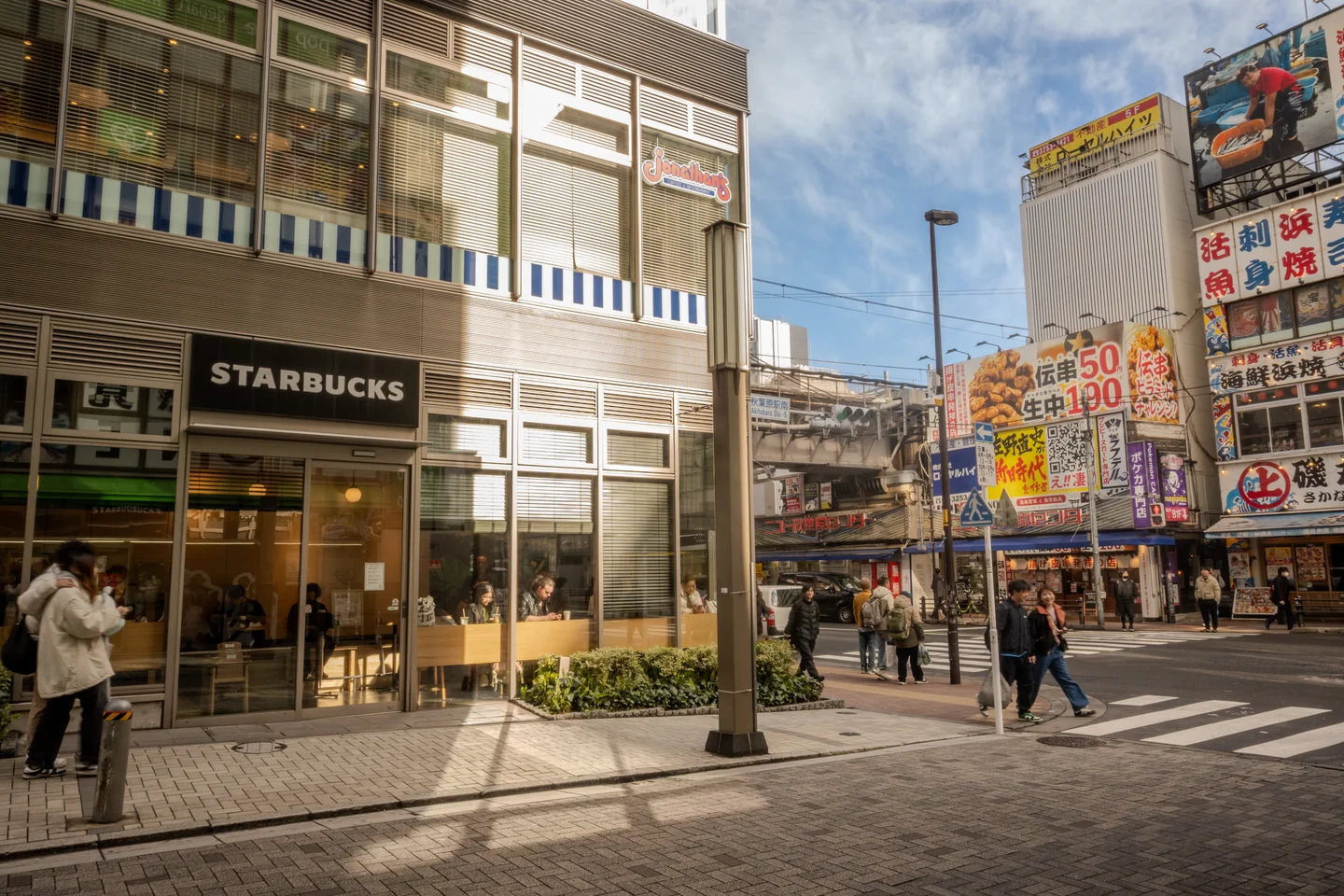
Now refueled and our veins pumped with caffeine, we head off in search of a place to eat lunch. After a bit of searching on Google Maps, and walking around, we find a small Gyukatsu restaurant located down some stairs which lead us into the basement level of a building, it was called Gyukatsu Motomura.
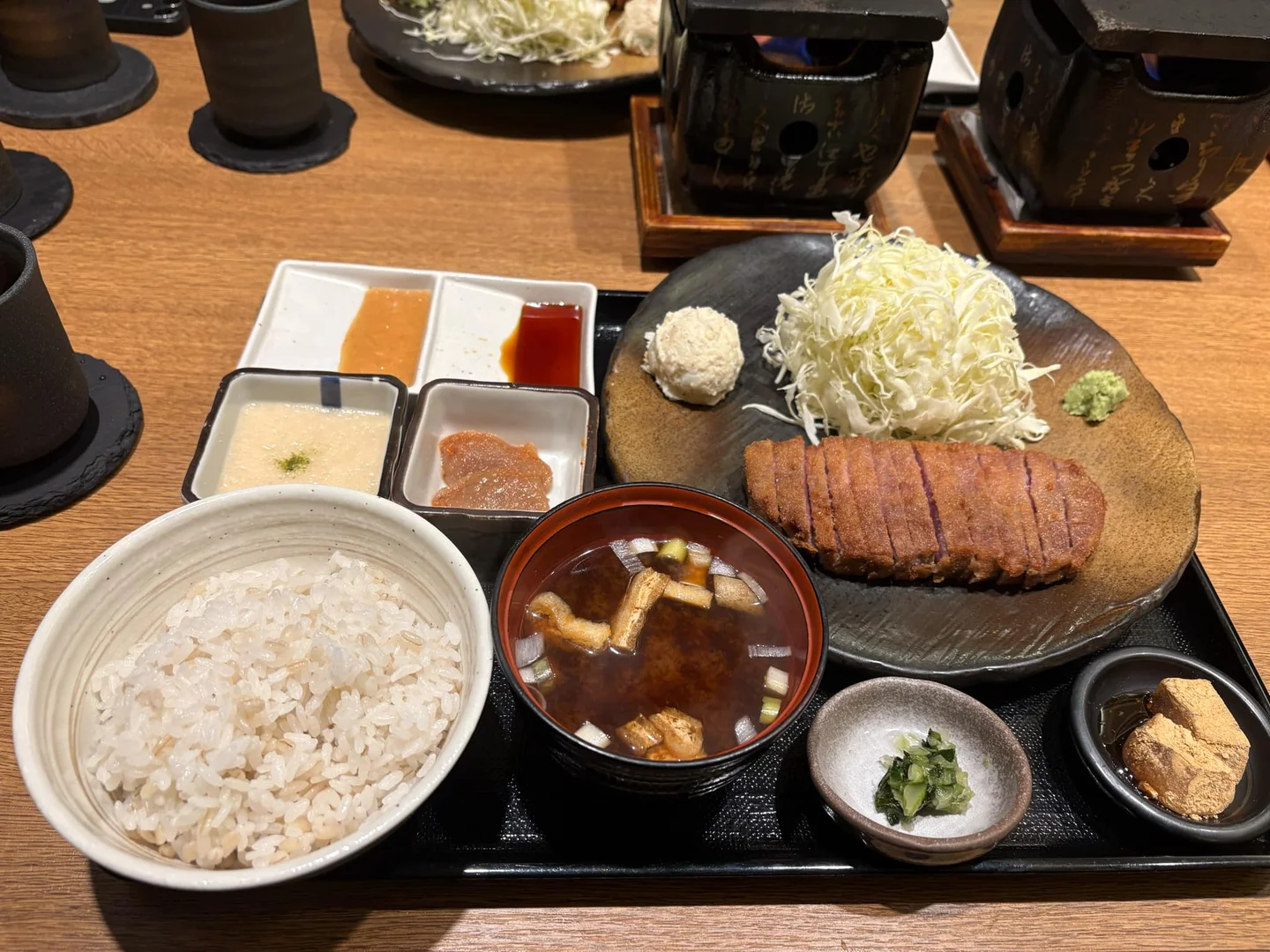
We ordered a Gyukatsu set, which is a breaded and deep-fried beef cutlet served with:
- A side of rice
- Red miso soup (slightly stronger than your typical miso soup)
- Shredded cabbage
- Grated yam (Tororo)
- Warabimochi (sweet Mochi like dessert from the Kansai region)
- Various sauces and condiments
One of the best things about Japan is that you get wasabi with (almost) everything. Given I'm always getting like 3 extra packets of wasabi whenever ordering sushi in Australia, I was a happy boy. 😍
The gyukatsu we had was prepared raw, so you could cook it the way god intended (medium-rare) on a hot stone until mouth-wateringly juicy — what a great way to start our trip! 😏
After our lunch we set out to adventure around Akihabara electric town, where we admired the unique architecture, bright fluorescent colours and bustling atmosphere — this is the central hub for anime, manga and gaming culture in Japan, we made sure to make the most of it and stop along the endless rows of manga, retro gaming & anime shops along the way.
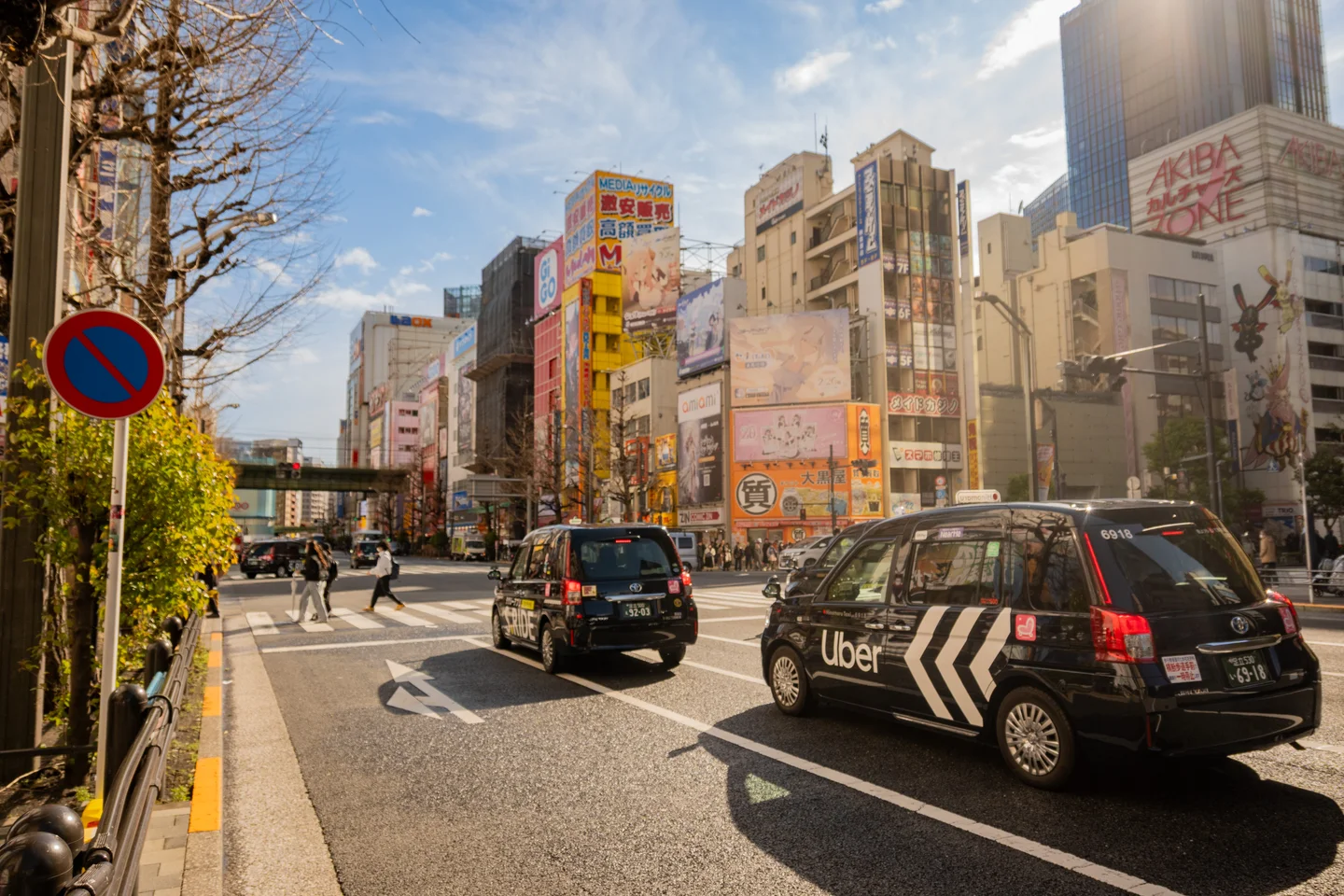
The weather was finally starting to clear up, and even the sun was coming out to say hello, so I did what any good tourist would do and I took some photos of unique streets and buildings around me — I even managed to snap a photo of some little tiny Uber cars driving around.
I didn't know it at the time, but these little cars are actually fully licensed taxis in Japan. They are called "JPN Taxi" and are designed to be compact, accessible (for its aging population) as well as efficient for navigating the narrow streets of Japan — fun fact, they were also designed after London's black cabs. 🚕🇬🇧
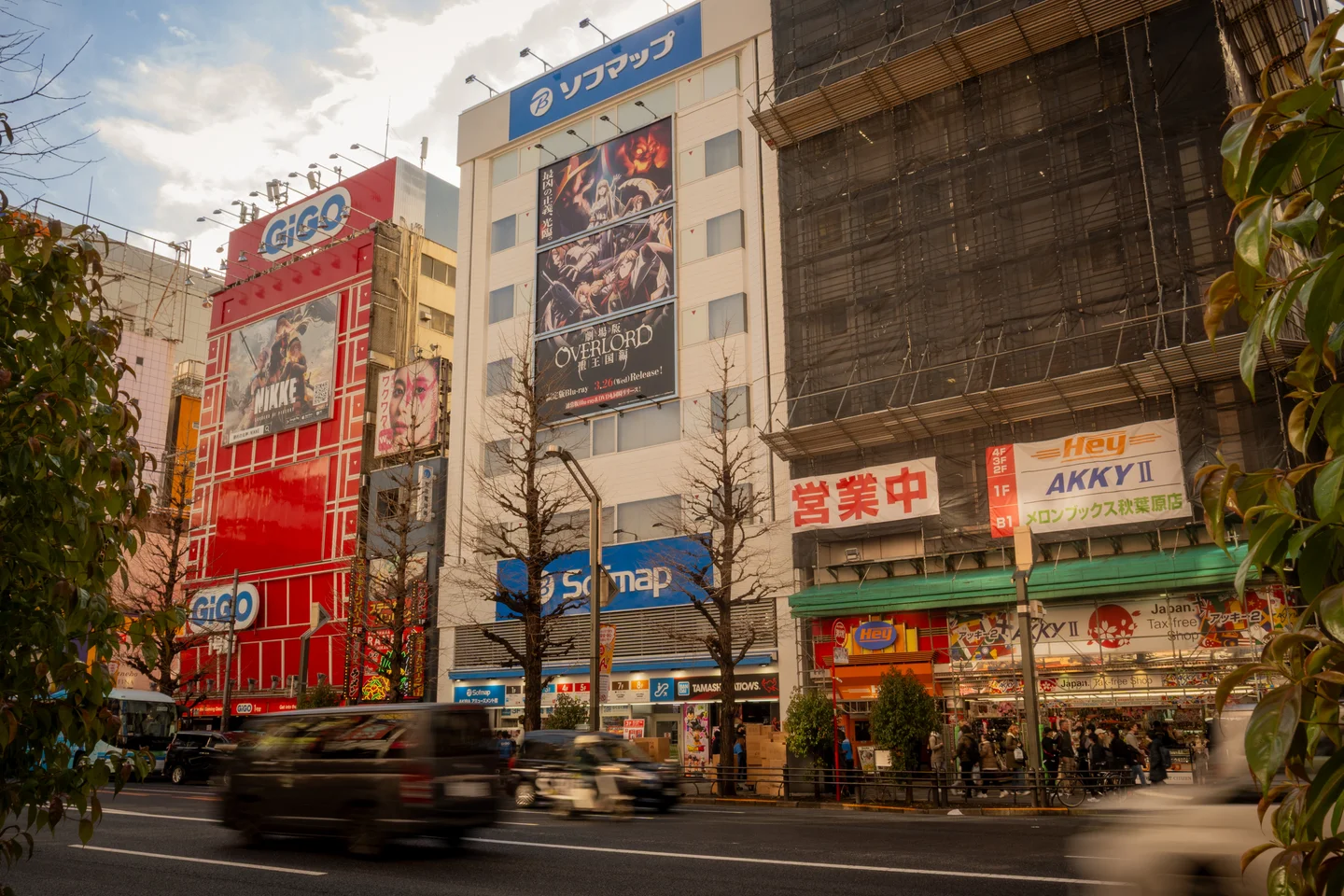
While making our way towards Don Quiijote, we stumbled spot one of the many GiGO around Akihabara, this one was GiGO Akihabara no. 4. It's a known popular arcade chain in Japan filled with arcade games and claw machines — claw machines being the main speciality of this particular store, ever since it was sold off by SEGA in 2020.
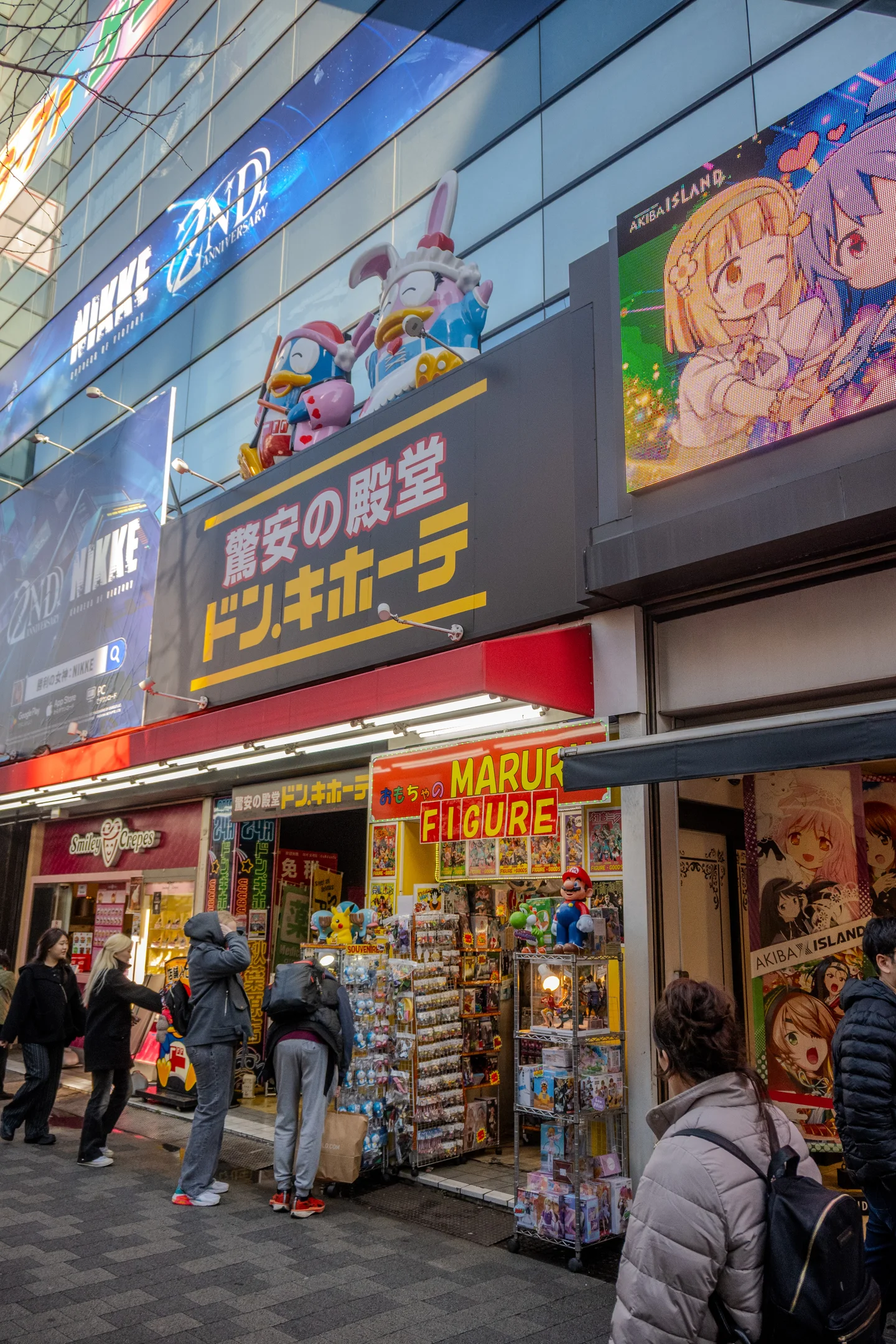
Finally we arrive at the main destination for the day, the famous Don Quijote store in Akihabara. We're greeted by the iconic yellow and red sign, and the store's mascots, a penguin named "Donpen" (ドンペン) with his pink companion "Donko" (ドンキョン) 🐧 — they're both symbols of the store's quirky and playful atmosphere.
We have a bit of a browse around the store, and I manage to find a few things that look pretty interesting, HEAPS of anime and manga merchandise across the eight total floors in the store. Ultimately though, we leave empty-handed as we didn't want to get too crazy on the first day of our trip, and we still had so much more to see! (Spoiler alert — we load up on goodies in Osaka anyway 🛍️😂)
With that out of our system, we head on back to pick up our luggage from the storage shop, and make our way back towards Akihabara station to get one last coffee fix, and a quick snack before heading to our hotel in Asakusa.
Our coffee shop of choice this time was Sarutahiko Coffee, a popular coffee shop in Akihabara right beside Akihabara station.
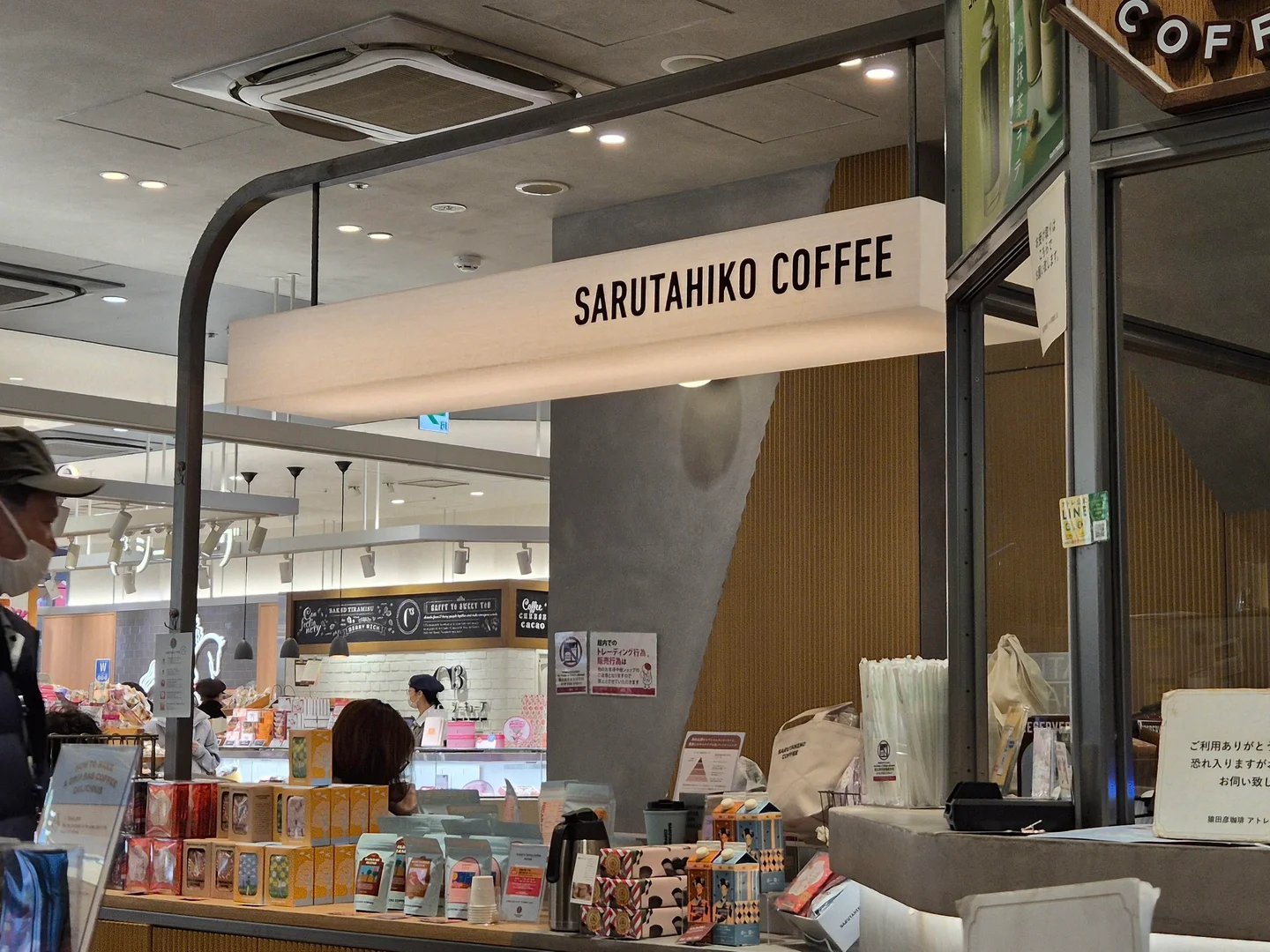
The final stop! We couldn't resist grabbing one of Cow Cow Kitchen's famous “Milk Pies” — a creamy Hokkaido milk-filled pastry wrapped in golden, flaky crust. 😏
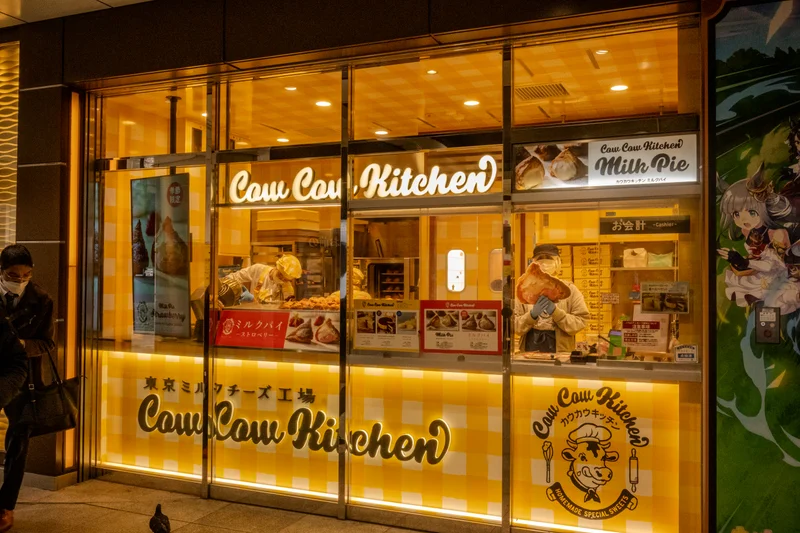
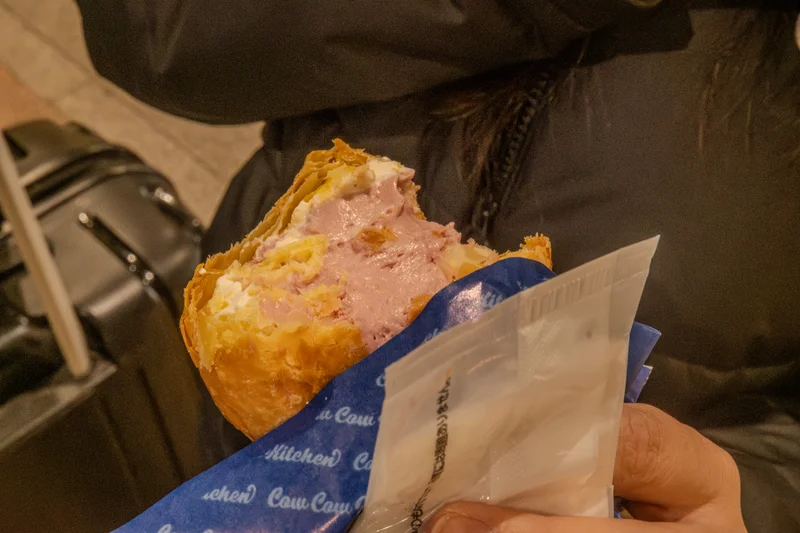
Safe to say... worth... every... bite. 🐮
Asakusa
We finally hop onto the train and make our way to Asakusa after a long day, on the way we see the Tokyo Skytree in the distance — we never do make it there, but it's still a landmark to admire and take in, plus I've got proof I was (nearly) there! 😅
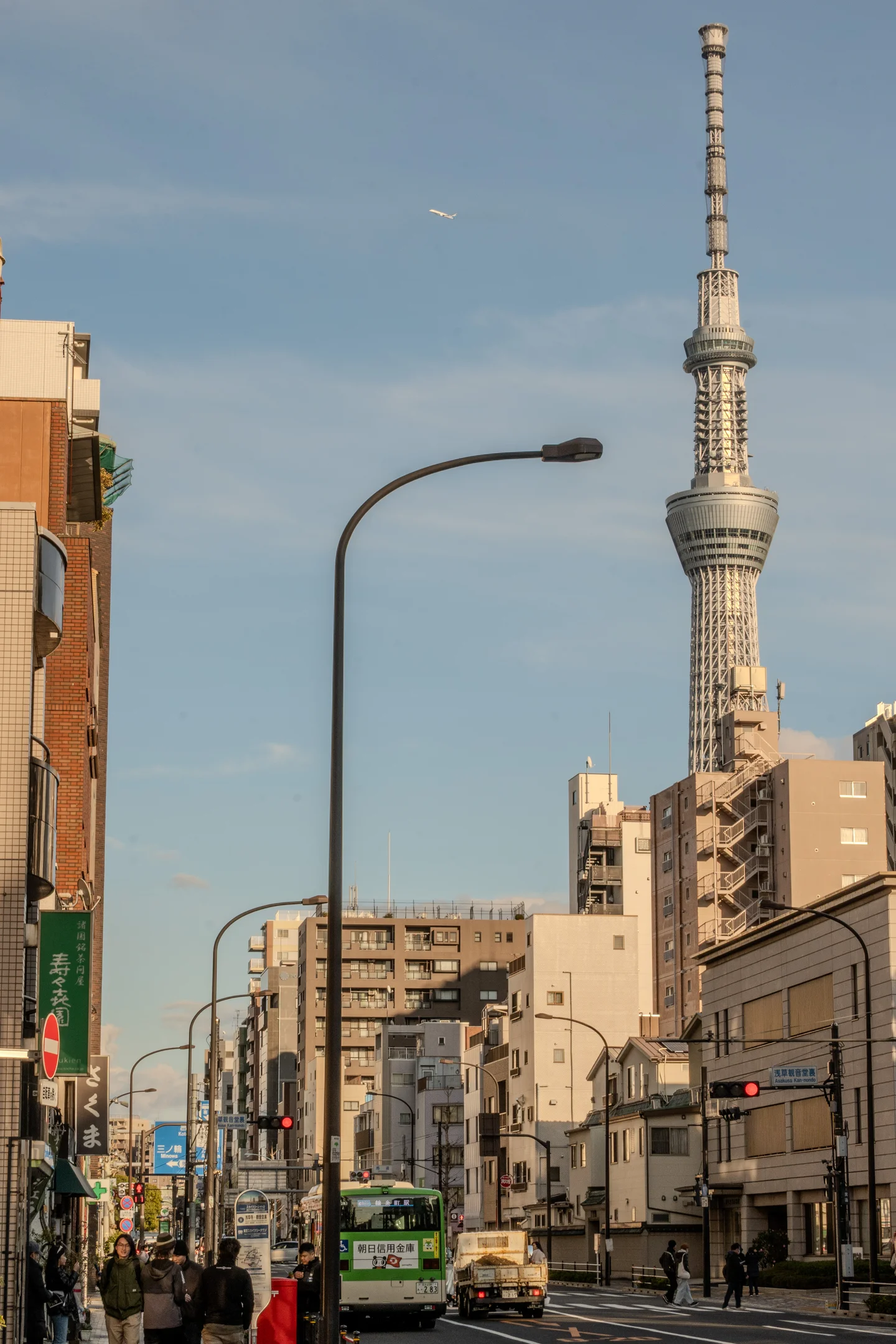
We make our way towards our hotel in Asakusa, a quaint little place called T-Hotel tucked away in a quiet seemingly residential area with plenty of non-descript little traditional Japanese restaurants hidden away. Many of these restaurants often do not take reservations or accept foreigners, as we were soon to find out! But more on that later... 😉
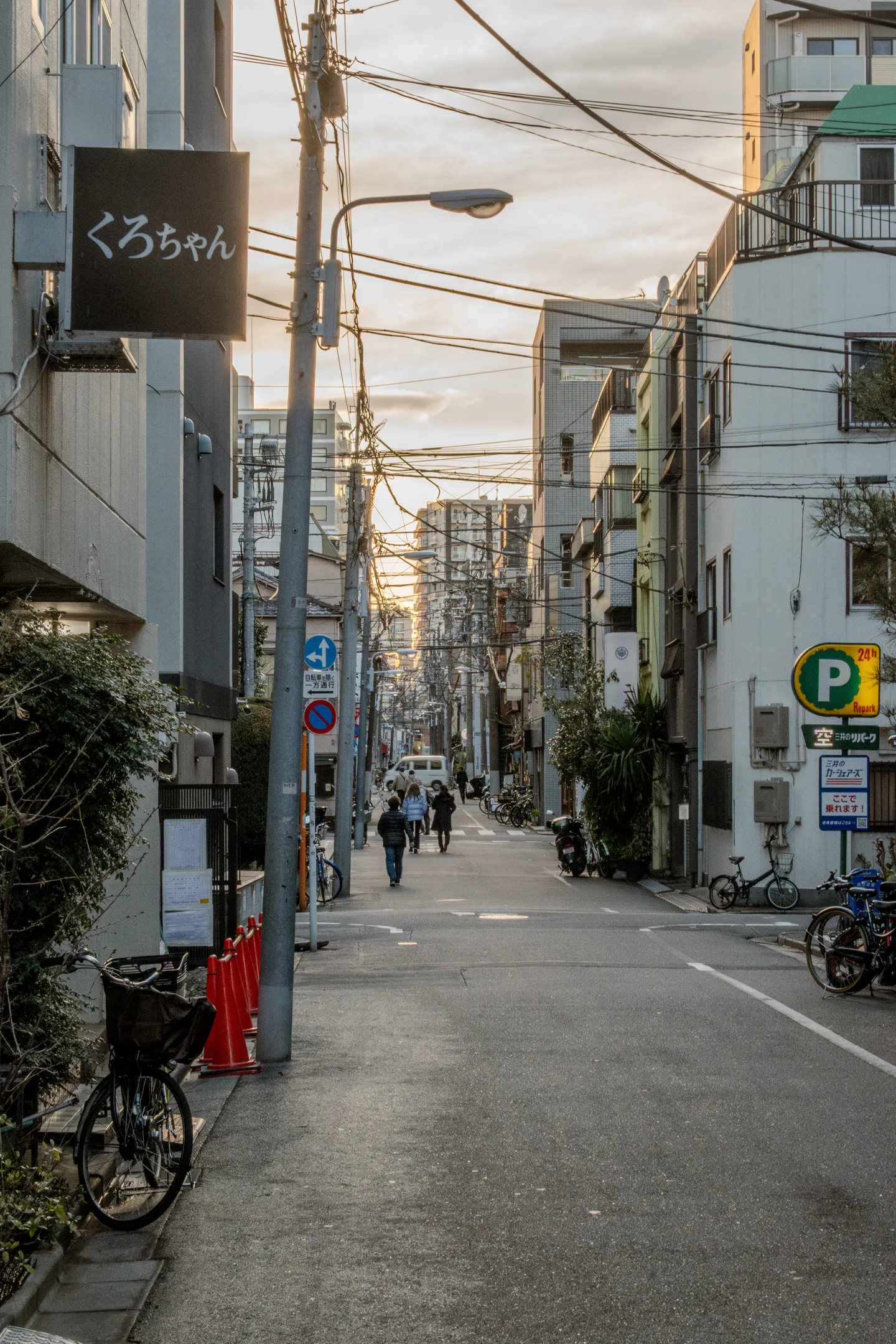
Coming face-to-face with our hotel, we see just how small things can really get in Tokyo. Even though it's 6 stories tall, the building looks like it's only about 5 meters wide.
The entire room was extremely narrow, with 2 rooms on each of the 6 floors, it was giving me the same vibes we had in Hong Kong with how compact everything was, albeit slightly more spacious when taking into account the bathroom... 😅
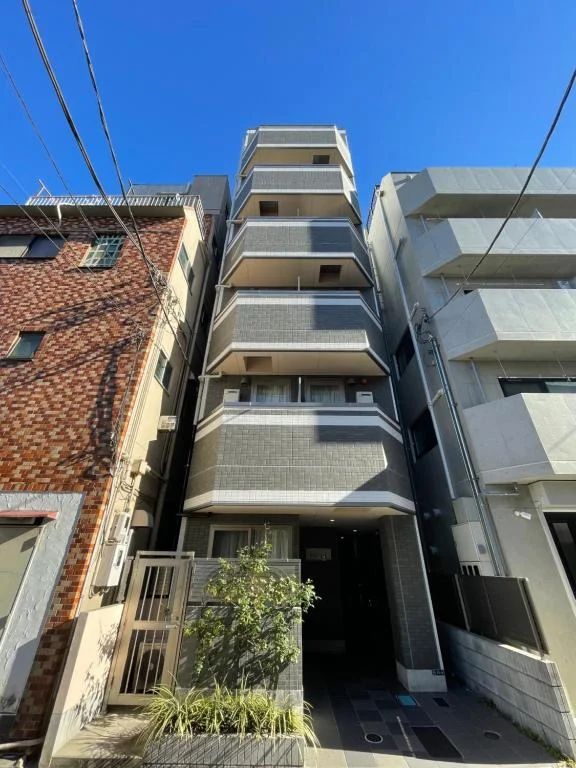

Senso-ji
Once we finish checking into our hotel, and taking a moment to rest our little feet, we throw our luggage into the corner and head out to Senso-ji Temple to have a look around the markets, and take some pictures before nightfall settles in.
Our hotel was conveniently about a 10 minute walk from the temple, making our first destination of the trip super easy to get to.

Crossing the road, we get our first glimpse of the main temple, it's referred to as Kannon-dō (観音堂) or Hondō (本堂) and it is the main hall of Senso-ji Temple, which is dedicated to the bodhisattva Kannon (観音), the goddess of mercy and compassion.
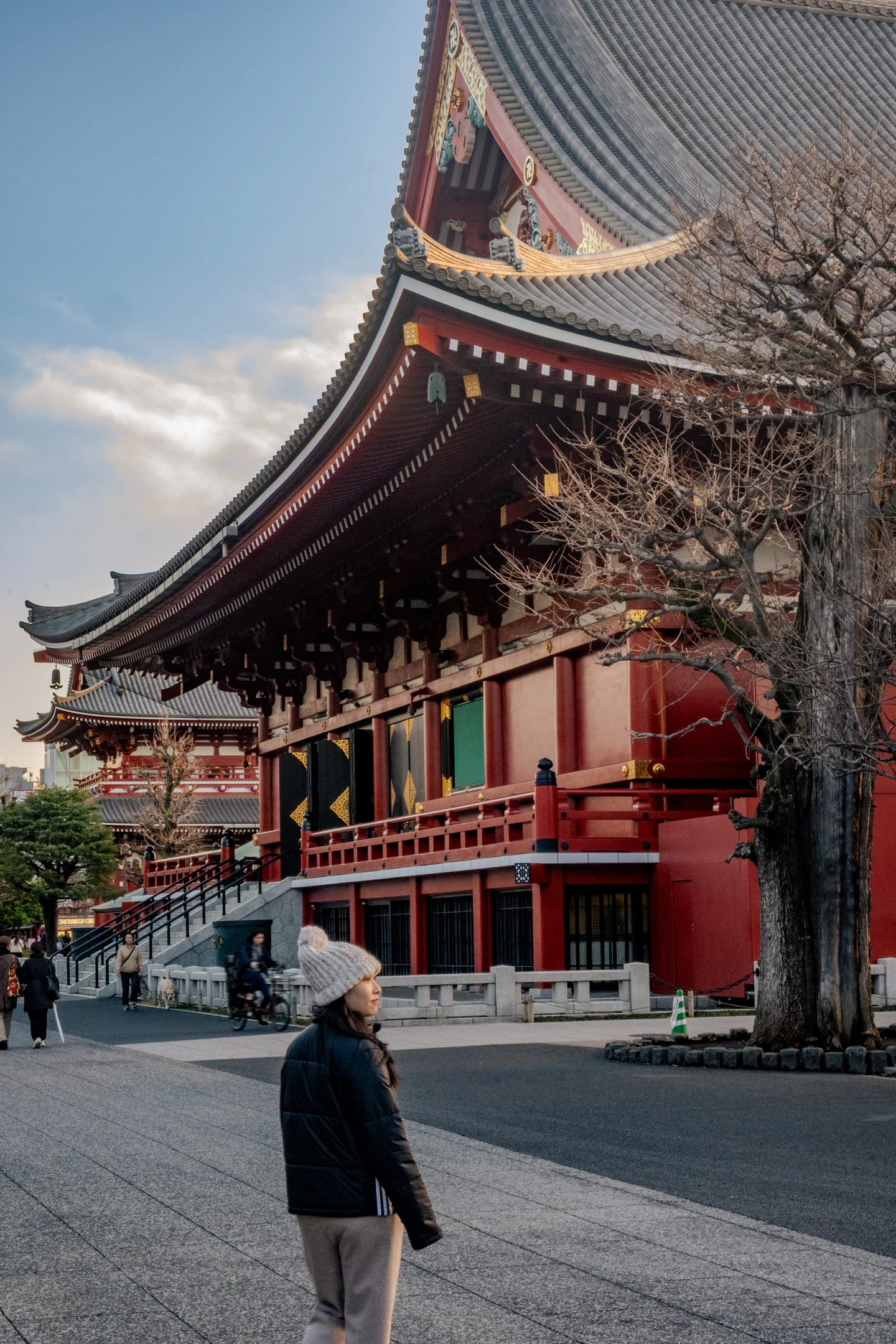
Often in travel videos and photos you just see the main shopping street with the gate pictured in the background, but what you don't see is just how large the entire temple complex really is, with the main hall being surrounded by a large courtyard and many other smaller shrines and buildings scattered around the area.
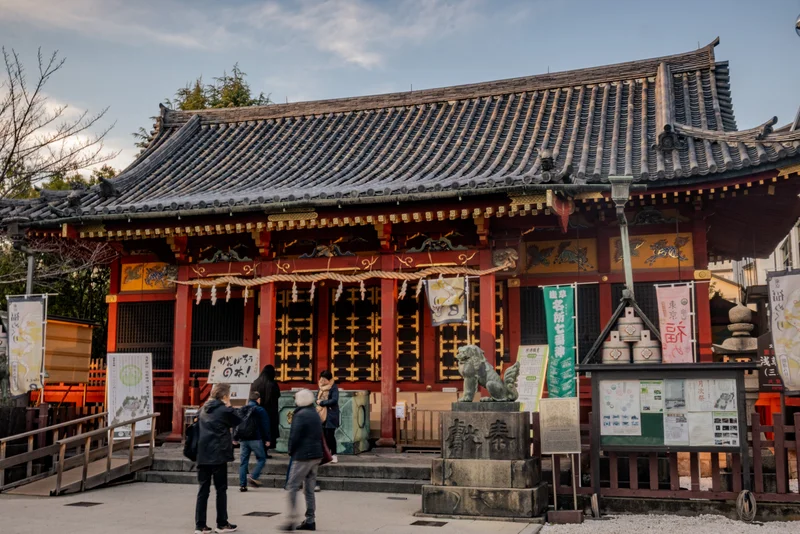
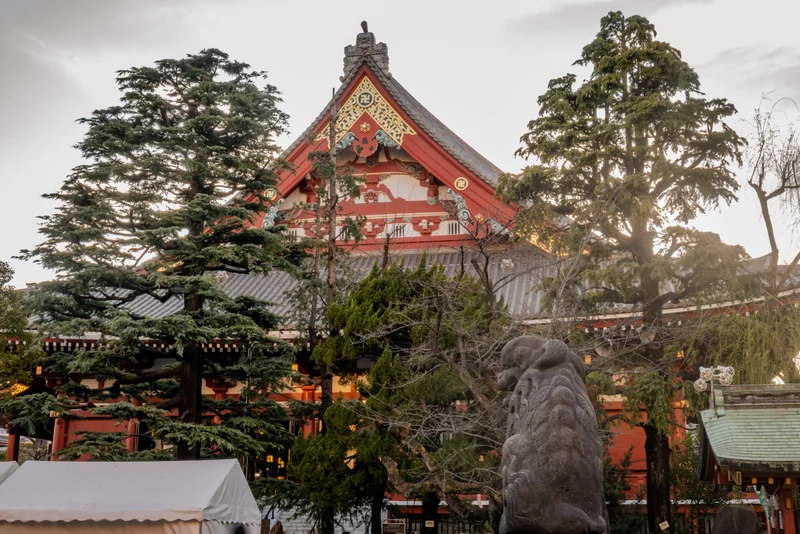

A short walk from the main hall, we also stumble to a very small shrine called Asakusa Shrine (浅草神社), which is a Shinto shrine located within the Senso-ji Temple complex.

Heading on over towards the inner temple grounds facing the main hall, you can see the giant washi paper lantern hanging from the roof which sits directly in front of the offering boxes, where you can throw in a coin(s) and make a wish. Generally you would also bow and clap your hands twice, and finally bow once more to show respect to the gods.


Hōzōmon Gate, meaning "Treasure House Gate," serves as the imposing inner gate of Sensō-ji Temple, positioned between Nakamise-dōri and the main hall. Originally built in the 10th century and reconstructed multiple times, the current reinforced concrete structure dates to 1964 after being destroyed in World War II. The gate is architecturally more imposing than Kaminarimon, featuring thicker pillars and housing the temple's sacred texts and treasures on its second, which is how it earned its name "Treasure House Gate".
The gate is accompanied by two massive Niō guardian statues (Kongōrikishi) symbolizing protection against evil, while a large red chōchin lantern bearing "Kobunachō" (小舟町) hangs above the central passage, donated by the town of the same name. Two bronze lanterns sit on either side, and behind the gate hangs a large waraji (straw sandal), traditionally believed to ward off evil spirits. This fortified entrance serves as the symbolic threshold between the commercial bustle of Nakamise street and the sacred temple grounds.

As we stroll through the iconic Hōzōmon Gate, we cross into the famous Nakamise Shopping Street (仲見世通り), a vibrant and bustling street lined with shops selling traditional snacks, souvenirs and crafts.

With the sun setting and stores closing soon, we decided to soak in the atmosphere of one of Japan's oldest shopping streets, saving the shopping for later. Dating back to the 12th century, this 250-meter path leading to Sensō-ji Temple was bustling with crowds — a classic part of the cherry blossom season experience in Japan. 😅
The street blends tradition and modernity, with Edo-style wooden shopfronts mixed alongside bright neon signs, making you feel like you've stepped back in time. While it felt a bit touristy, we enjoyed the unique vibe. A few shops were crafting traditional Geta (下駄) sandals and selling Yukata (浴衣), but most were geared towards snacks and souvenirs—it's a bit of a known tourist trap, but it was still cool to walk through it from start to finish.
Making our way through to the end of Nakamise Street, we finally arrived at the iconic Kaminarimon Gate

Kaminarimon Gate, or "Thunder Gate", stands as the iconic outer entrance to Sensō-ji Temple and ranks among Tokyo's most photographed landmarks. Originally built in 941 AD and relocated to its current Asakusa location in the early 17th century, the gate features a massive 3.9-meter tall red lantern weighing around 700kg, displaying the characters "雷門" (Thunder Gate). Standing inside the gate are statues of Fūjin (god of wind) and Raijin (god of thunder), symbolizing protection and good fortune.
The famous washi paper lantern, stretched over a bamboo frame, gets replaced approximately every ten years due to weathering and is temporarily lifted during festivals to allow tall floats to pass underneath. Kaminarimon stays busy throughout the day as a common meeting point for tours, and continues to stay busy late into the evening as Nakamise street comes alive, serving as a beautiful backdrop for photos when illuminated against the night sky. The gate serves as a gateway into the bustling heart of Asakusa with many shops and stalls nearby, and providing access to other strees and laneways.
Doing a quick 180° turn, we find ourselves on Kaminarimon-dori Street, the main street leading from Kaminarimon Gate to Sensō-ji Temple. As you walk down this street, you'll spot the iconic Asahi Breweries headquarters building with its famous "Golden Flame" sculpture on its roof, often humorously referred to as the "Golden Poo" (金色のうんこ) by locals. 💩

The street is lined with various shops, restaurants, and stalls, making it a great place to explore if you're hunting for souvenirs, local snacks, or a place to grab a bite to eat.


Much of the architecture along the street is traditional, with wooden shopfronts, lanterns and the occasional rickshaw with passengers being pulled along the street by a local guide — it's a great little place to explore at night, with the mix of both traditional and modern architecture really capturing the spirit of Asakusa.
As we walk through Nakamise Street, we notice that there's actually a few shopping streets that connected to it, one of which is the (very long) Shin-Nakamise Shopping Street, which we didn't know at the time, but would be coming back through here the next day to grab some breakfast and taiyaki! 🐟
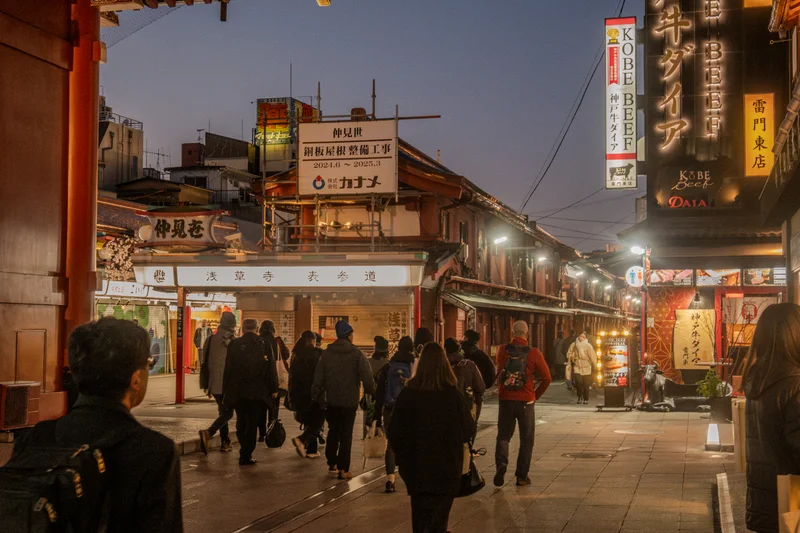
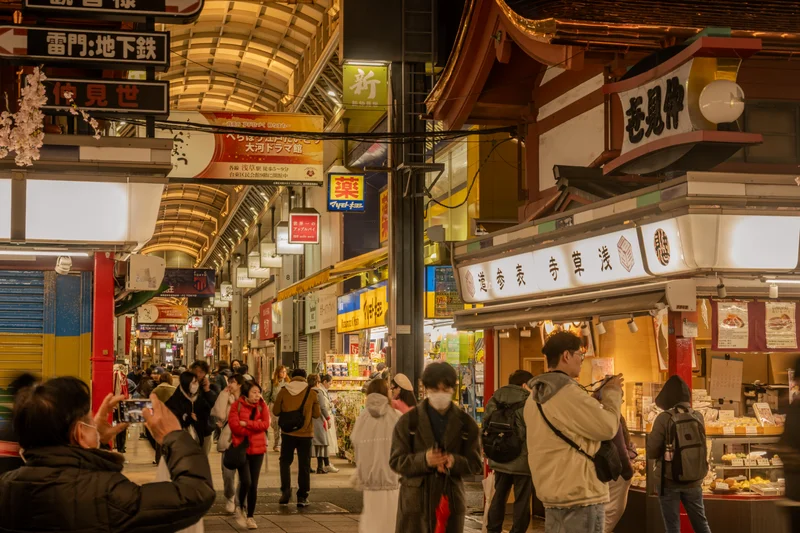
We take the chance to get some night-time photos of the main hall and Hōzōmon Gate, which light up beautifully at night against the surrounding buildings caught in the shadows of the night sky.


We were originally thinking of having dinner at one of the traditional Japanese izakayas nearby, our first night of looking for a restaurant in Asakusa was a bit of a challenge though, we got the "Gaijin" (foreigner) treatment at a few places, where they either didn't want to serve us or were "fully booked" out. So we fallback to Plan B as the sun had well and truly headed to sleep by this point... 👇
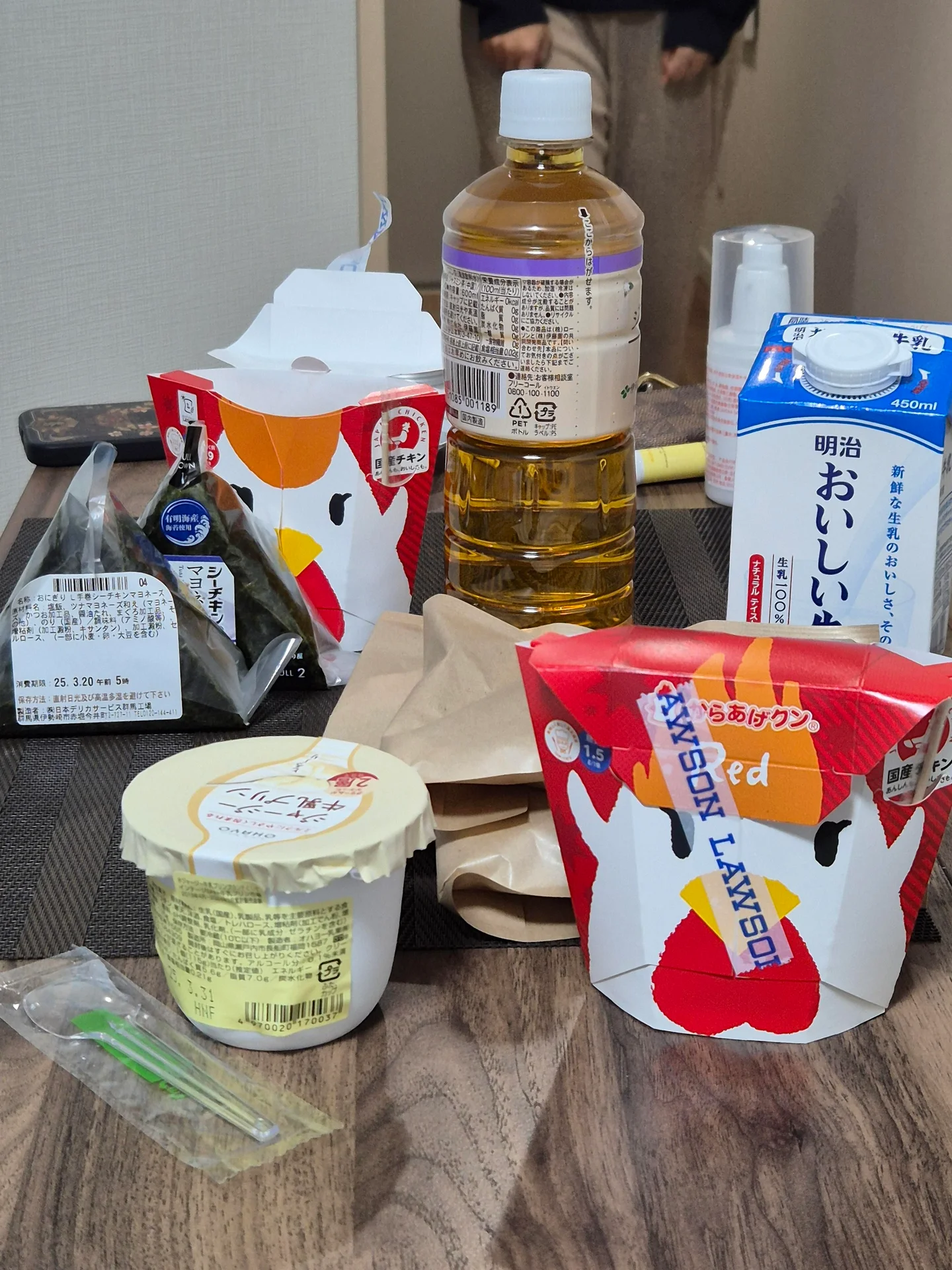
Ya'll already know I'm about that konbini life! In the end, we made a beeline for the nearest Lawson and loaded up on the essentials... Fried chicken, onigiri (rice balls), and a dangerously creamy pudding for dessert. Honestly, nothing hits the spot after a long day of exploring like a late-night konbini haul. With a full stomach and zero regrets, I was out like a light before I could even finish any more pudding... 😴
Team Lab Borderless
Before heading out to our main destination of the day, we head out on an adventure to find some breakfast in Asakusa.
We venture down to Orange Street, a hidden gem in Asakusa, known for its retro Showa-era charm and local atmosphere — you'll find fewer tourists around here, with more locals shopping around, and enjoying the local cafes. It's only a short walk from Senso-ji Temple, making it a great place to start your day before heading to the other parts of Tokyo.
We ended up strolling past a small taiyaki shop called Naruto Taiyaki which is famous for its fish-shaped cakes filled with sweet red bean paste, though you can also get them filled with custard, chocolate, or other fillings — it was nice to start the day with something sweet and warm! The word "Taiyaki" literally means "baked sea bream" in Japanese, as the shape of the cake resembles a sea bream fish. 🐟
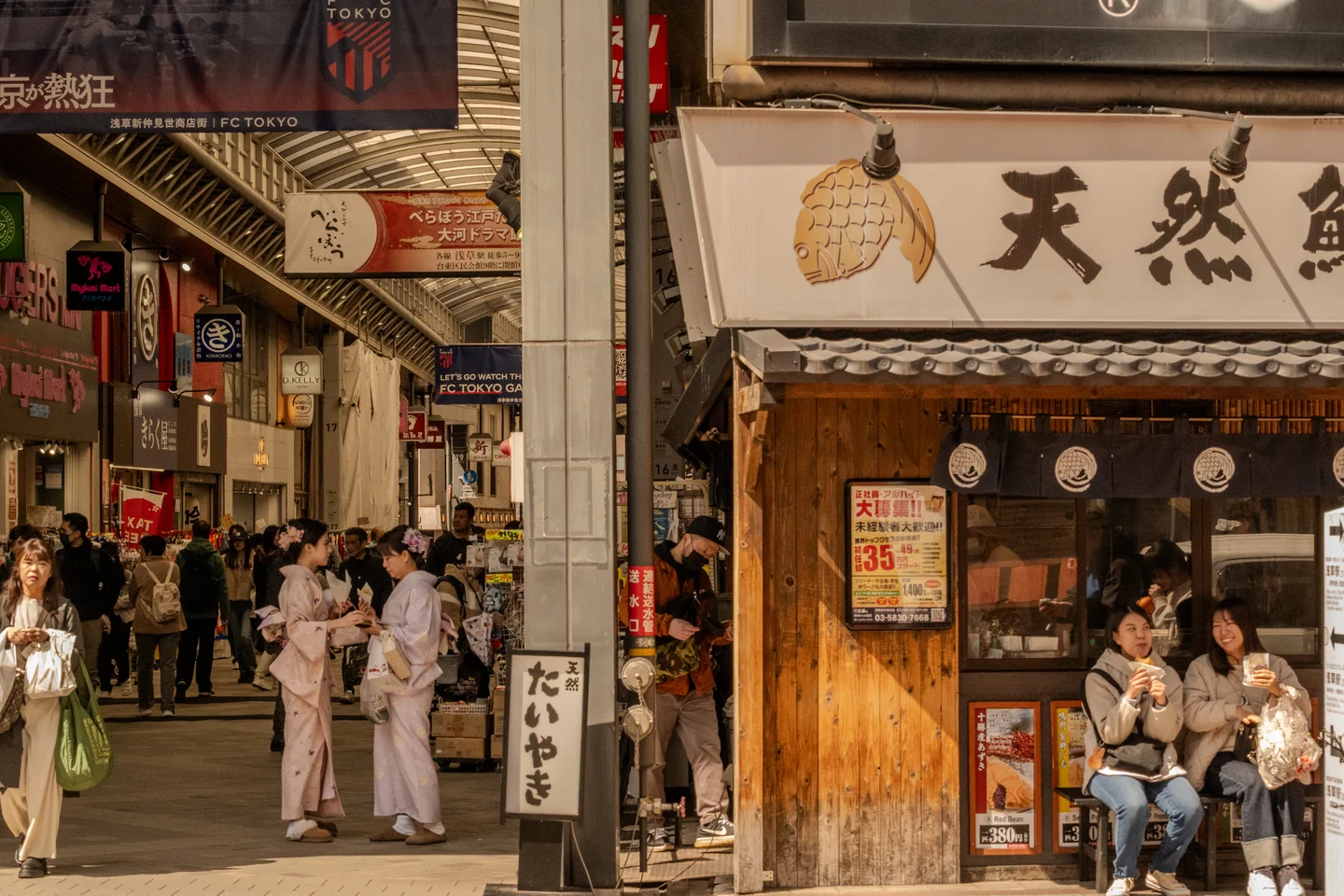
The final result, a delicious fish-shaped cake filled with sweet red bean paste, with the carbs and sugar flowing through my veins, I was ready to take wait in line for my next meal of the day... 😼
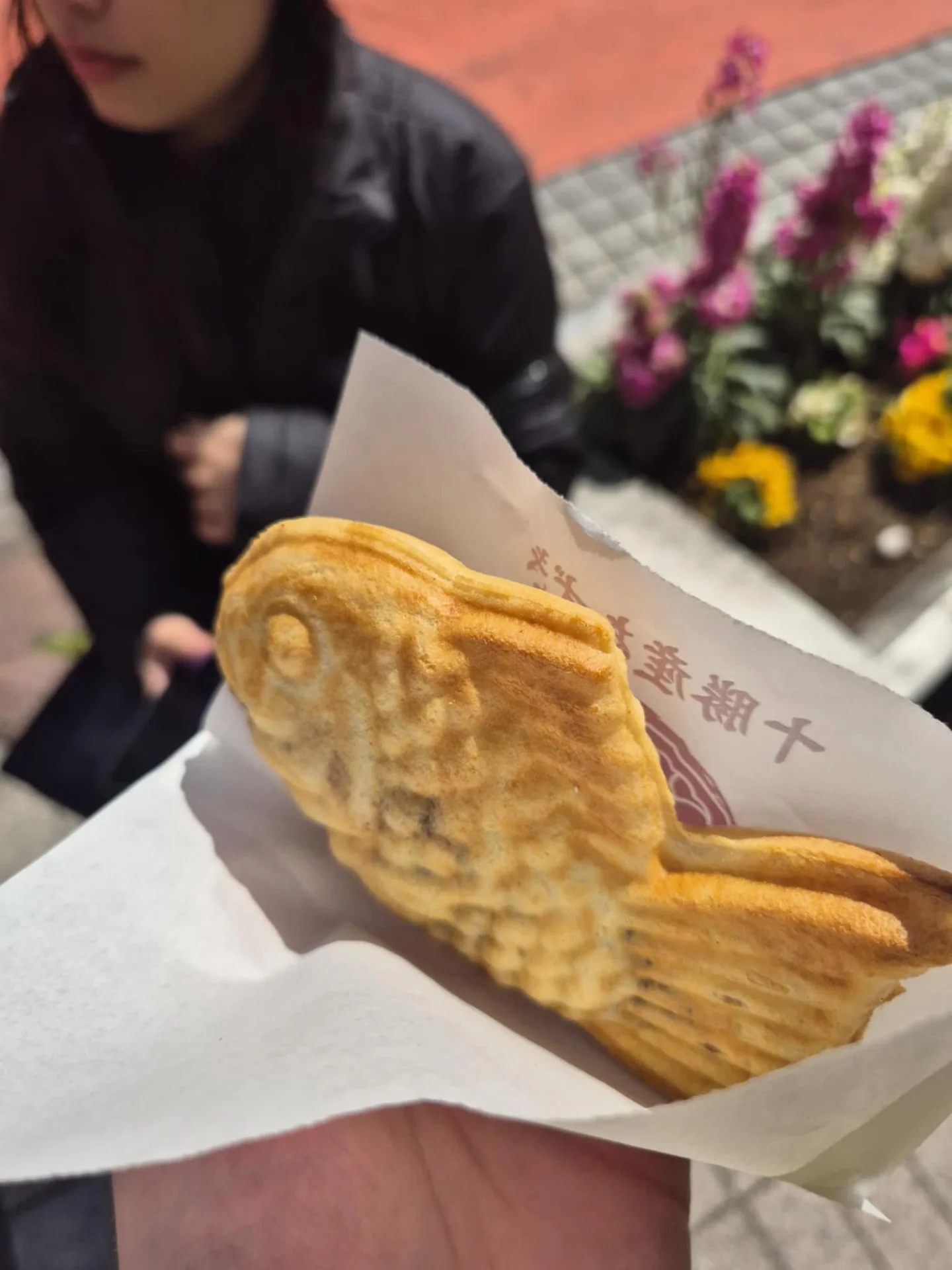
Making our way through Shin-Nakamise Shopping Street we find ourselves a discreet little cafe called Cafe Tomorrow Asakusa which is a classic kissaten, literally meaning "tea-drinking shop". It's Showa-era vibes and retro decor make it a time capsule back into the 80's, when the cafe originally opened. They traditionally serve coffee, tea, light meals and desserts, and are well known for their cosy and relaxed atmosphere where you can enjoy a leisurely break from city, and the huge amounts of tourists engulfing Tokyo this time of year.
We enjoyed a cafe latte, with their famous Corn Mayo Toast which had a generous spread of sweet corn kernels mixed in with a generous swirl of mayonnaise on top of a Japanese levels thick, slice of toast, served with a side of soft scrambled egg, miso soup and a small shredded cabbage salad.
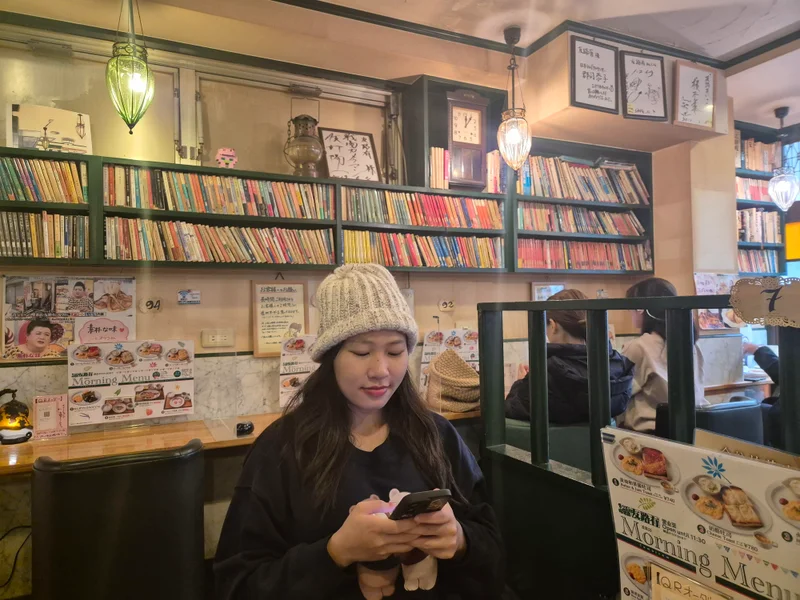

After finishing up breakfast, we got a wiggle on and got on our way to meet up with our friends who also happened to be in Asakusa at the same time, and would join us an our adventure for the rest of the day!
We hopped on the train towards Ginza, where we would venture out to have lunch at a popular gyūtan (beef tongue) restaurant called Negishi at Ginza 3-Chome. Navigating through the busy shopping streets of Ginza, we find the restaurant just off the main street, tucked underneath some stairs — there was a bit of a queue, but it moved quickly, and it was going to be worth the wait!

I end up going for the gyūtan set meal, which came with:
- Beef tongue slices
- Barley rice
- Mini curry (with small slice of beef tongue)
- Small green salad w/ Mayo
I of course had to get a lemon sour (lemon-flavoured shōchū) to wash it all down. 🍋 I would highly recommend trying it if you're in the area, it's a really unique blend of flavours, with the tender, smokey grilled beef tongue, paired with the nutty barley rice and the rich, slightly spicy curry sauce.
After refueling for the afternoon, we set off and hopped back on the train heading towards Kamiyacho Station, where we would take a short walk to Azubadai Hills, which is a pretty large shopping complex that also houses the famous Team Lab Borderless exhibition — our next stop!
Our friends did a bit of shopping before we headed into the exhibition, we even got a super freshly made chocolate chip cookie from one of the little shops inside! 🍪 With the sugar kick out of the way, and shopping done, we headed inside to grab our ticket and dive into some new worlds!

Walking through the winding hallways inside the exhibition, we were met with different themed rooms, each showcasing various digital art pieces that moved and changed over time. Some of them even responded to movement and touch, allowing you to feel like you were a part of the artwork itself.
The common theme throughout the exhibition was elements of nature, water, flowers and animals, all brought to life as you walk through the different rooms and corridors.
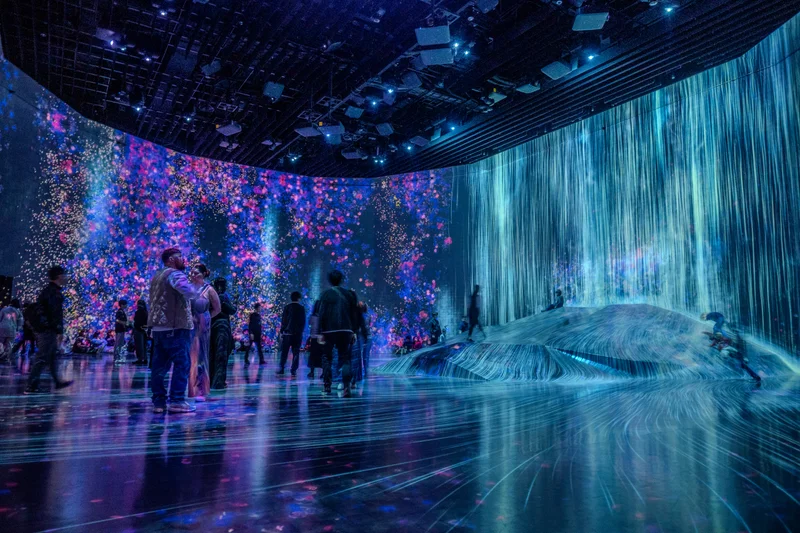
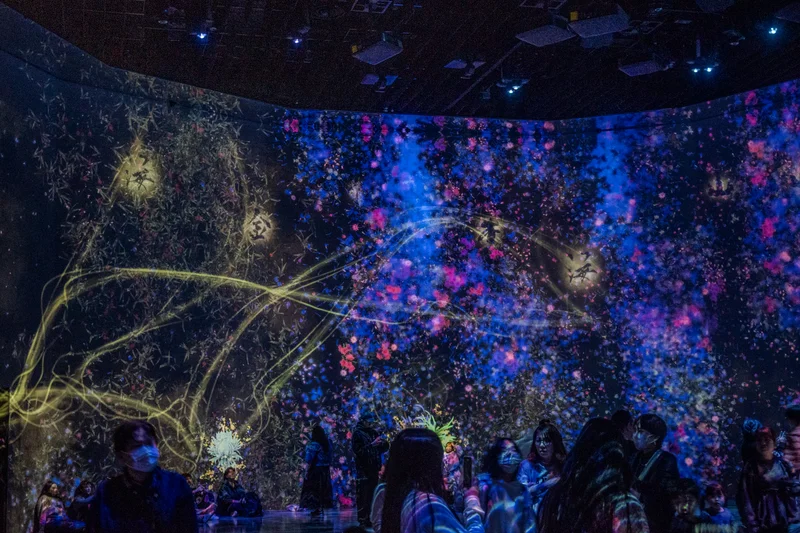
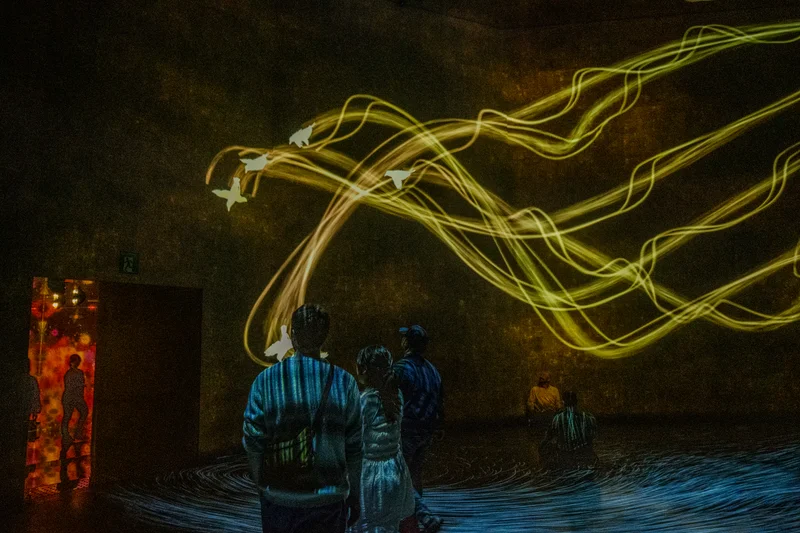
One of the most interesting things you can do in this particular Team Lab's exhibition is create your own sketches and have them scanned in, and brought to life on the walls inside the Sketch Ocean room, where if you're unlucky they might be swept up by one of the sharks patrolling the walls! The Japanese manga characters floating around are sure to remind you you're in Japan. 🤣

Entering into the Infinite Crystal World you really feel like you've stepped into a different dimension. There's an endless expanse of mirrors and lights stretching out in every direction, only broken up by a very small walkway created by the lights draped from the ceiling.
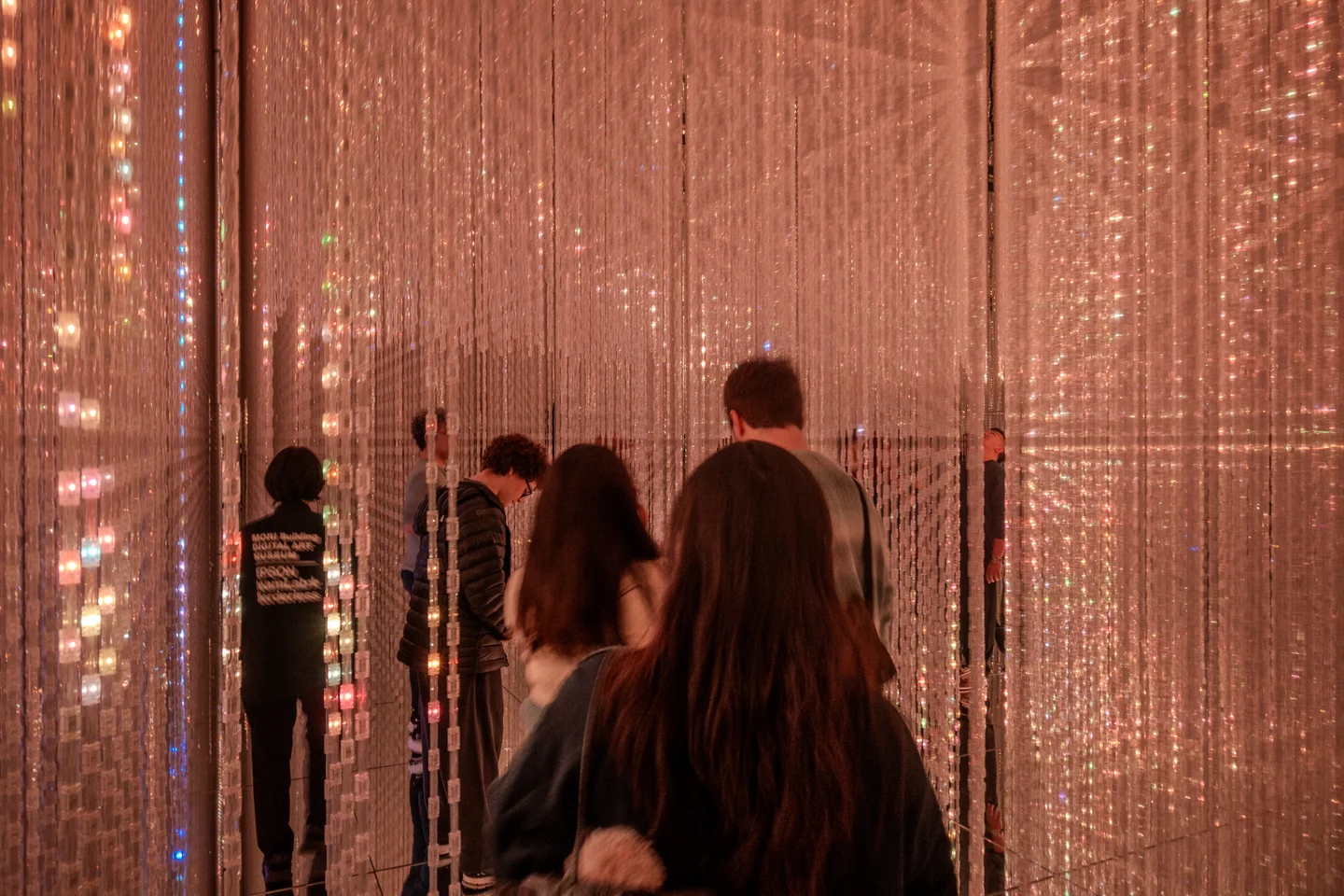
Making it out of the first section, you walk into a much larger room, also being an endless expanse of mirrors and the lights you walked through reflecting off every surface. Looking down at the floor, you can see yourself staring back at you! 👀
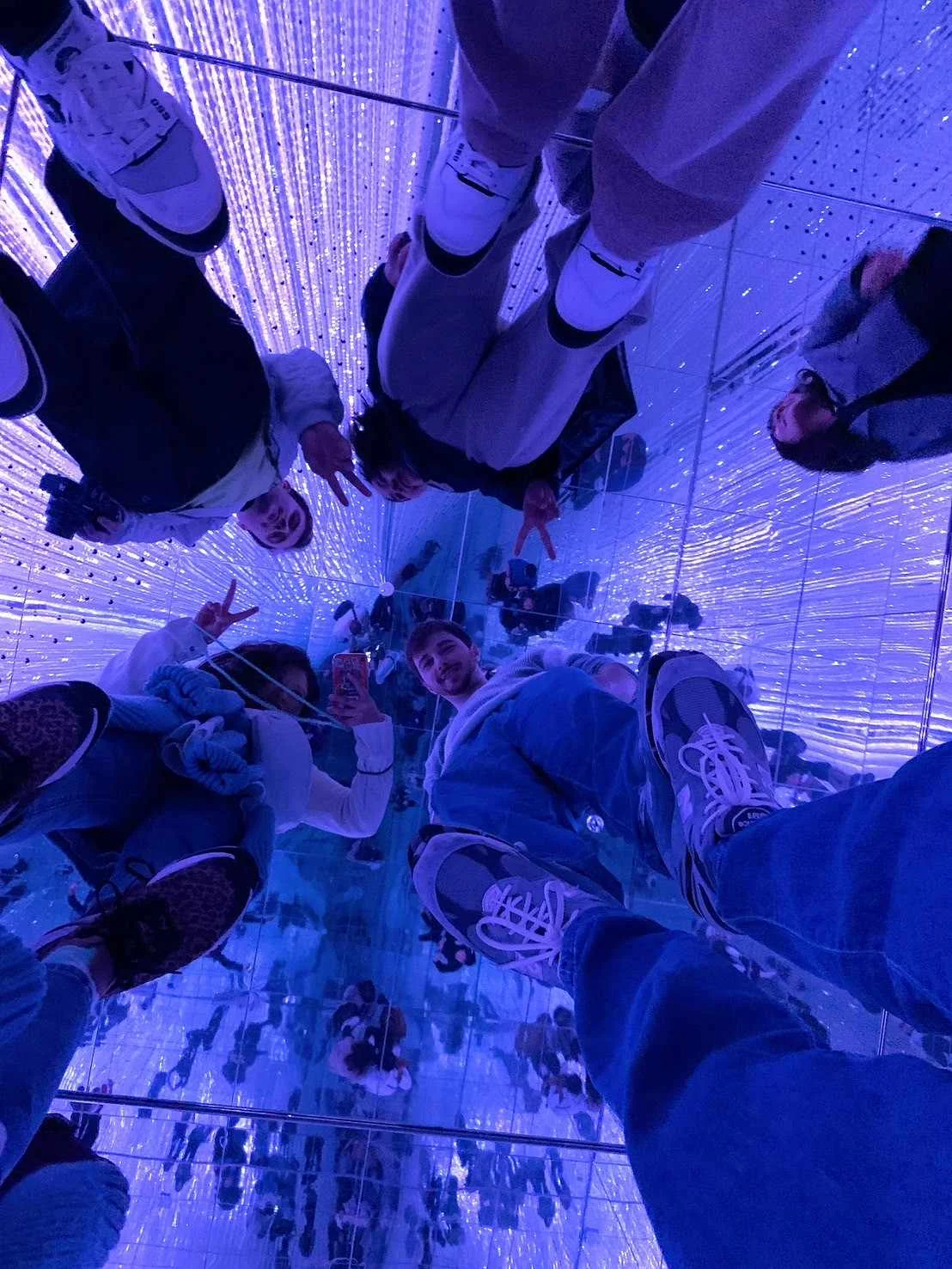
The next room was very similar and named "Bubble Universe", except this time it was filled with large, glowing balls of light that floated around the room, reflected off the mirrors all around you, making you feel like you're floating in a sea of bubbles. 🫧

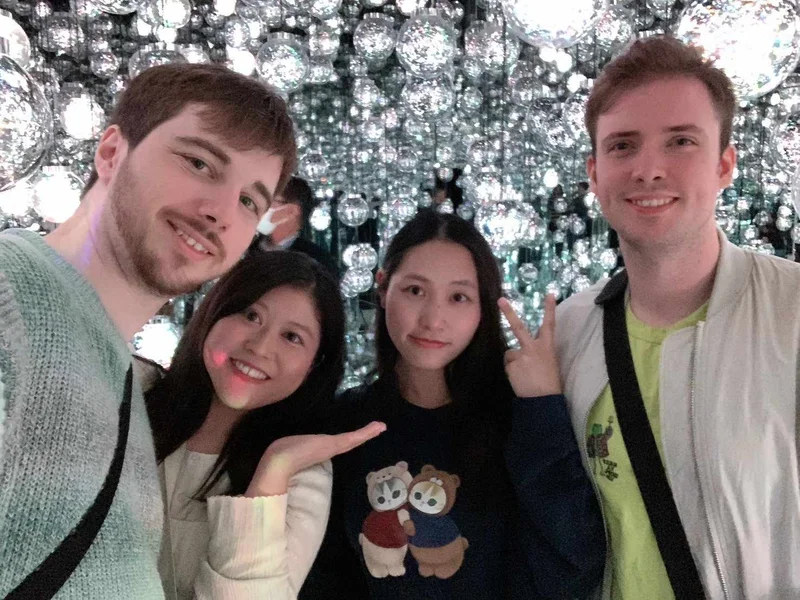
After playing in the proverbial bubble bath, we found ourselves in a different universe, this time one filled with cubes bigger than me! The cubes have blue streams of light flowing down them, and would react to you if you got close enough, moving and flowing around you as if you were water standing underneath a waterfall. ☂️
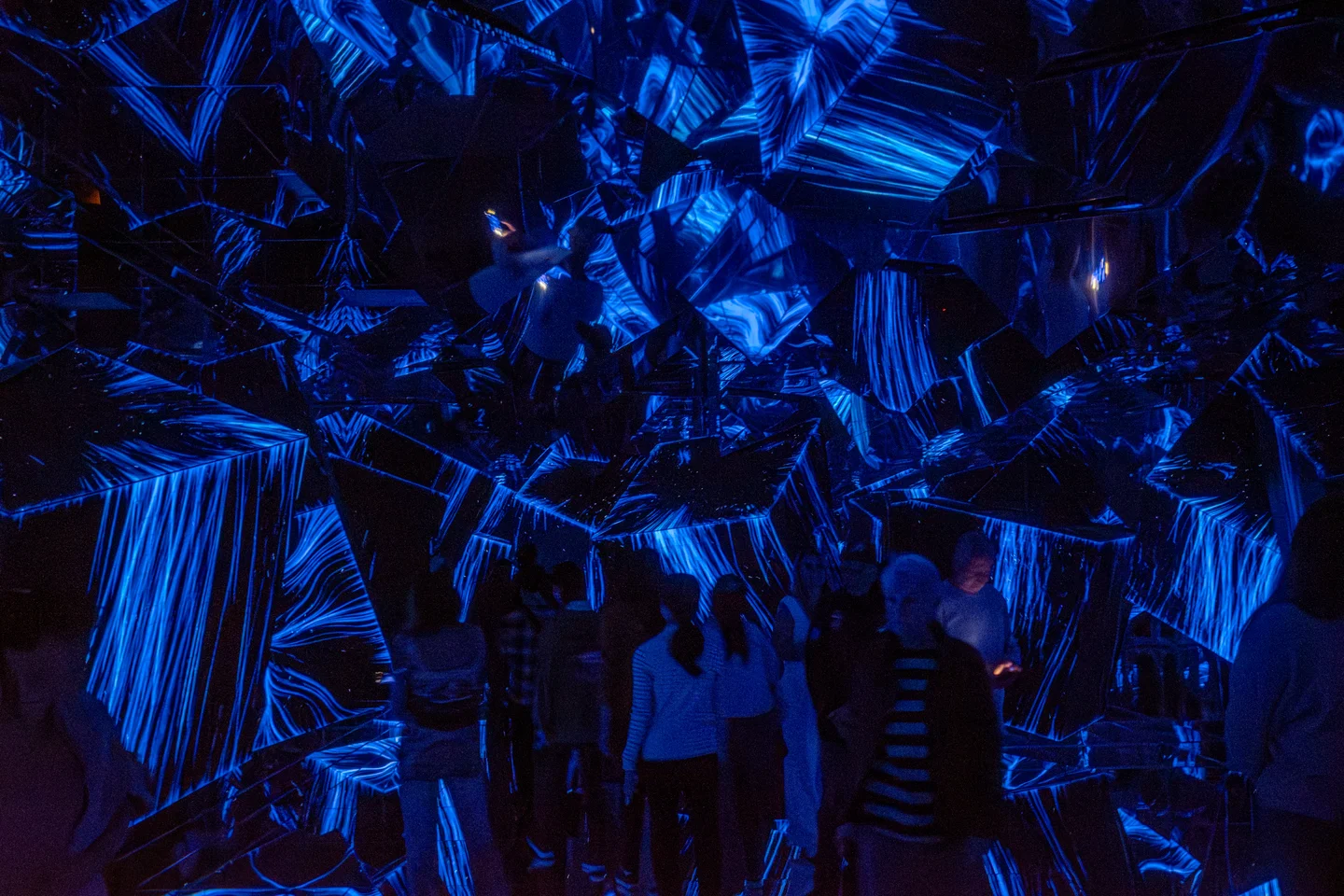
One of the other rooms we wandered into was filled with mist. There were projections of people (and animals? 🤔) with instruments playing music, it felt like you were walking into a dream. The dark room made it difficult to see where the walls ended, making it feel like you were stuck in a never-ending void of mist and light. 😶🌫️
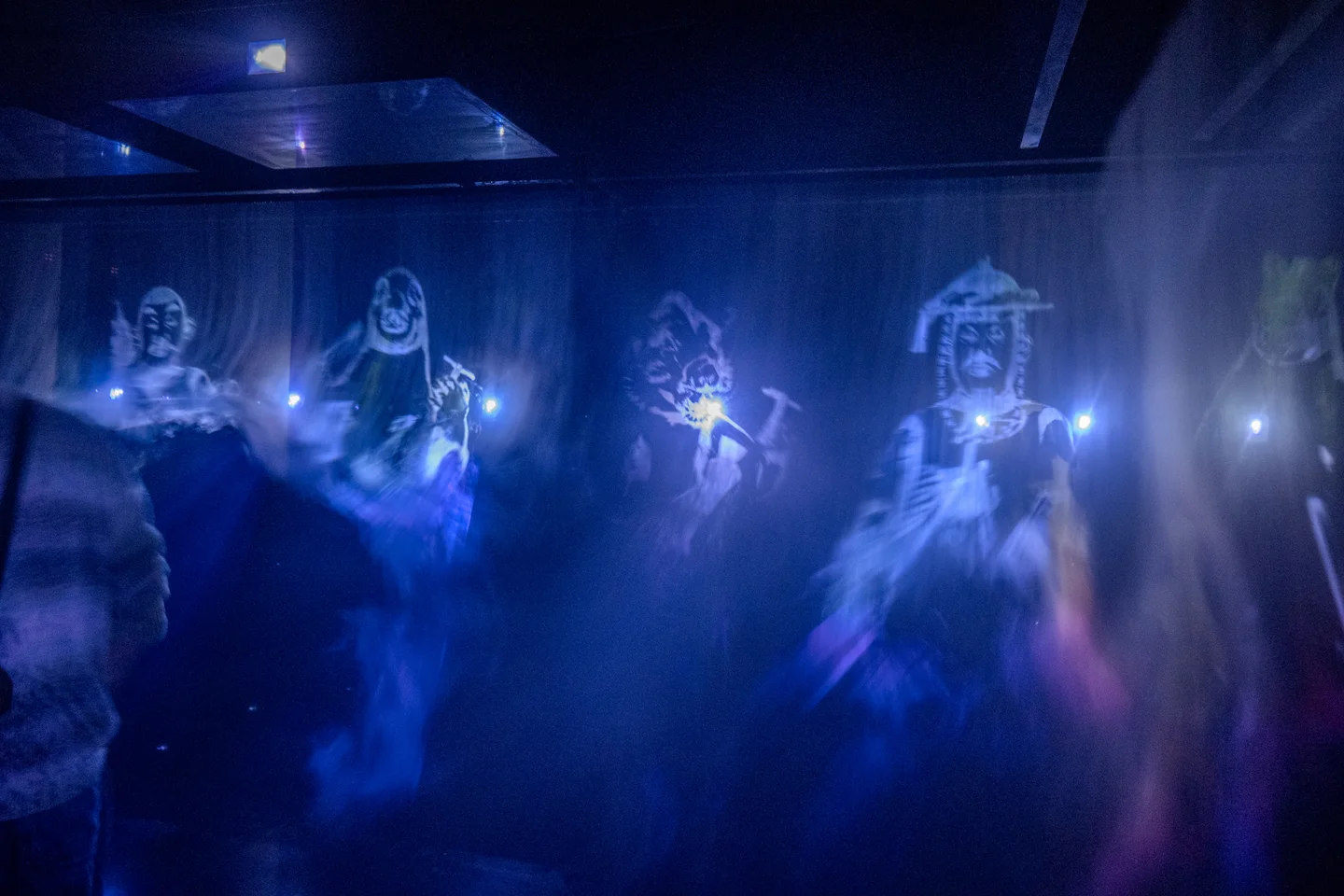
You can see it in motion in the video below, it's a super weird feeling when you first step into the room.
As we make our way closer to the end of the exhibition, we find a room filled wall to ceiling with a really interesting art piece. The feature being what looks like a giant tree log wrapped with various colours of snakes, all moving and writhing around the log in a hypnotic fashion.
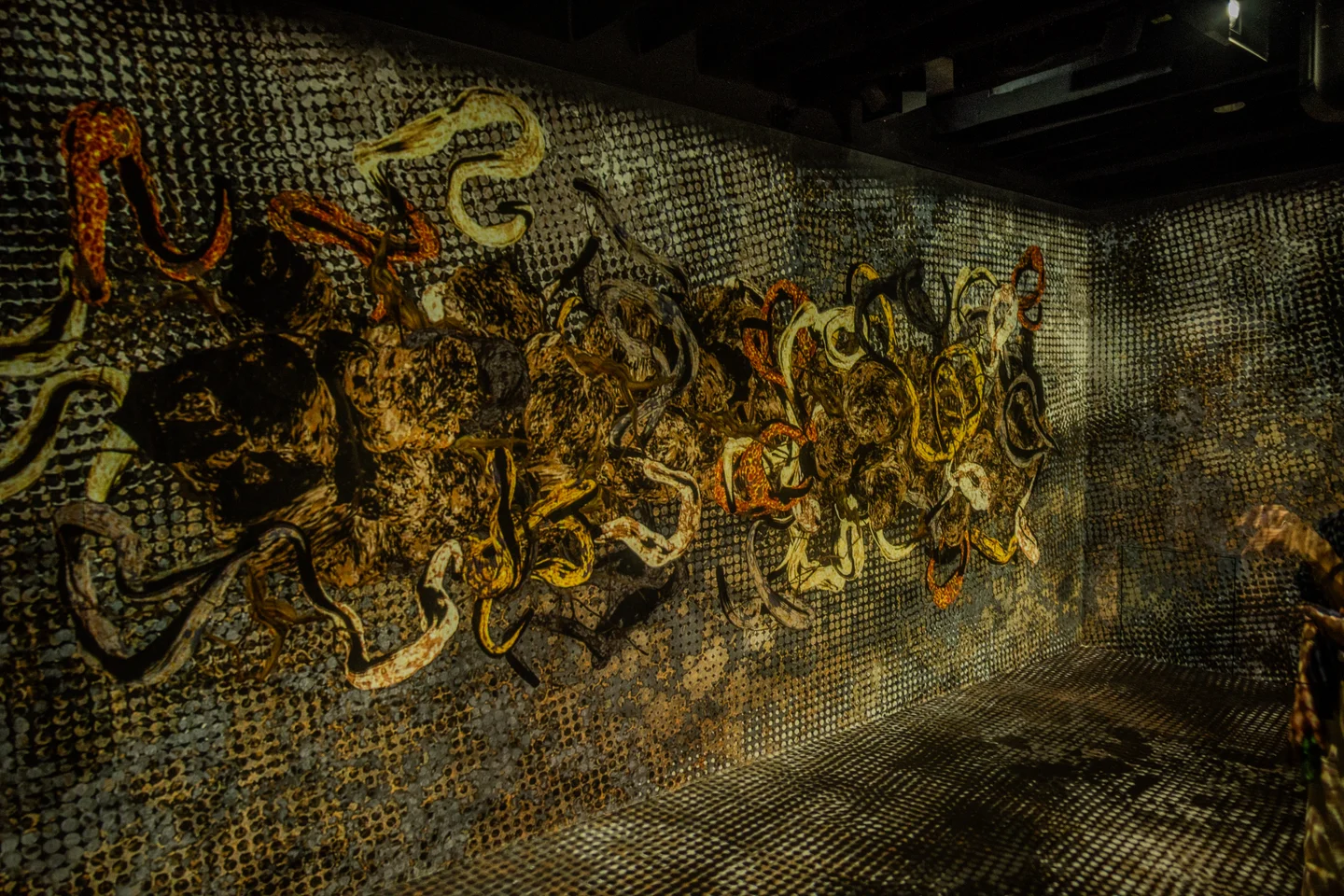
Walking around the corner, we walk our way to the exclusive Cafe EN TEA HOUSE which is a part of the Team Lab Borderless exhibition, but requires you to order your choice of tea before entering. You also had the option to pair specific teas with a milk gelato. We had to wait for our turn before we could take our seats, but the vibe inside was dreamlike, with soft music playing in the background, and what looks like a tea science experiment, being illuminated by a warm glow of different colours.
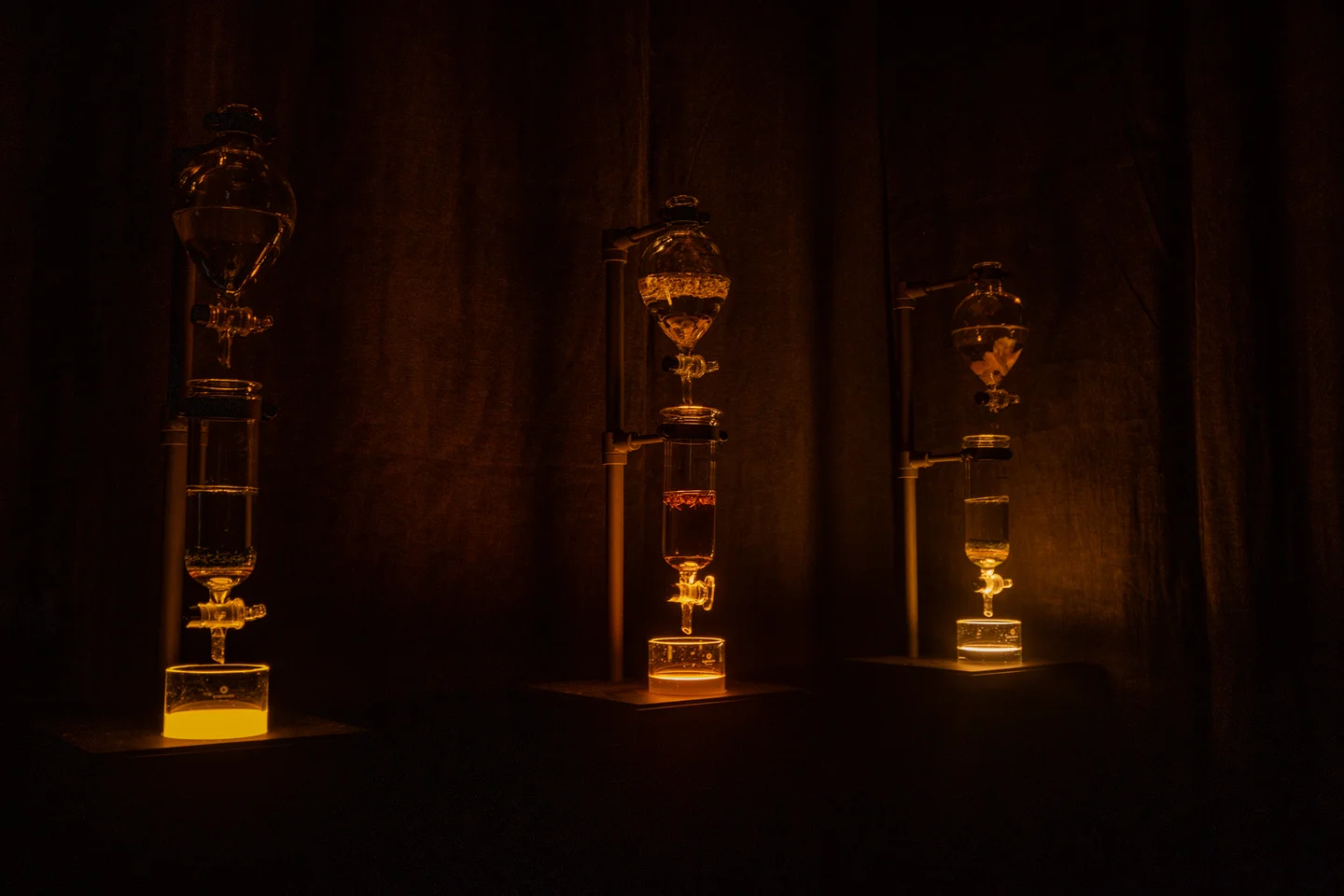
The highlight video below really captures the essence of the experience, with projections being cast onto the tea bowls, and the tables all around the room.
Once seated, we were eventually served our teas, I went for the Barley Tea Rice Milk Latte which had a roasted and slightly nutty flavour from the barley, paired with the creamy and slightly sweet rice milk.
The tea bowl itself was a simple glass bowl, but the real magic happened when the tea was poured in. The digital art projections follow the movement of the bowl, changing and morphing over time until you eventually finished your tea. 🍵
It was a really unique experience you wouldn't be able to find anywhere else, even with the many tea-houses in Japan, highly recommend if you're in Tokyo!
But with the halls of Team Lab Borderless thoroughly explored, we made our way back out into the real world through the exit, which was filled with various plaques with different quotes about art, life and the universe.
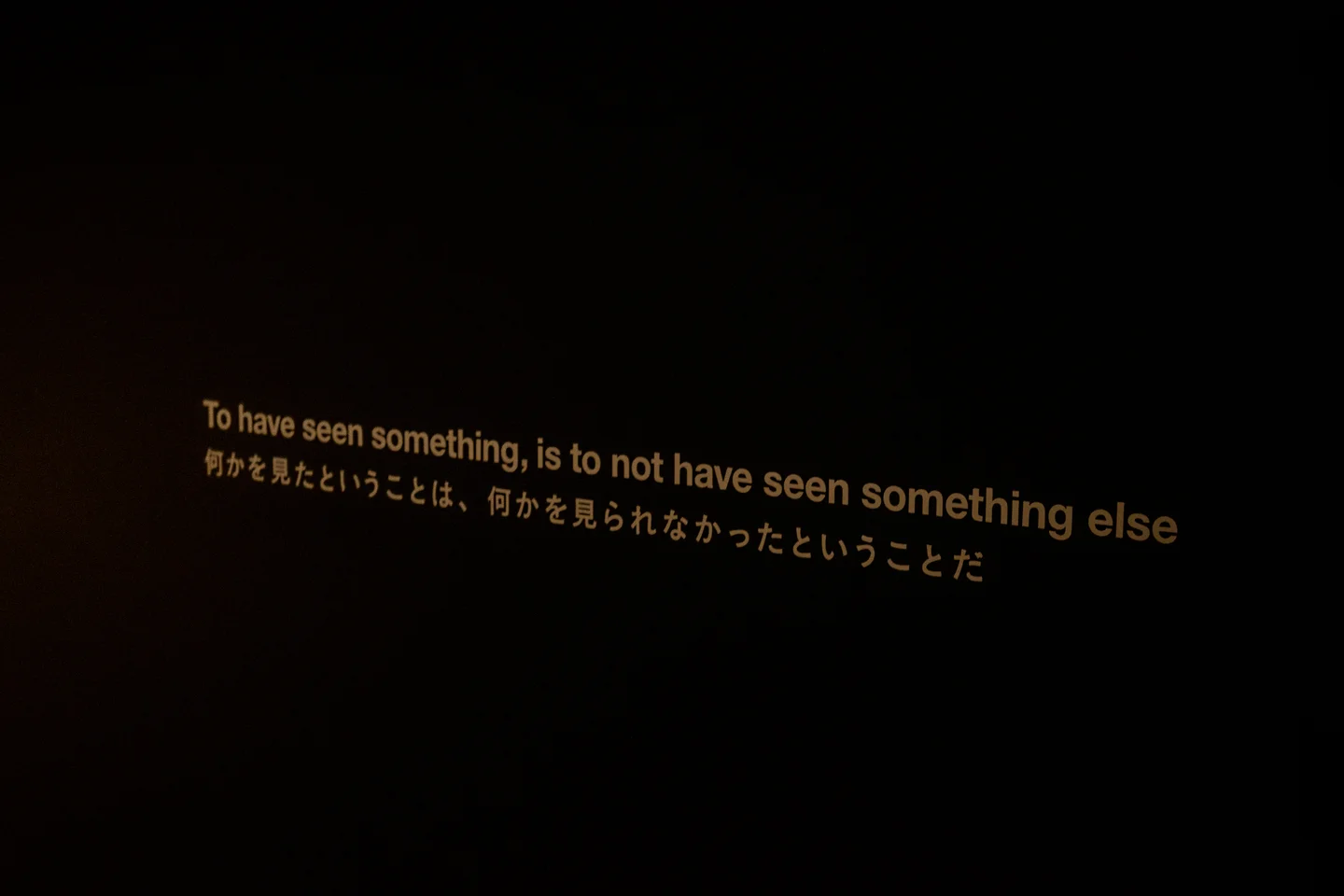
Starting from the lively Azabudai Hills complex in central Tokyo, we took a short stroll to Kamiyacho Station on the Tokyo Metro Hibiya Line. From there, it was just a few stops to Hatchobori Station. Emerging in the heart of Chuo City, we walked a few minutes to Yakitori Torikizoku Hatchobori—ready to chow down on some long overdue yakitori!
We ordered a bunch of different skewers to share, the highlights were definitely the grilled chicken thighs, pork belly and the more premium wagyu beef skewers which were melt-in-your-mouth tender, smokey, and paired perfectly with a cold glass of beer. 🍺
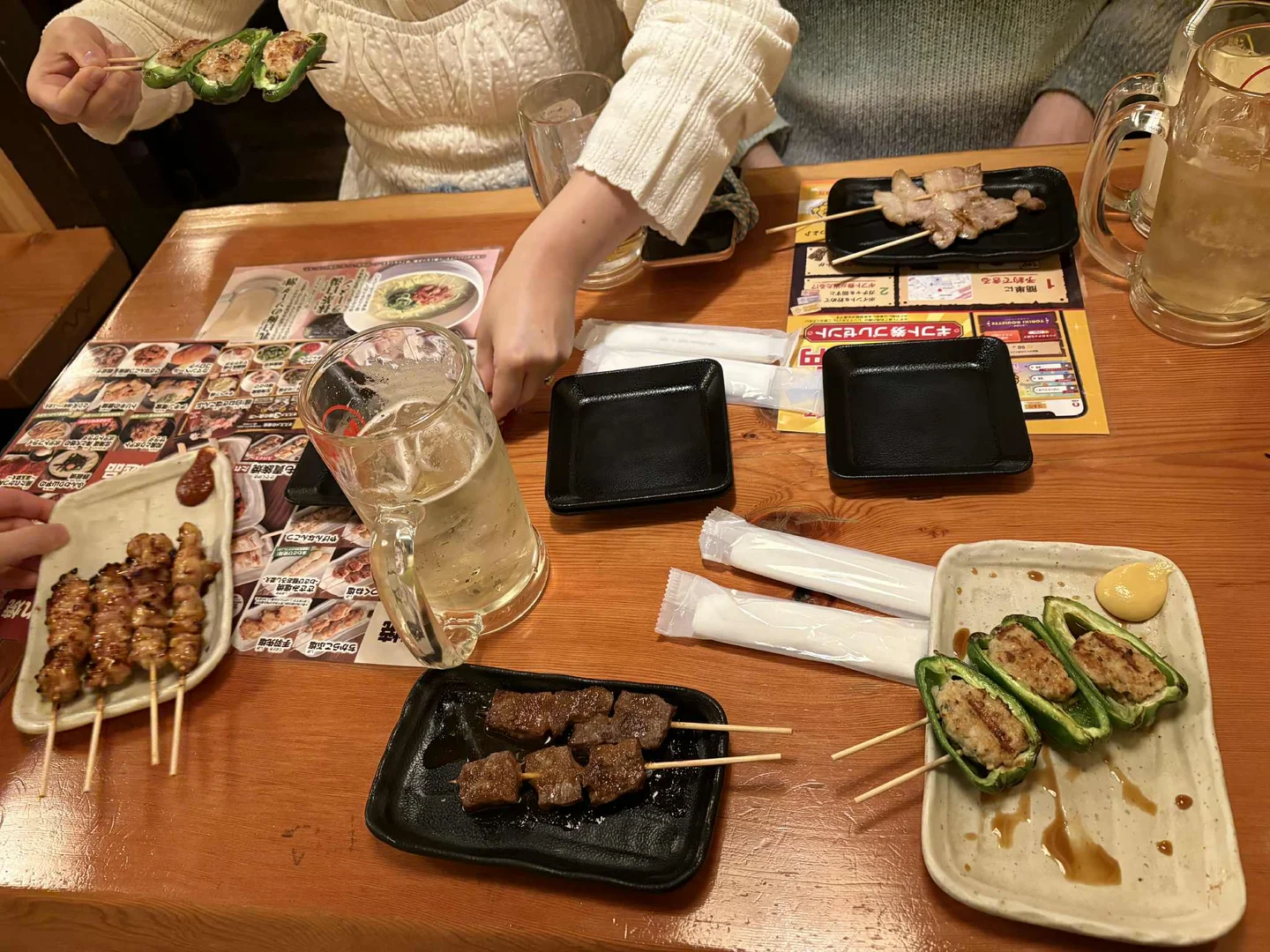
For desert me and Yuki both got some mochi ice-cream, I went for the soy flavour as I wanted to try something a bit different, while she went for the classic strawberry flavour. The soy had a subtle sweetness to it, when mixed with the chewy mochi skin and the cold ice-cream in the center it really came together as a unique combination of creaminess, sweetness, and the slightly savoury flavour of the soy.
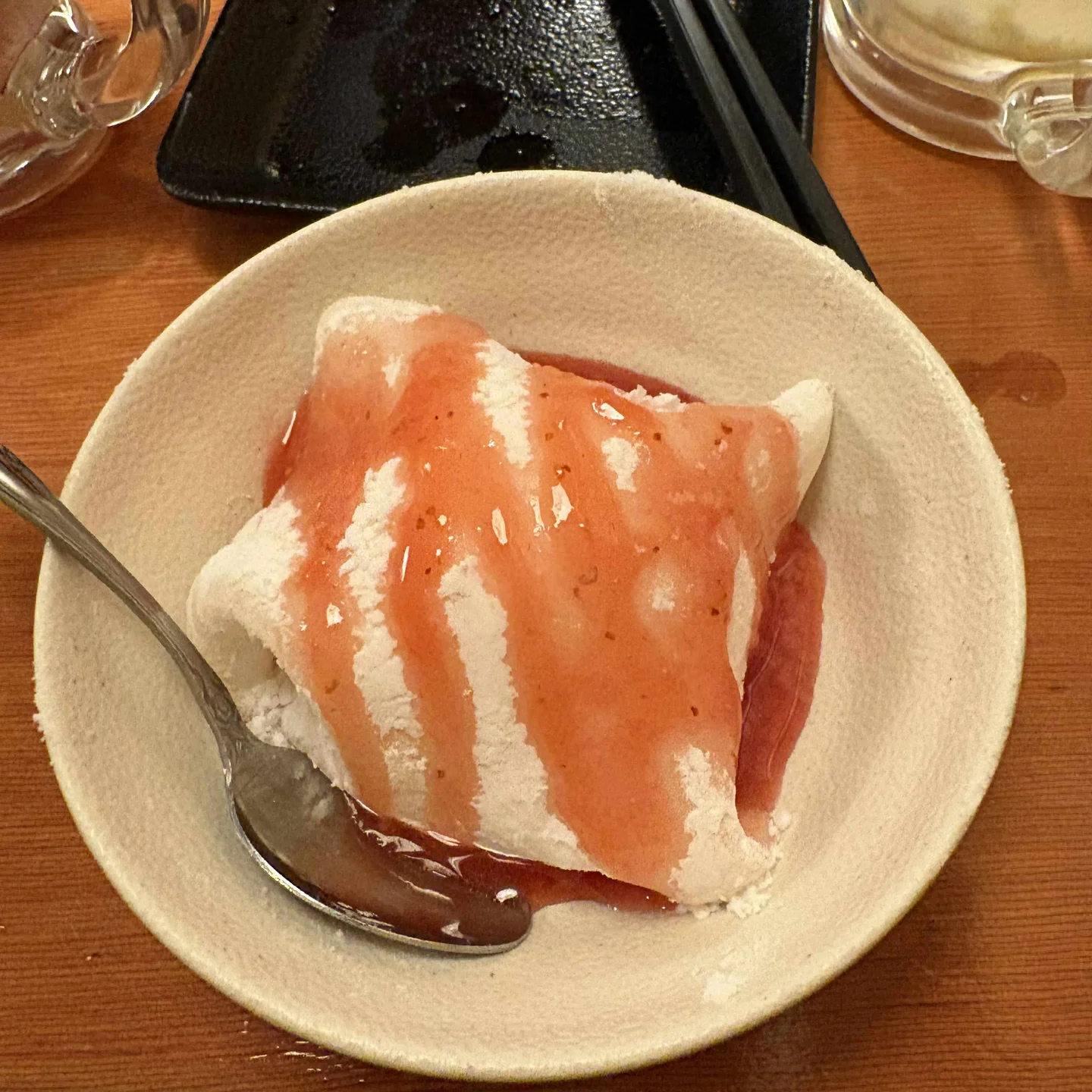
Wrapping up dinner for the night, we headed back towards Azabudai Hills as we were booked in for a visit to the top of Tokyo Tower later that night — our friends stopped at Ginza to do some late-night shopping, so we said our goodbyes and continued on our way! 🚆
Now arriving at Kamiyacho Station once again, we set off on a hunt for more coffee, leading us back towards Azabudai Hills! We found a quite popular coffee shop called % Arabica, it was originally founded in Hong Kong in 2013, however Kyoto is considered the birthplace and location of its global flagship headquarters.

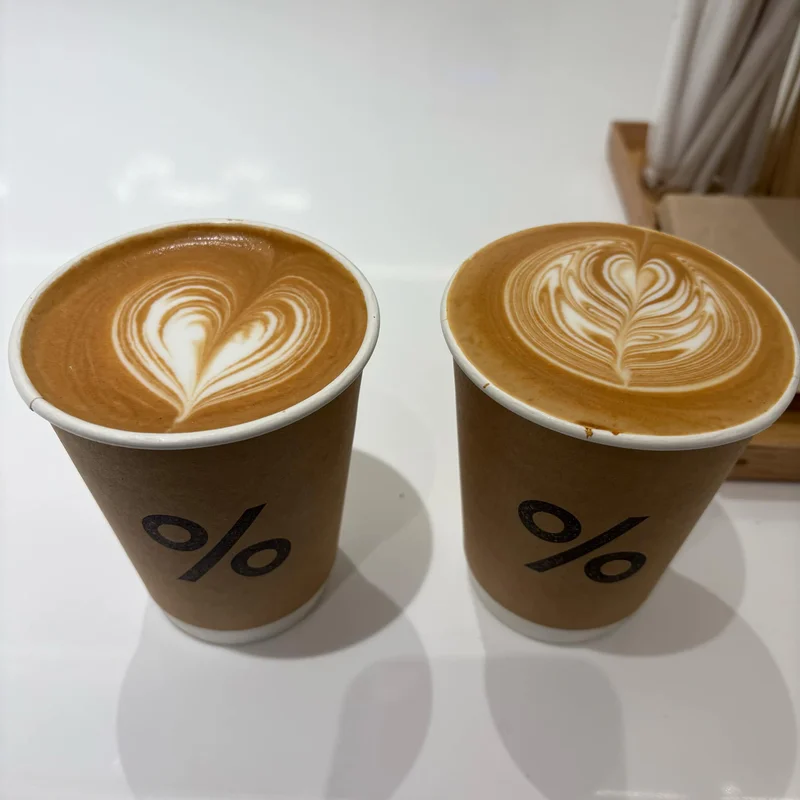
We sat down to enjoy our coffees and the unique atmosphere of the shop, with the white stone countertops, walls and flooring, the entire shop glowed with a soft white light, it made you feel like you were in coffee heaven! 😇
With coffee flowing through our veins, we made our way back outside into the cool night air, and headed towards Tokyo Tower which was only a short walk away.
Tokyo Tower
The first thing that strikes you as you turn the corner onto Tokyo Tower-dori Street and see Tokyo Tower looming above you is just how big it is! Standing at 333 meters tall, and opened in 1958, it was the tallest structure in Japan until 2012, where it surpassed the Eiffel Tower by 9 meters, until it was surpassed by the Tokyo Skytree. It was originally used as a television and radio broadcasting tower, and was constructed to symbolize Japan's post-war rebirth as a major economic power.
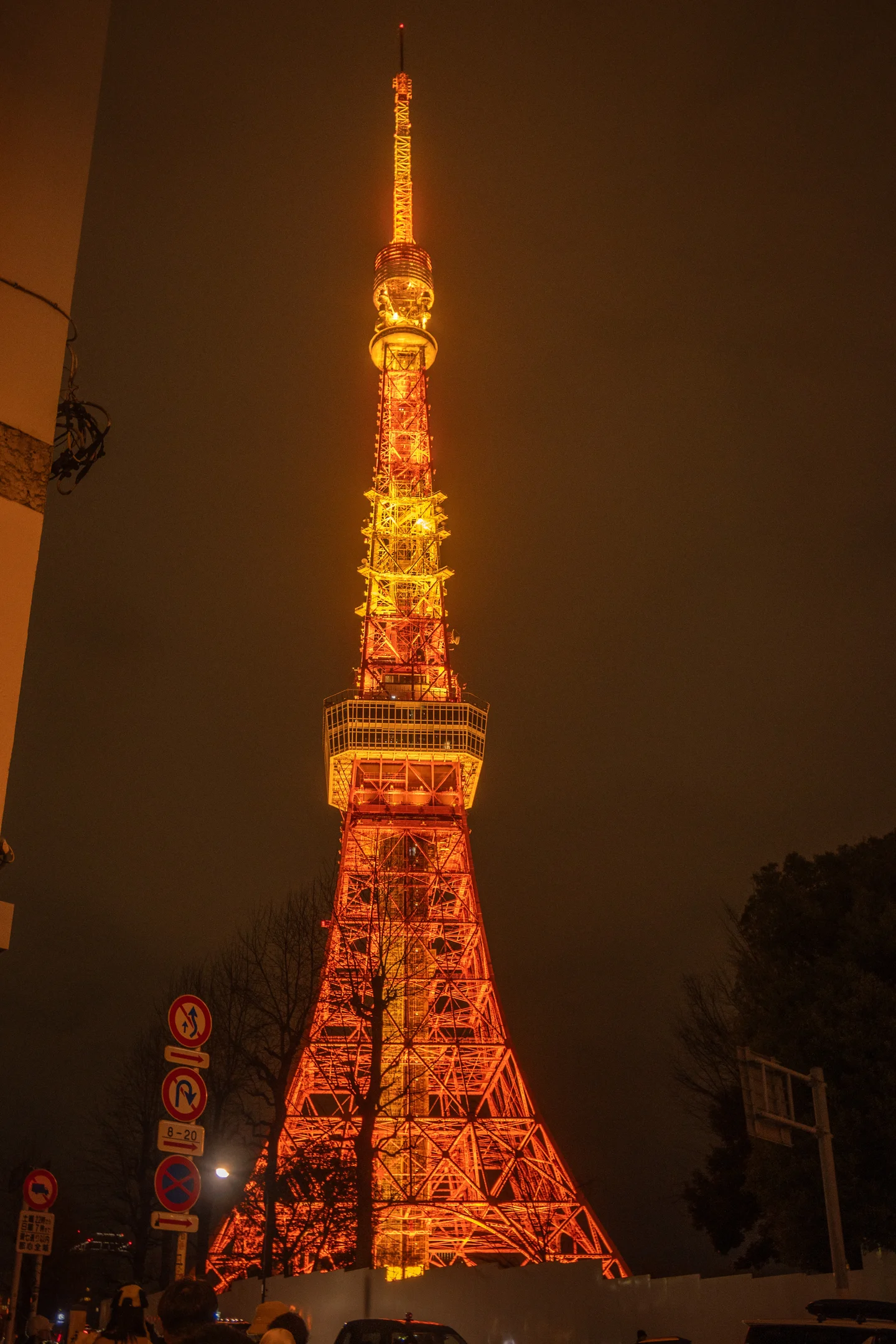
We booked a special "Top Deck" tour which would take us up to the very tippy top of the tower. Before being squeezed into a small elevator you were given some of the history of the tower, and how it was built, back then there was no modern construction equipment, so the process took a lot of manpower and ingenuity to get the tower built.
Once we arrived at the main deck (150m), we were greeted with some complimentary drinks, I snagged myself a glass of Apple juice, how can you say no to free drinks? 🥤
The next stop was the "Top Deck" (250m) which was only accessible via a special elevator, and required you to be on the guided tour. The elevator could only fit around 8-10 people at a time, so there was a bit of a wait, but once we got there we managed to get a complete 360° view of Tokyo from the top of the tower.

Overlooking the Tokyo bay and skyline at night gives you a truly breathtaking view. The yellow glow of the city lights and endless sea of buildings stretching far out in every direction really made you realise just how big Tokyo is.
Even with all that said, you could still see individual people and cars in residential areas living their own little lives far below you.
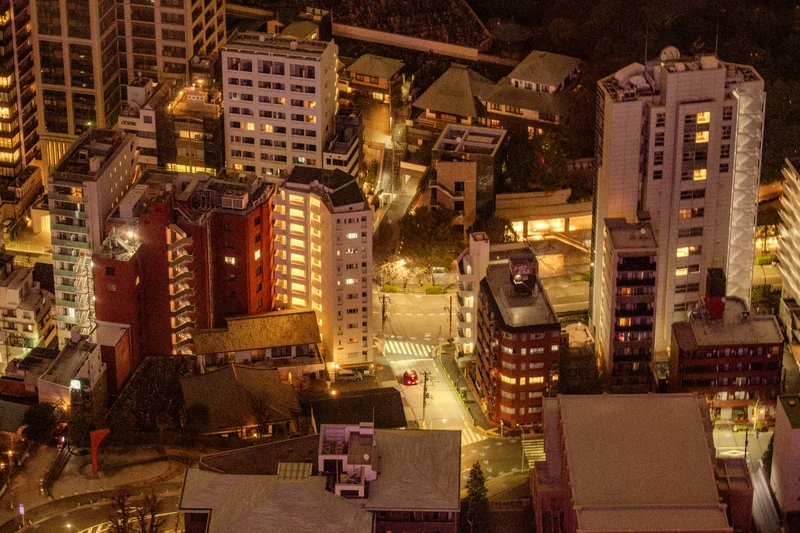

Coming back down the tower after taking oodles of photos, we come back down to the main deck and get a couple of gifts to take home.
You'll also find that on the main deck there are a few glass floors, which give you a view straight down onto the street below, which might give you the spooks if you're afraid of heights! 😵💫

After the long night exploring, we get a wiggle on back towards Asakusa, saying goodbye to Tokyo Tower in the reflection of a nearby building! 🗼👋

Shinjuku
Today was all about exploring the bustling areas of Shinjuku and Shibuya, two of Tokyo's most well known, vibrant and busiest districts.
Starting off in Asakusa we grab some iced coffee and snacks for the trip over to Shinjuku, catching the Ginza Line and making a few switches before finally arriving at Shinjuku Station, which is the busiest railway station in the world, with over 50 platforms, and handling between 2.7 to 3.6 million passengers a day!
Just a short walk away was our first stop of the day, lunch over at Lumina Est shopping mall.
The restaurant that was in our sights was Komekaru, also known in English as "A Luxurious Day for Ochazuke". This cosy ochazuke spot in Shinjuku lets you start with a seafood rice bowl and then pour steaming dashi over it mid-meal for a second flavour rebirth.
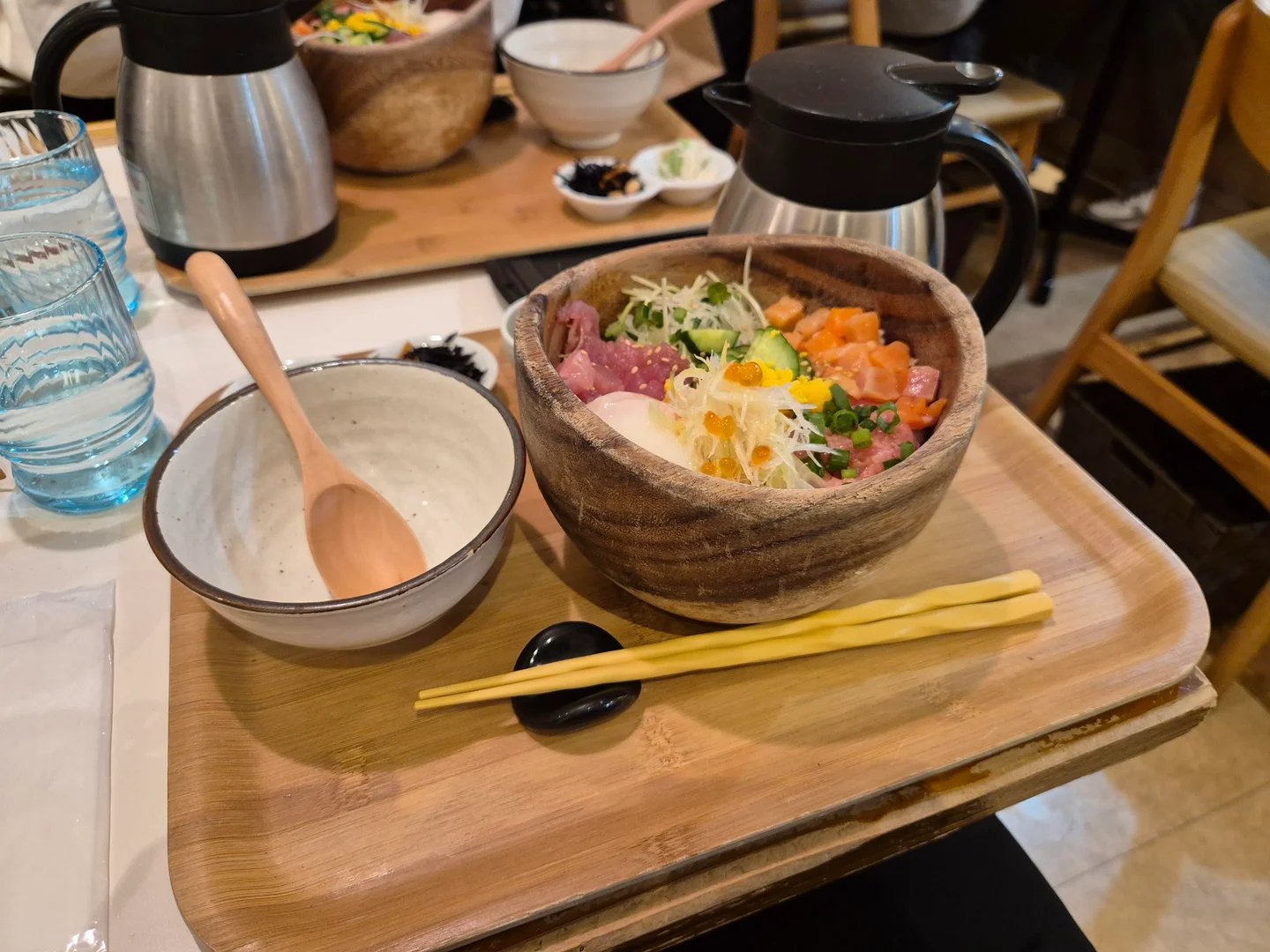
My set (Yuki got the same) came with a generious serving of sashimi, with a mix of tuna, salmon, ikura (salmon roe), soft boiled egg, assortment of pickled vegetables, small amount of spring onions, all served on a bed of rice, with the side of dashi broth to pour over it later, or whenever you want, you're the boss! 😎
Hidden behind the bowls you got some side of mashed potato salad, and a small bowl of furikake which is a dry Japanese seasoning you could sprinkle on top of the rice, it usually consists of a mixture of dried fish, sesame seeds, chopped seaweed, sugar and salt.
After rubbing our full bellies, we headed back into Shinjuku Station to catch the train over to Sangubashi station in Shibuya, just off the Odakyu line, which would take us to the west entrance of Yoyogi Park which surrounds Meiji shrine.
Shibuya
Making our way out from Sangubashi station we walked along the wide open road leading into Yoyogi Park, the park is one of Tokyo's largest city parks, you immediately feel the change in atmosphere as you approach the wooden large torii gate at the entrance of the park.
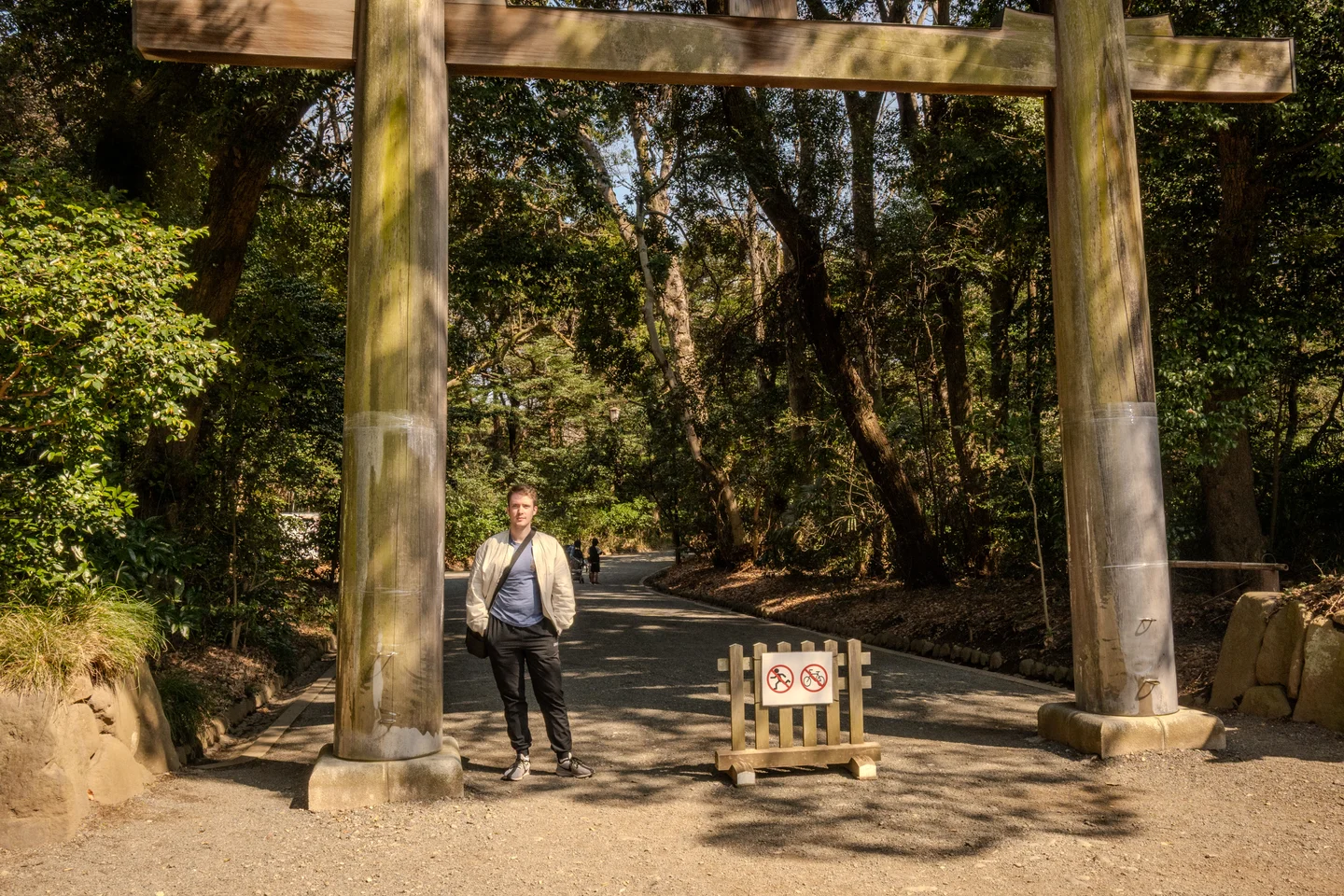
We then followed along the long path weaving through Yoyogi Park, towards the famous Meiji Jingu shrine, which is a Shinto shrine dedicated to Emperor Meiji and Empress Shōken — emperor Meiji was the first emperor of modern Japan, who's rule marked the end of the feudral Tokugawa shogunate, and the beginning of the Meiji Restoration.
On our way you see the open fields of Yoyogi Park, which is a popular spot for all sorts of outdoor activities, especially around cherry blossom season!
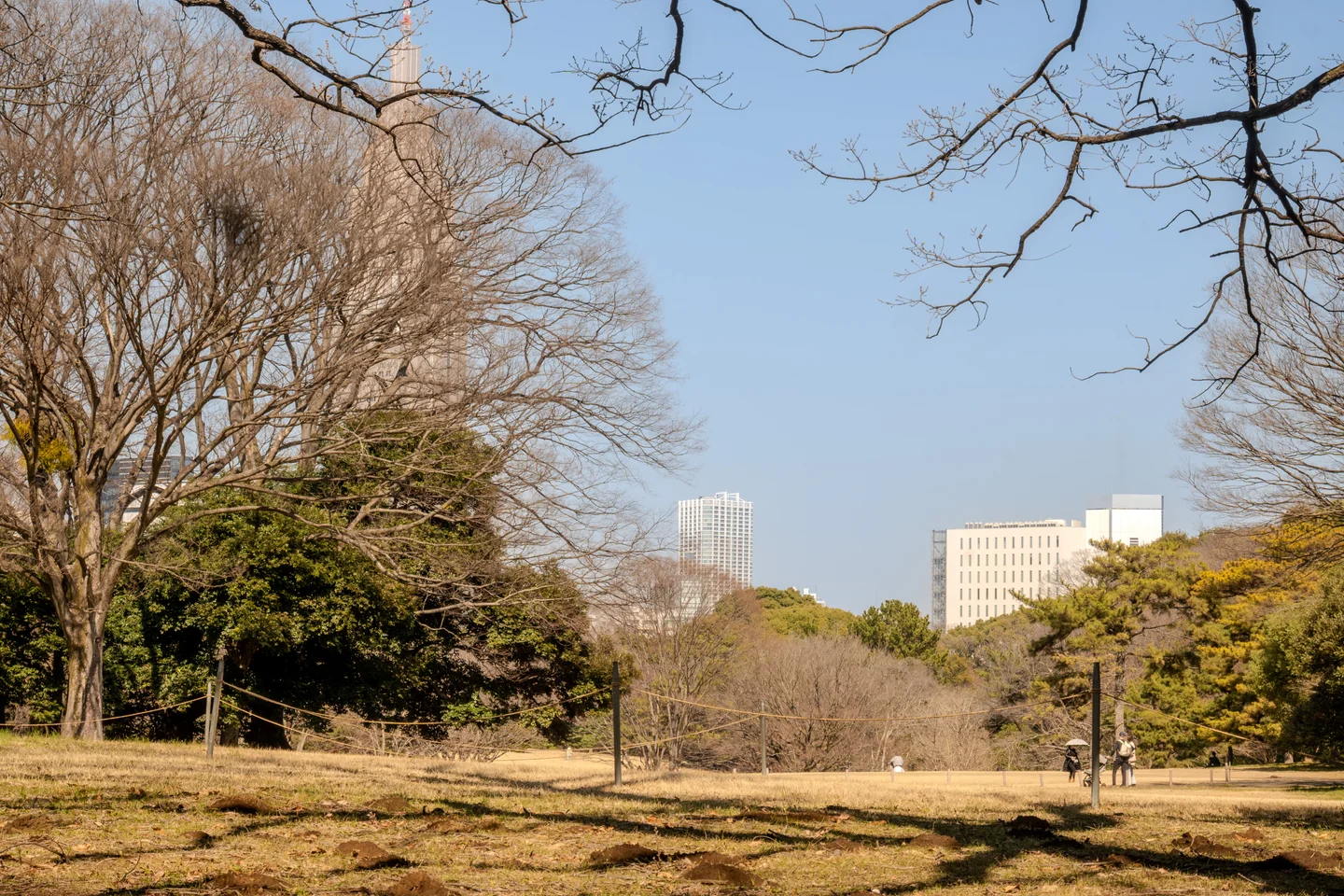
Walking through the park, we soon reach one of the shrine entrances, where yet another large torii gate stands among the trees and greenery of Yoyogi Park, enshrouding the grounds, marking the start of the main shrine.
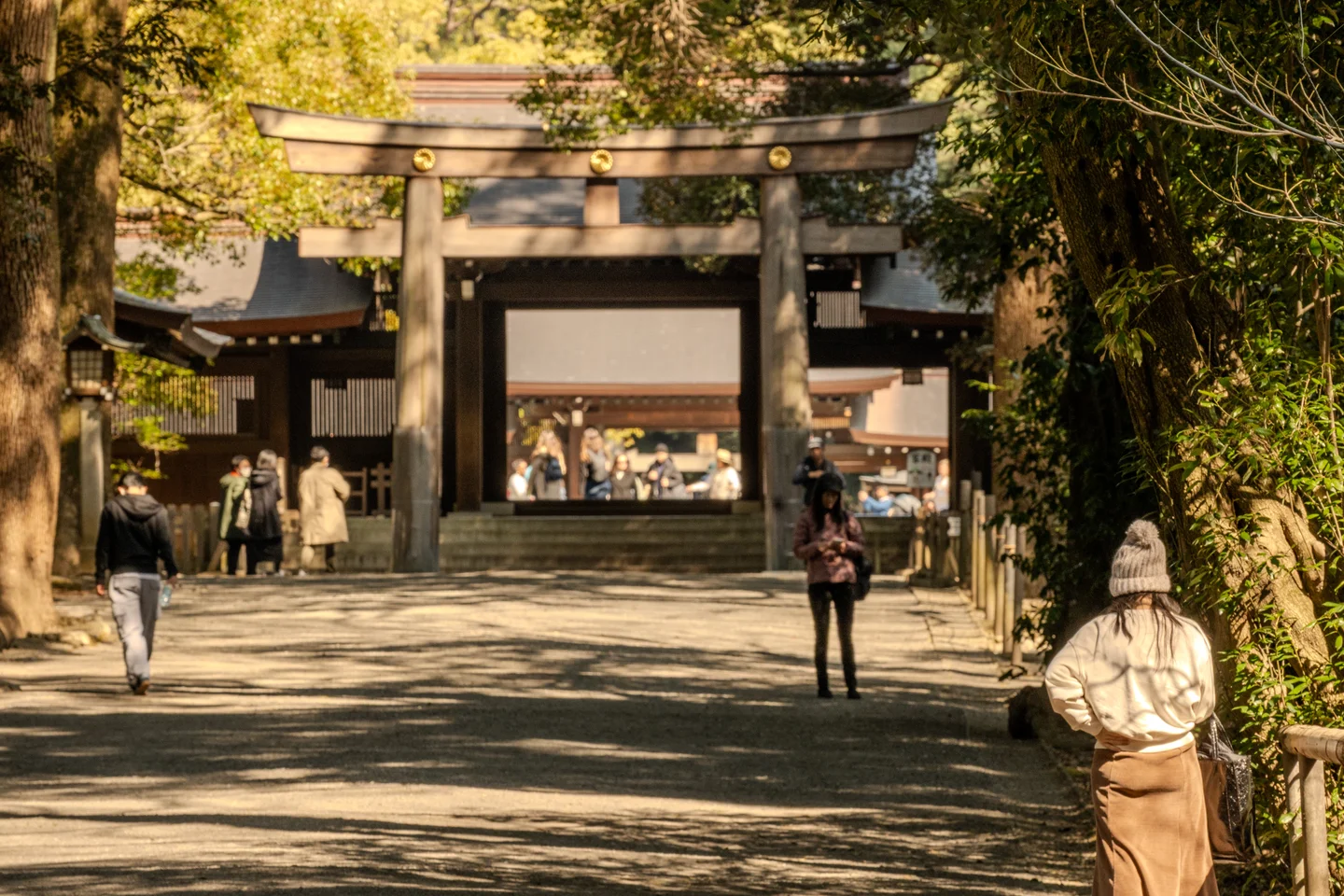
Stepping into the main courtyard of the temple grounds we are met with giant camphor trees, and also spot a traditional Shinto style wedding ceremony taking place, with the bride and groom dressed in traditional white attire, and a small group of family and friends trailing behind.
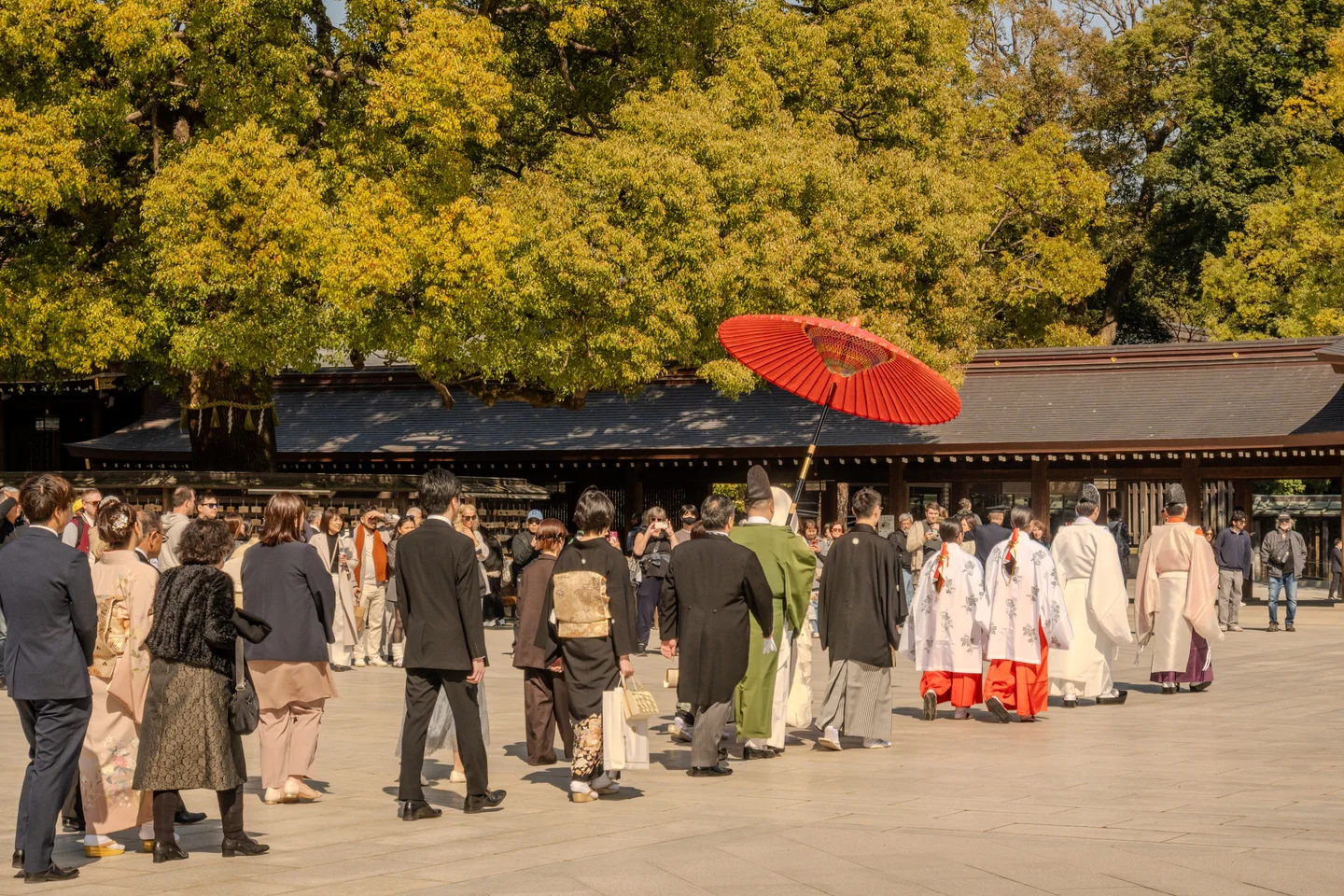
Underneath the trees you can sign a small wooden plaque called an Ema which is a small wooden plaque on which Shinto worshippers (or tourists in this case 😉) write their prayers or wishes. The plaques are then left hanging up at the shrine, where the kami (spirits or gods) are believed to receive them.
On that note, we head on over to the souvenir shop to grab one of the plaques!
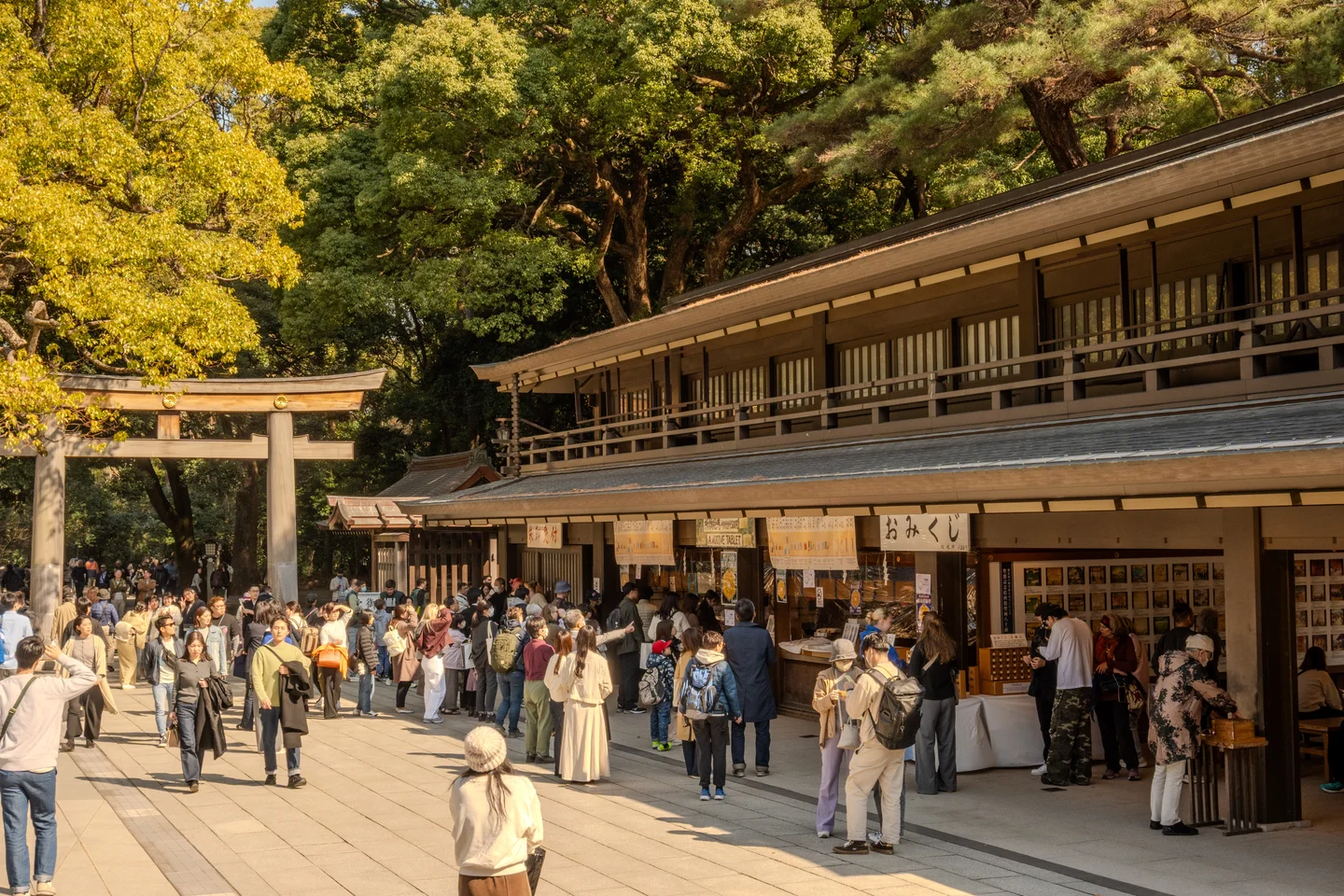
Writing our hopes and wishes down, we hang the plaque up on the wall with all the others - hoping our wishes for good fortune are blessed by the gods!

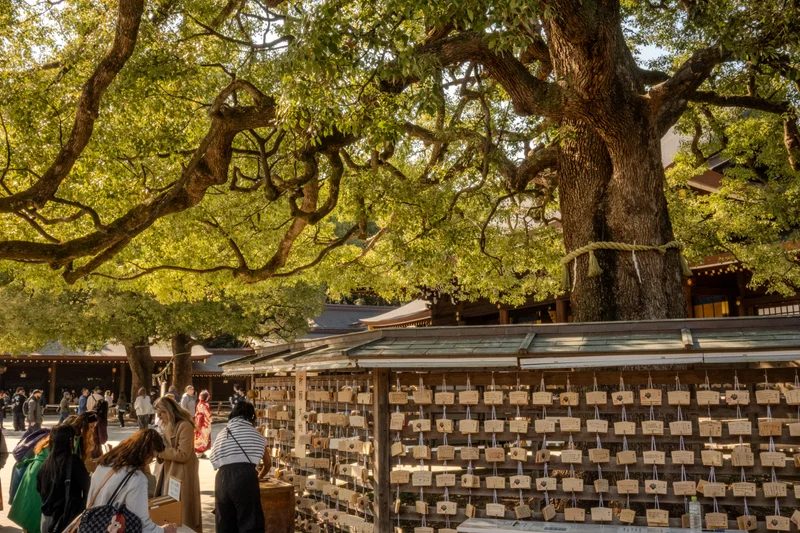
By the time we finish writing on the plaque, another wedding ceremony is just starting, so we hang around to watch the procession make its way through the shrine grounds.
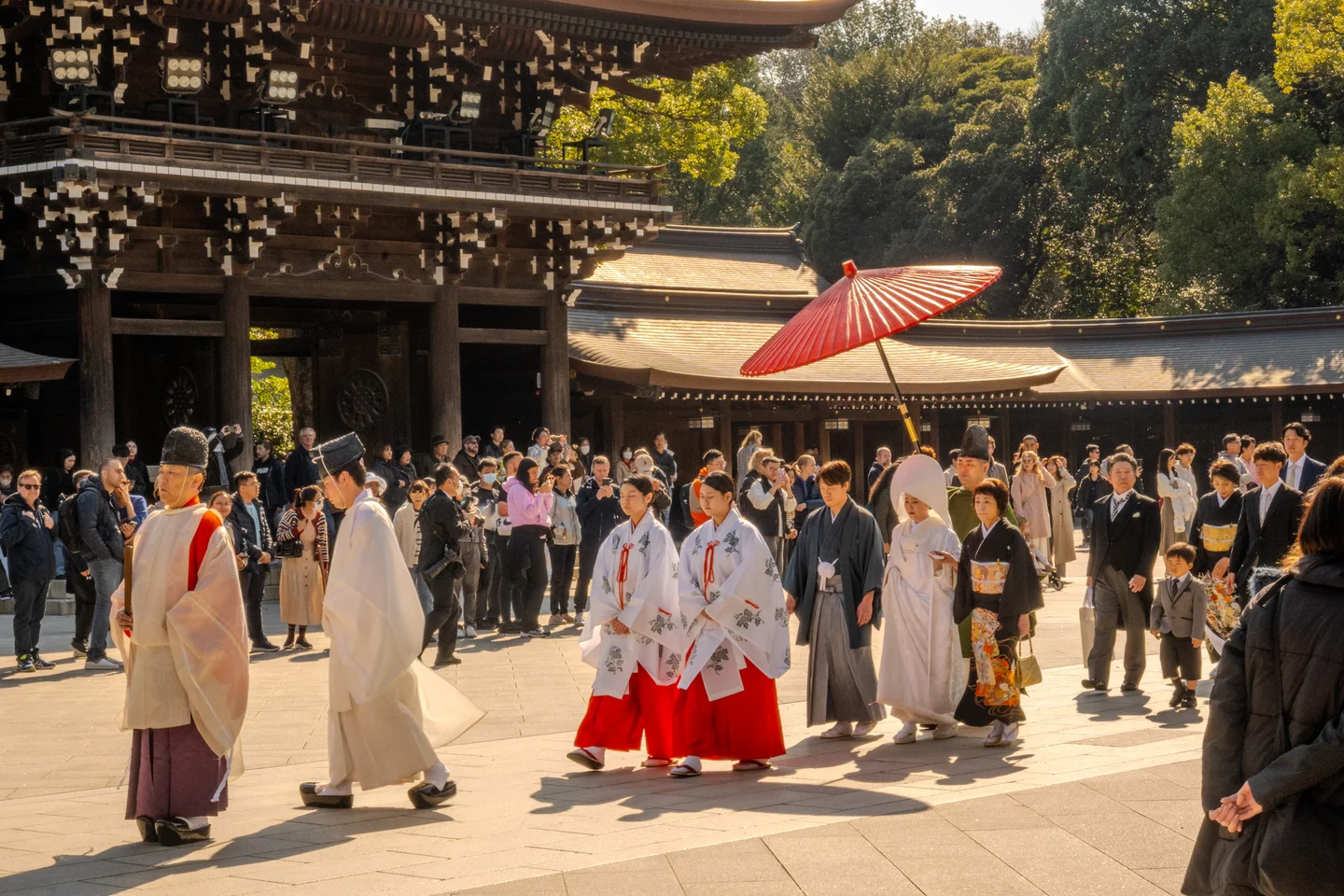
Soaking in the warm glow of the spring sun, and giving room to the wedding party, we make our journey towards the exit through yet another torii gate — these are located at all sides of the shrine, as it's customary to bow before entering and exiting the sacred grounds.
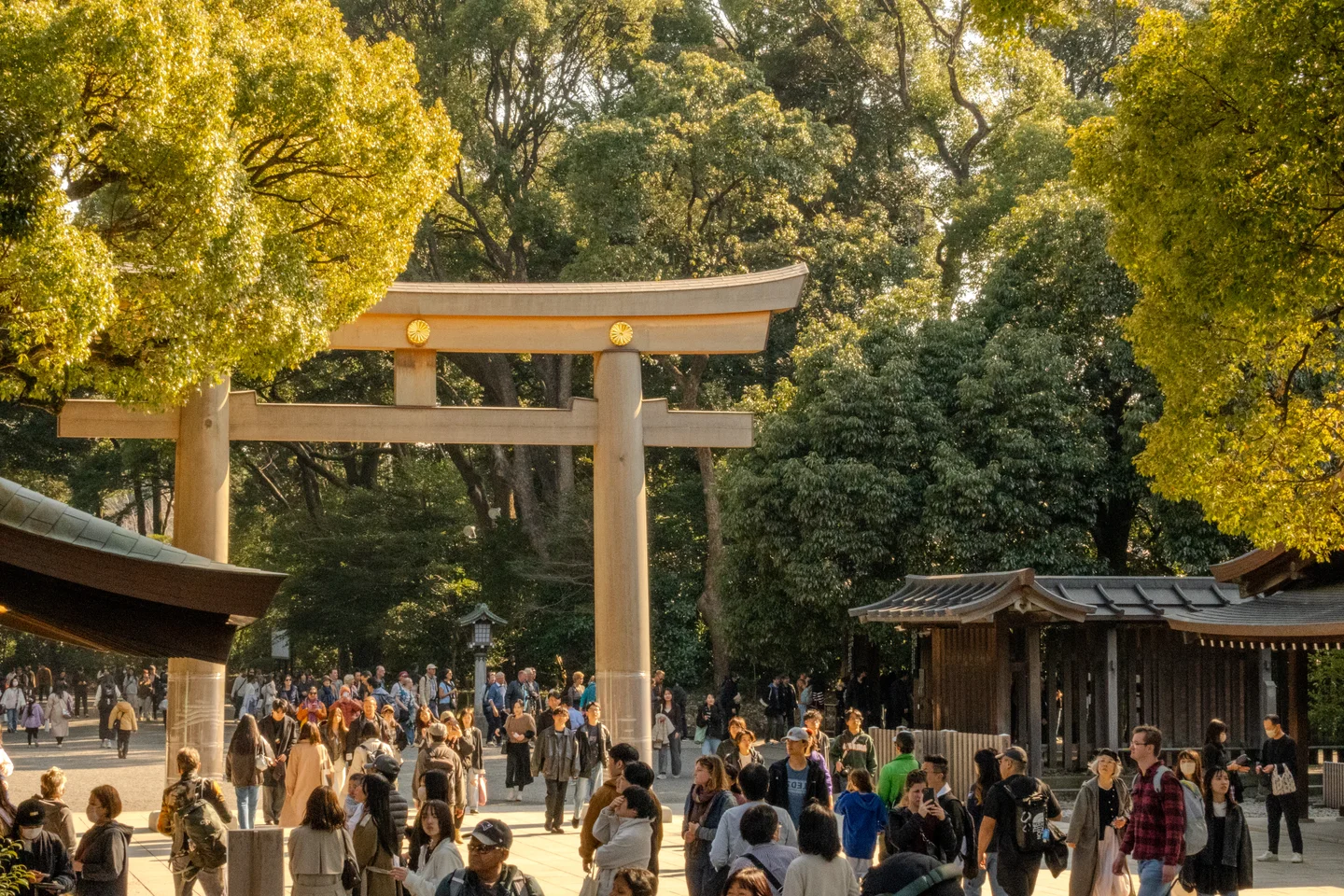
As we walk long the path through Yoyogi Park and towards Harajuku Station, we pass by a few large sake barrels donated to the shrine by various sake brewers from around Japan, to honor the former emperor and empress, as well as some large wine barrels donated by various French wineries.
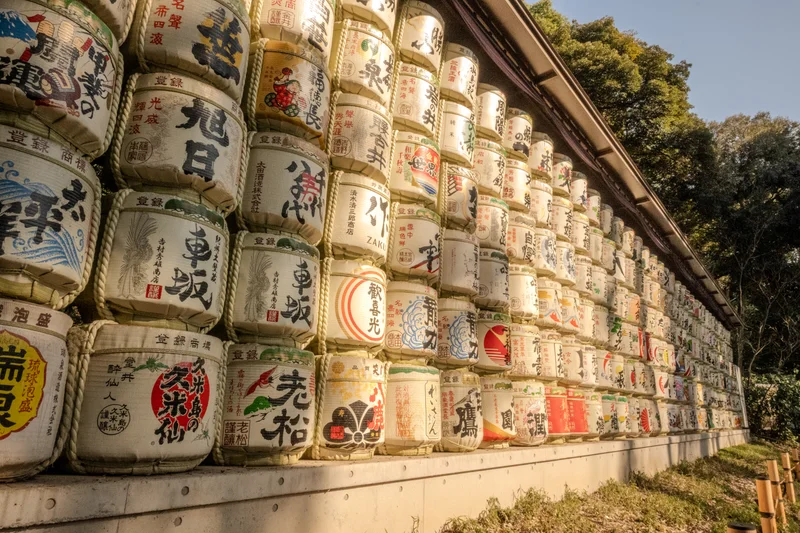
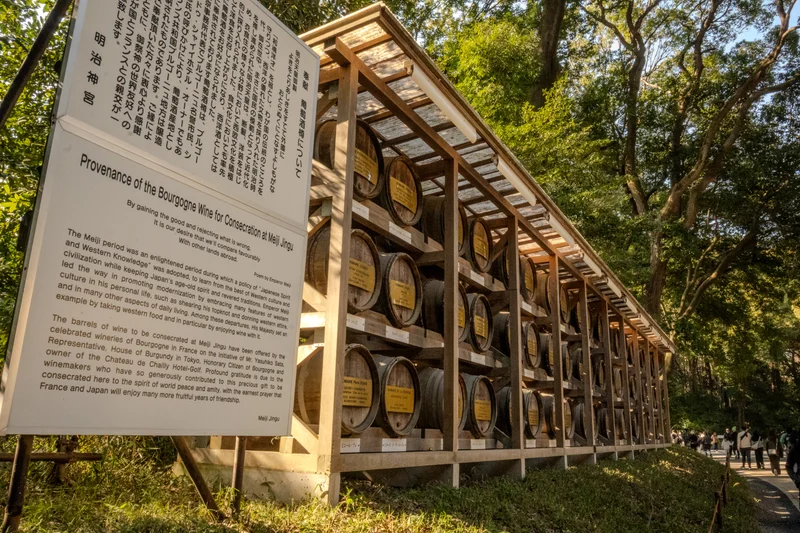
With the main areas ticked off we enter into Harajuku Station, before catching a short train ride over to Shibuya Station.
Immediately upon exiting the station we are greeted by the famous Shibuya Scramble Crossing, absolutely flooded with a sea of people in every direction you can see — it's not known as the busiest part of Tokyo for nothing!

It's here you often see the iconic little go kart tour groups driving past, between the hordes of people crossing from side of the street to the other, the drivers dressed up in their favourite anime or video game character costumes, and honking their horns as they go by, beep beep! 🚗💨
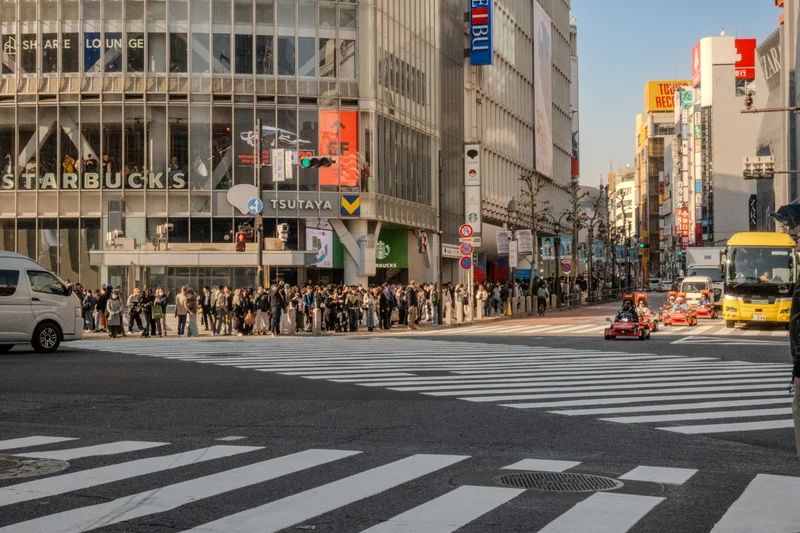

Just outside of Shibuya Station is the famous Hachikō statue which is a bronze statue of the loyal dog Hachikō, who is remembered for his remarkable loyalty to his owner, Hidesaburō Ueno, for whom he continued to wait for over nine years following Ueno's death.
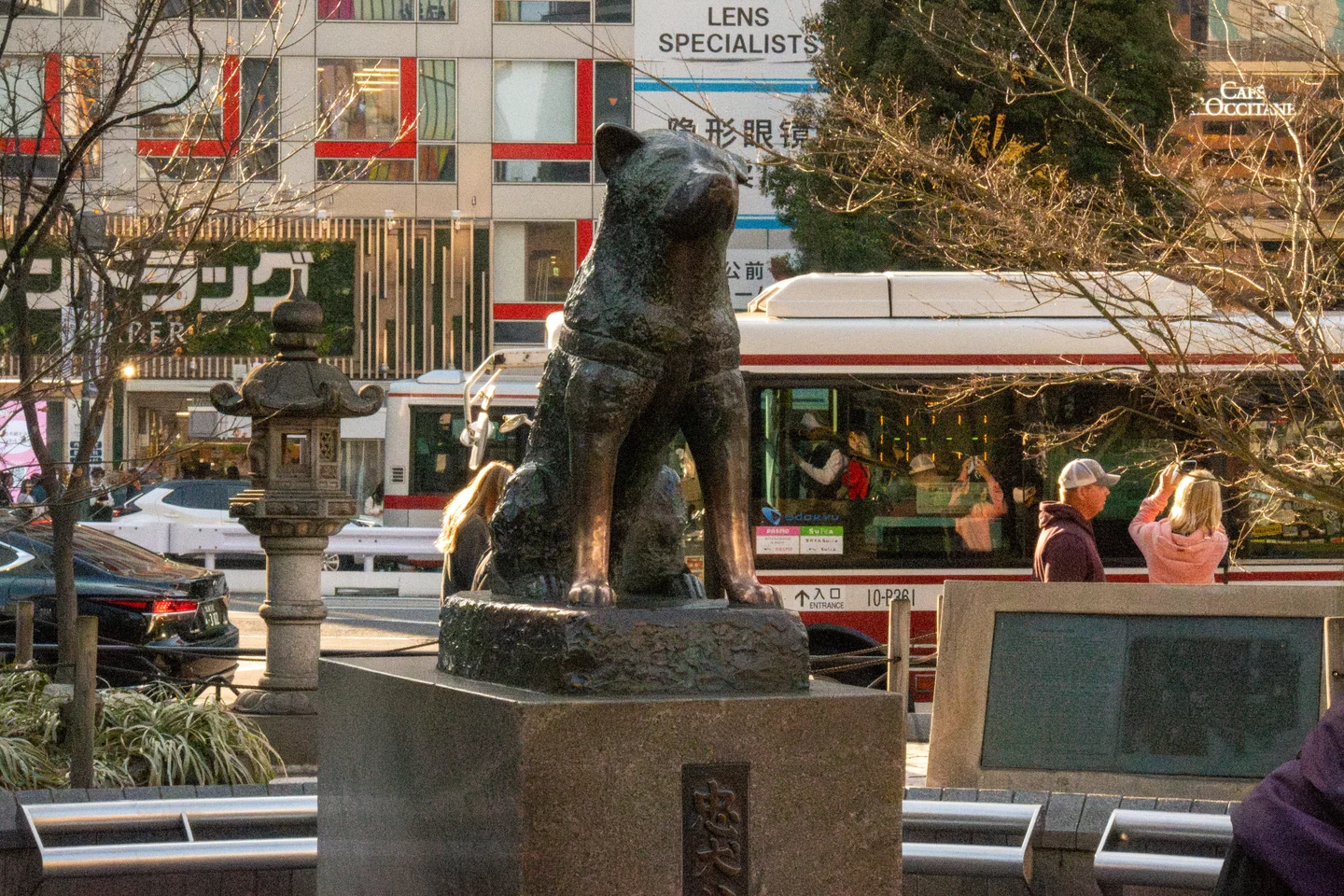
It was swamped with people taking photos, as soon as someone moved away from the statue, barely a second went by before someone else jumped in to pose with it. With Hachikō properly admired, we set off to explore the streets of Shibuya, searching for a specific manga, "The Climber", one which my brother asked me to scour all corners of Tokyo to find. 🔍
We started by venturing into Mandarake which was underground, it felt like walking down into a secret cave filled with anime, manga, random books, figurines, and Japanese pop culture memorabilia. After searching through what felt like an endless maze of shelves and aisles, even after waddling our way over to the front desk to check the inventory, we still couldn't find the specific manga volume my brother was looking for.
Even after checking out Animate which was just around the corner, we still came up empty handed — 2 of the biggest manga stores in Shibuya, and nada... It was starting to really feel like a climb to find this volume! 🧗♂️

The search would have to wait... coming out of the search around Shibuya, and putting in some serious steps for the day already, we needed a sugar hit, so we set off in search of some nearby crepes. 😏
We stumble our way over to Dipper Dan which was just a short walk away! I ended up getting a banana crepe, while Yuki got a matcha one with some tiny little brownie pieces on top.
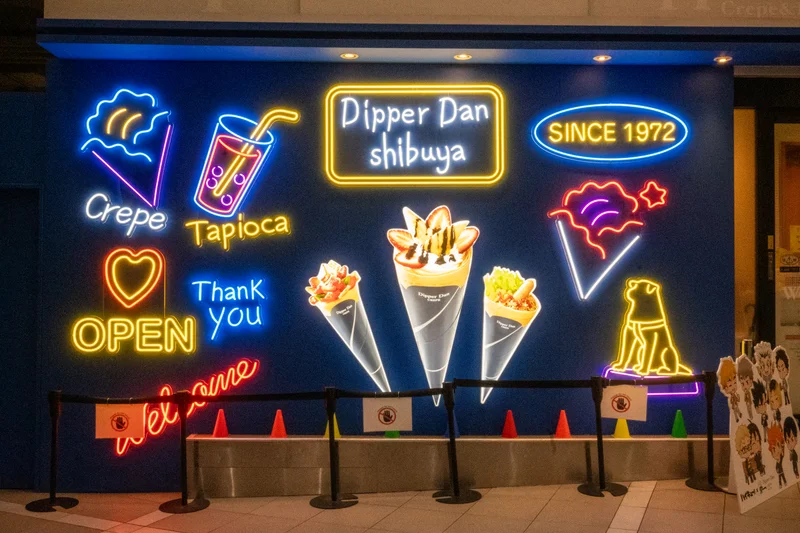
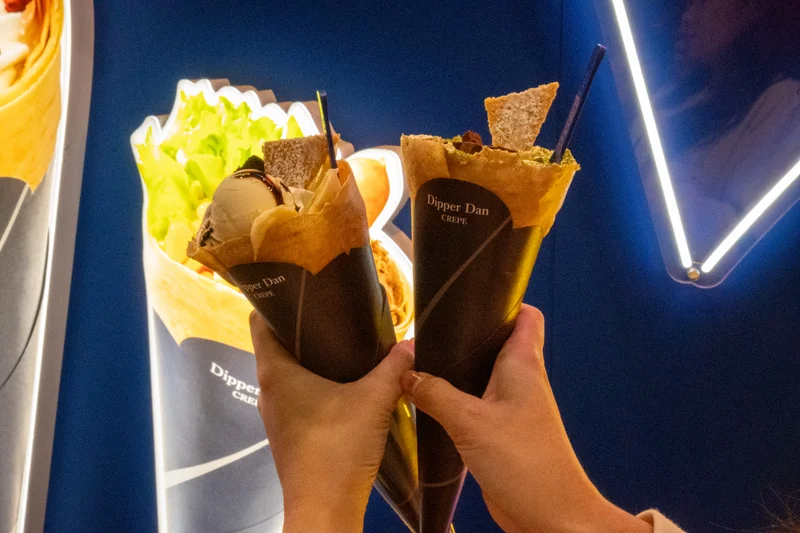
Sharing is caring, so we took a few bites of each others crepes, they were both delicious, the banana one was sweet and creamy, espcially with the scoop of ice-cream and bannana slices, while the matcha one had a nice earthy bitterness to it from the matcha powder.
It was at this point the sun was starting to set, so we decided to look for a place for dinner. We settled on a small ramen shop called Dotonbori Kamakura, located on Shibuya Center-Gai, the main famous shopping and nightlife pedestrian street in Shibuya which you can spot from just outside Shibuya station. Judging by the name of the restaraunt, it must have been fate, it just so happened we were going to Kamakura the next day!
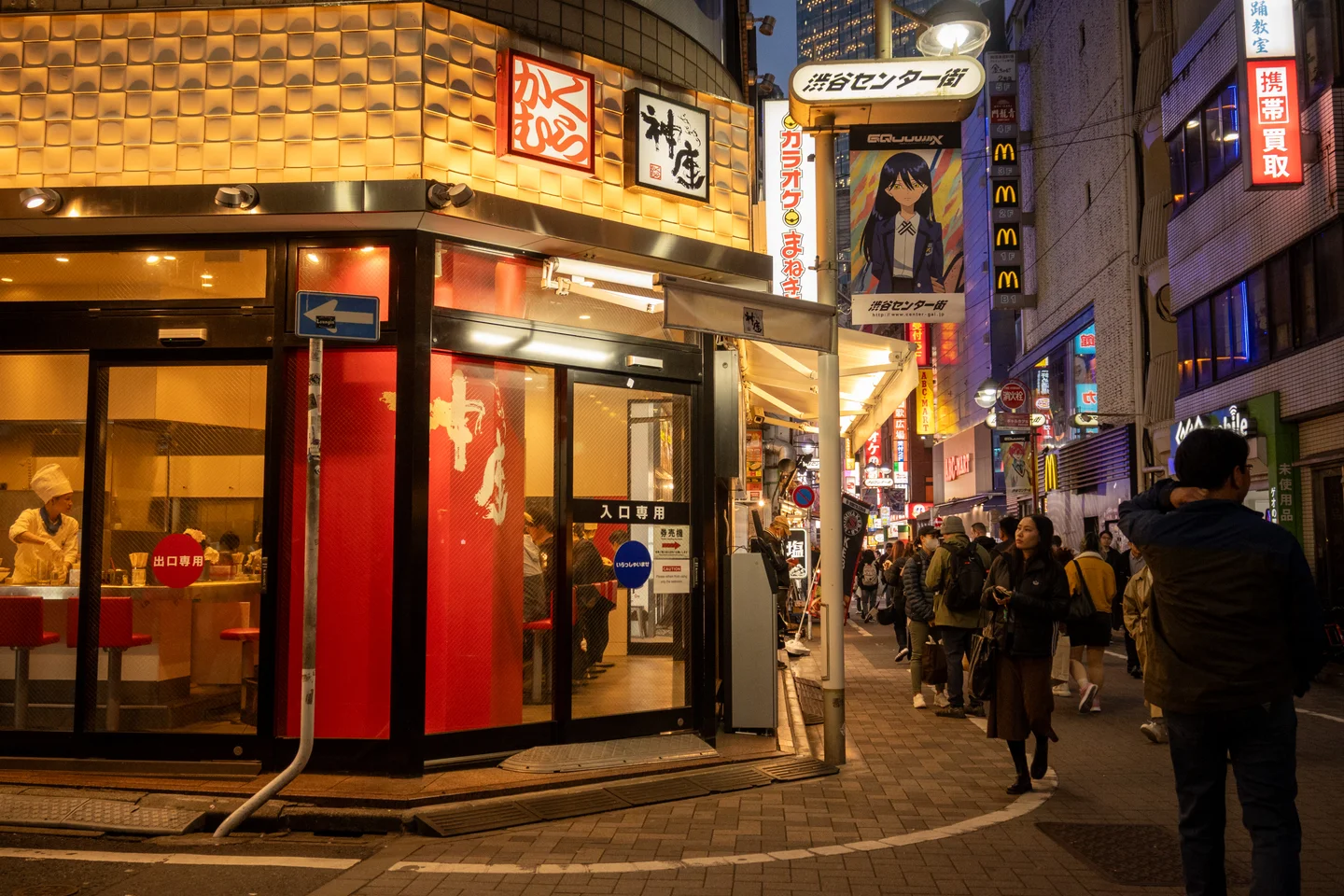
I ordered myself a bowl of yuzu shio (salt based) pork ramen, with an add-on egg, I mean why wouldn't you a gooey soft golden ramen egg straight from the motherland? Yuki funnily enough got the same! When in Rome... 🍜
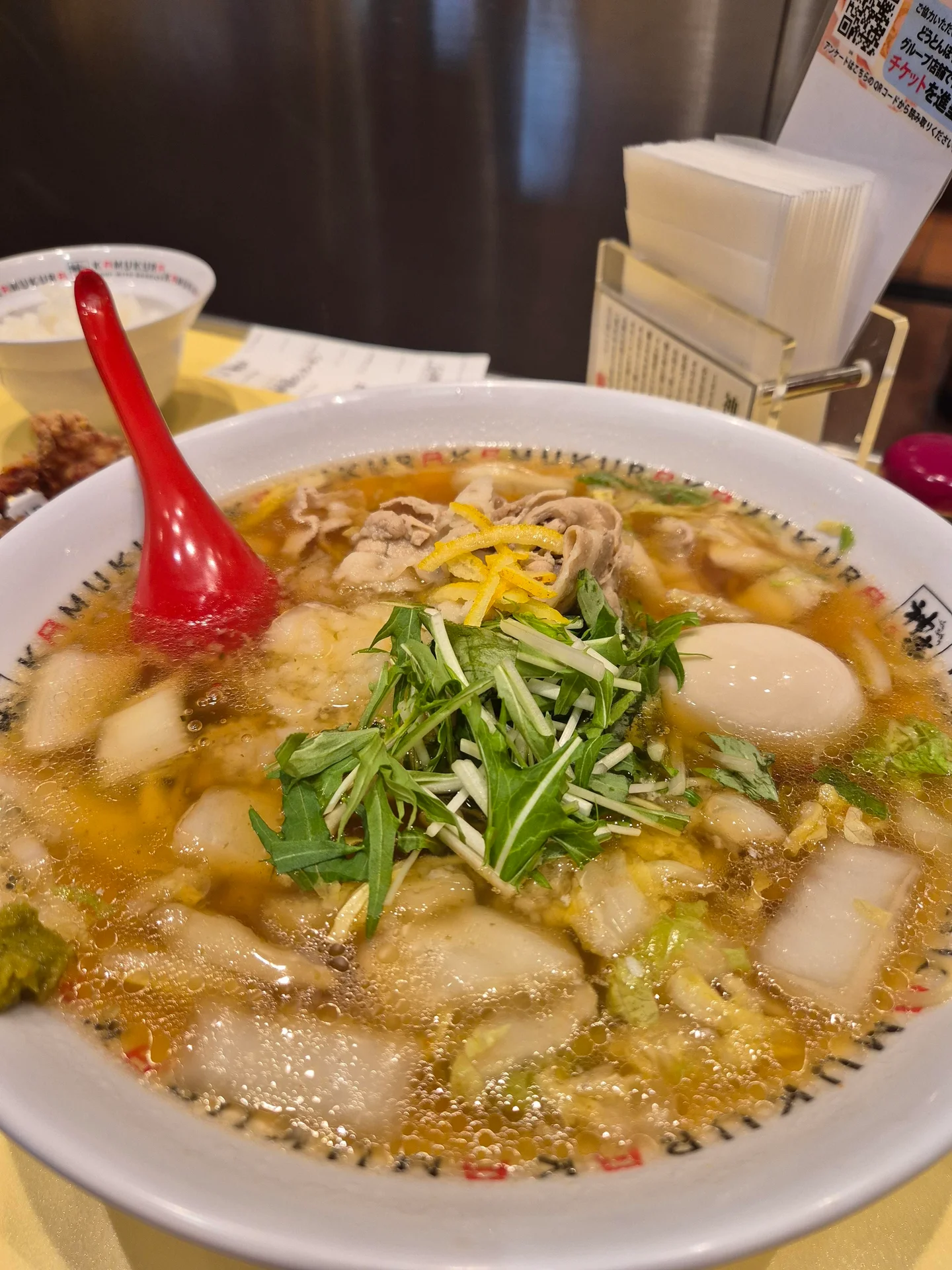
But the ramen wasn't enough! I also had a craving for some crunchy, juicy karaage, so we split a small side of that too, alongside a small bowl of white rice, I was really pushing my limits. 🫃
Heading back into the hectic streets of Shibuya, we make our way toward Shibuya Station, soaking in the sights of Center-Gai at night. Warm, colorful, and bright white lights shining in every direction, all while influencers are on the clock, recording their evening TikToks.
It all perfectly captures the essence of Shibuya after dark. 🎥
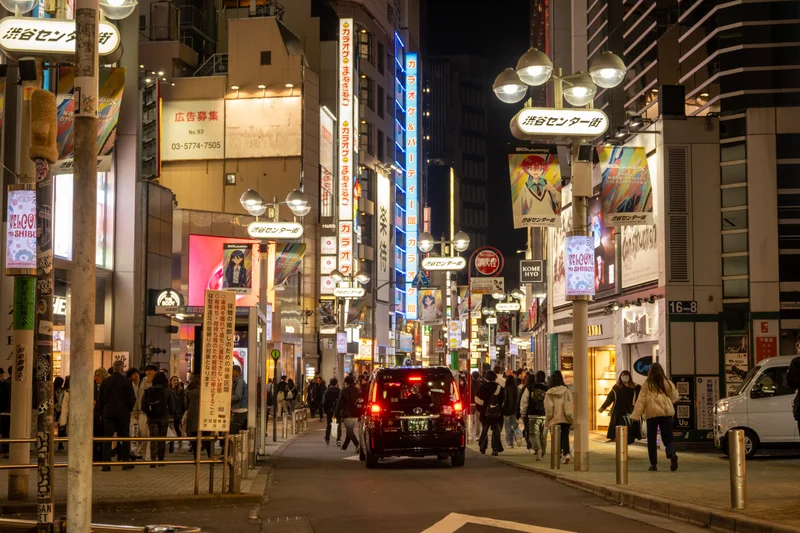

Stumbling out of Center-Gai, we make our way down through Dogenzaka Street, which is especially well known for its hostess clubs, love hotels and nightclubs. A great place to explore if you're "that" type of tourist. 😂
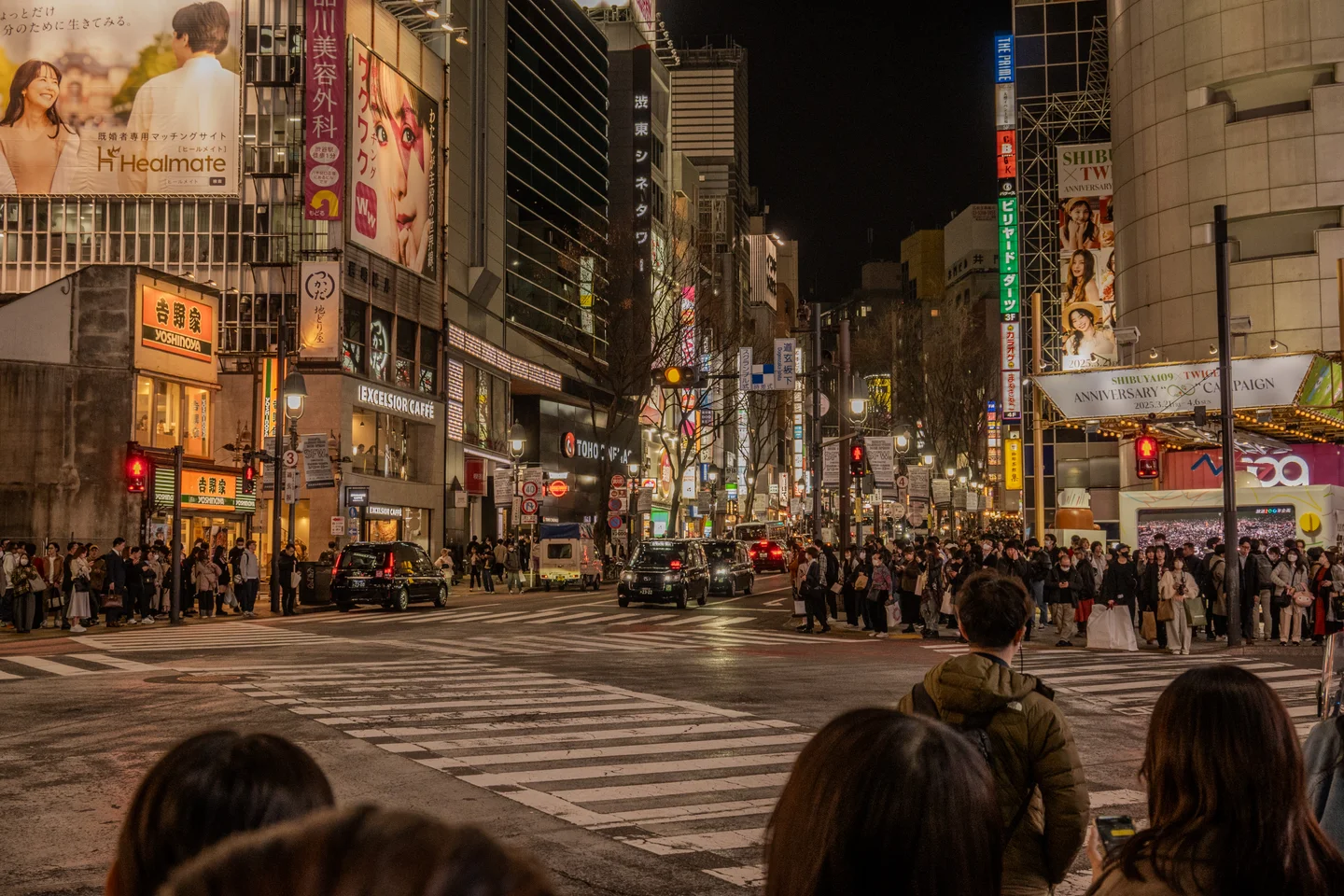
That brings our night in Shibuya to a close, we take the train back to Asakusa, and call it a night! 🌛
Kamakura
Waking up bright and early, we're scheduled to head out to the beachy town of Kamakura today! Known for its giant Buddha statue, beautiful temples and stunning coastal views, it's a popular day trip, or surfing getaway, not far from Tokyo.
We booked our day out as part of a semi-guided tour, which included our direct bus transport from Tokyo to Kamakura, as well as the guided tour of the main sights around Kamakura — we mostly just wanted to relax and not have to worry about the complicated train routes and transfers, so this made it super stress free! 🚌

After making our way from Asakusa to Tokyo via the metro, and a little bit of walking, we arrived just outside Tokyo station, where we met up with our tour group guide for the day, his "tour guide name" was Edward, he spoke a mix of broken English and mandarin which was perfect for us, as Yuki could help translate before he went through the English version!
After around a 1½ hour long bus-ride through the Tokyo expressway, and weaving through the tight corners of Kamakura, we finally arrived at our first stop of the day, the famous Great Buddha of Kamakura (Kamakura Daibutsu) at the Buddhist temple Kōtoku-in.
Like many spiritual sites in Japan, the Great Buddha is guarded by a large gate with Niō guardian statues on either side, which are meant to ward off evil spirits, and also signal that you are entering a sacred space (much like the gates at Senso-ji shrine).
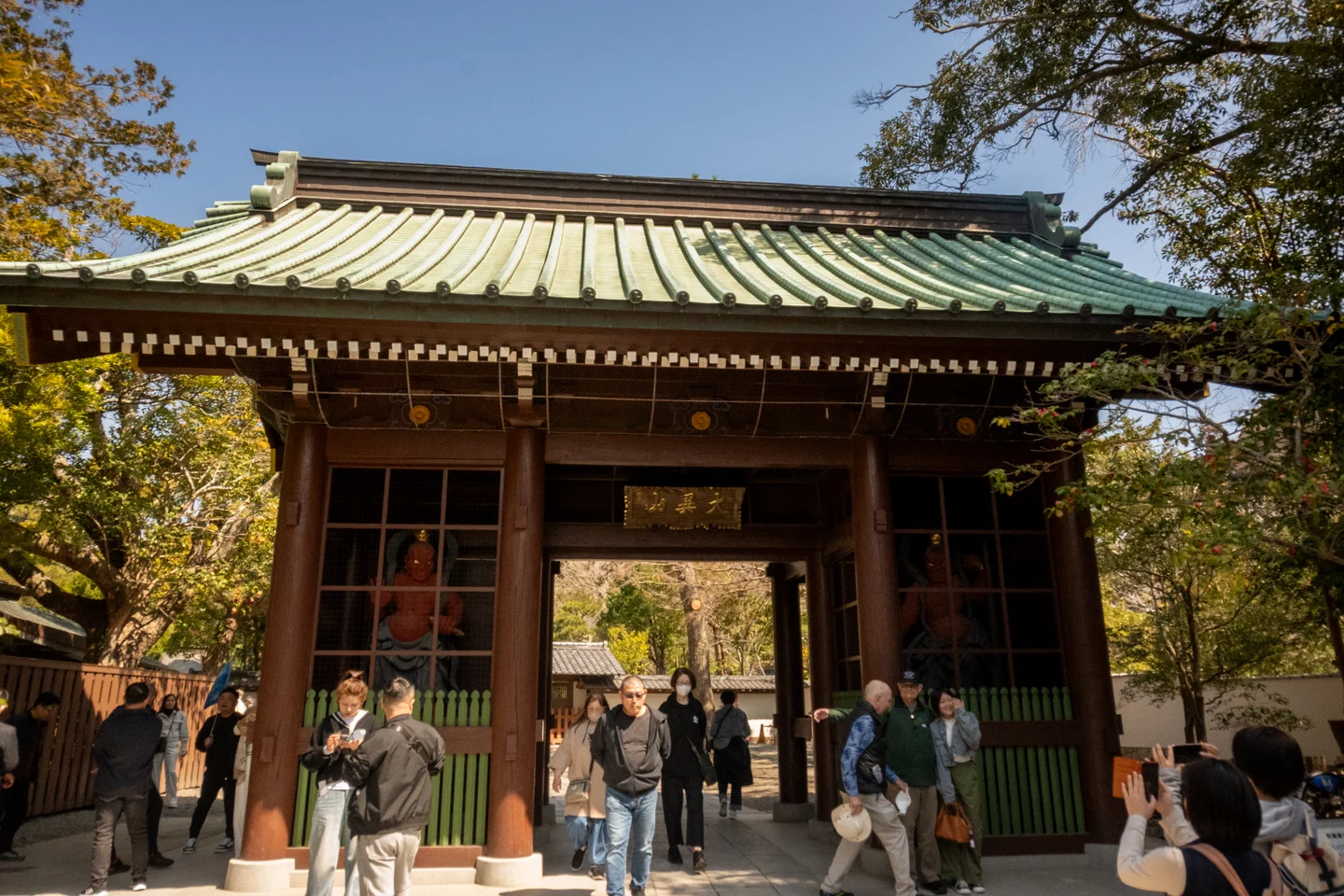
Making your way through the gate, following the path and turning the corner, you are immediately met with the sight of the giant bronze statue of the Amida Buddha sitting serenely in the open air.

It's an awe-inspiring sight to behold, standing at around 13.35 meters (including base) tall, and weighing approximately 121 tonnes, it is one of the largest Buddha statues in Japan.
Not only is the size impressive, it has stood the test of time, having been constructed in 1252, it has survived numerous earthquakes, typhoons, and even a tsunami, which destroyed the original temple building that housed the statue.
After spending some time admiring the statue and taking a few photos for the ol' blog, we made our way out with our tour group towards Hase Station, which was only a short walk away.
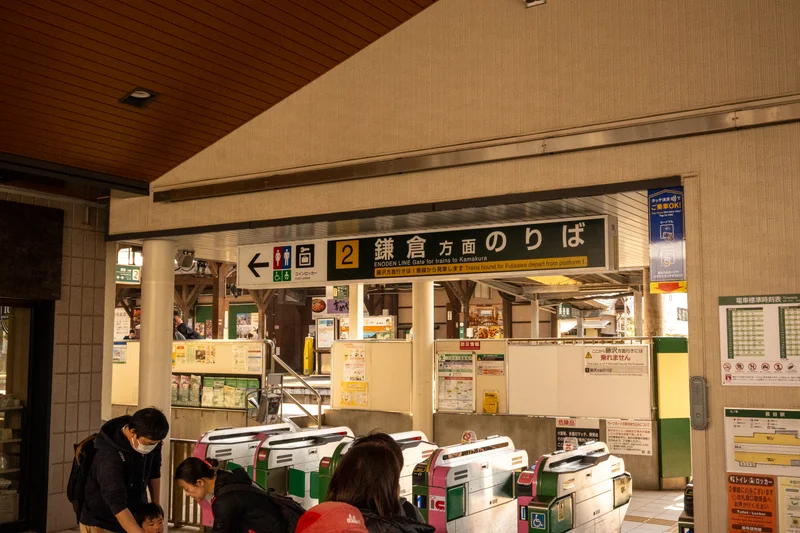
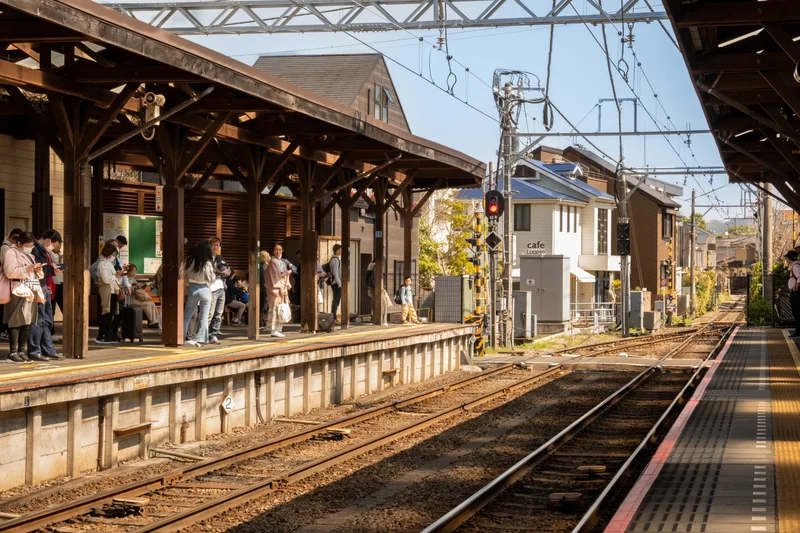
The station is a small and quaint stop, it's a very scenic railway line that will really invoke those warm and fuzzy feelings of nostalgia for anyone that has ever watched a Studio Ghibli film, it really feels like a magical train ride through the countryside! 🚃🍃
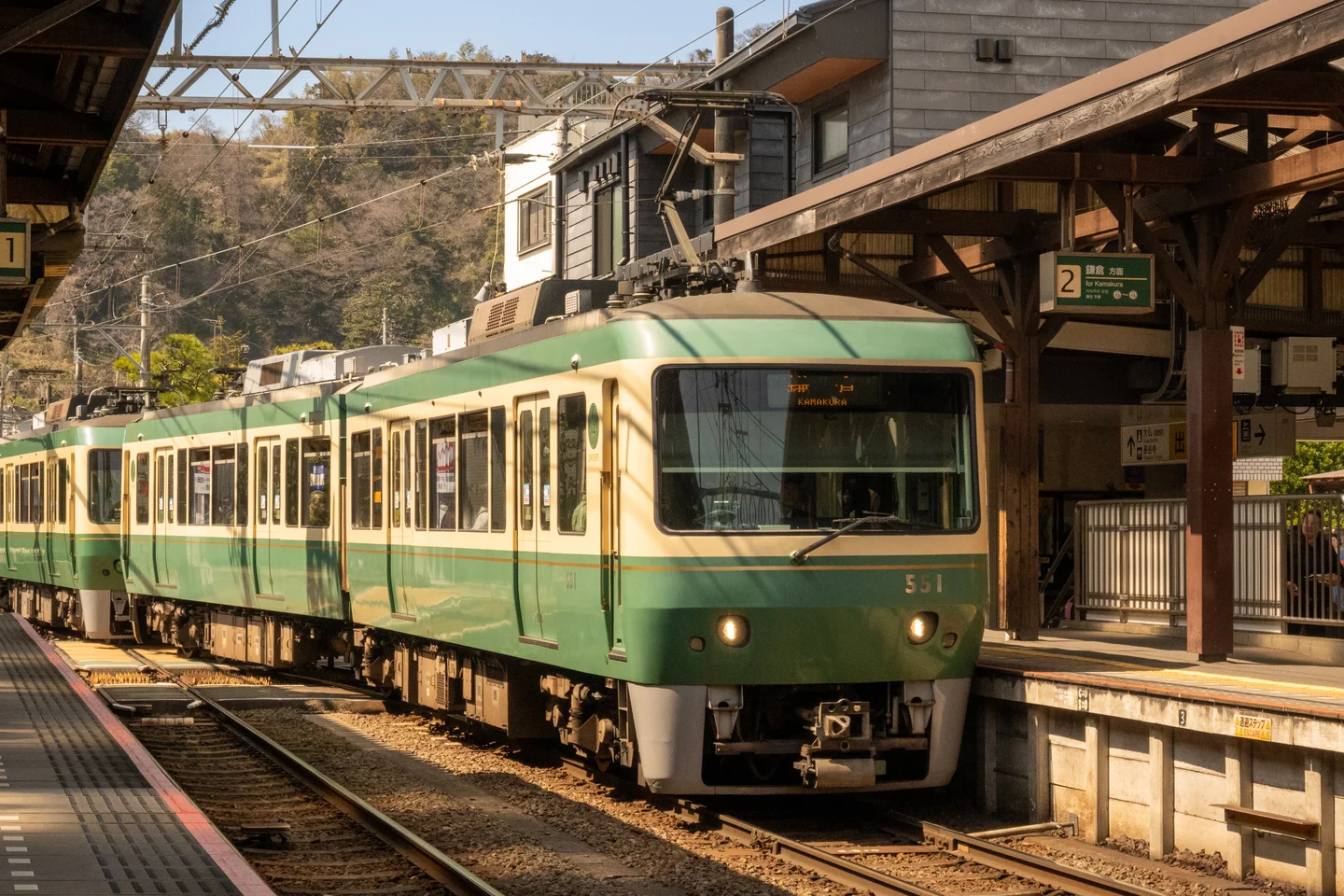
The train we're getting on is the famous Enoshima Electric Railway (Enoden for short), which is a small local railway line that runs along the coast from Kamakura to Fujisawa, it's known for having operated since 1900 (over 120 years!), it's scenic views of the ocean, and of course being featured in one of my all time favourite anime's, Slam Dunk! 🏀

The Enoden ride felt serene — threading through Kamakura's narrow streets, past lush greenery, neighbourhoods, and level crossings where locals went about their day. We even spotted a newly married couple in a western-style suit and dress — a sign, perhaps? 🤔
Making it to Kōkōmae Station with our group, we hop off the retro Enoden train, and head over to the famous (and unbelievably crowded) Kamakura Kōkōmae Crossing.
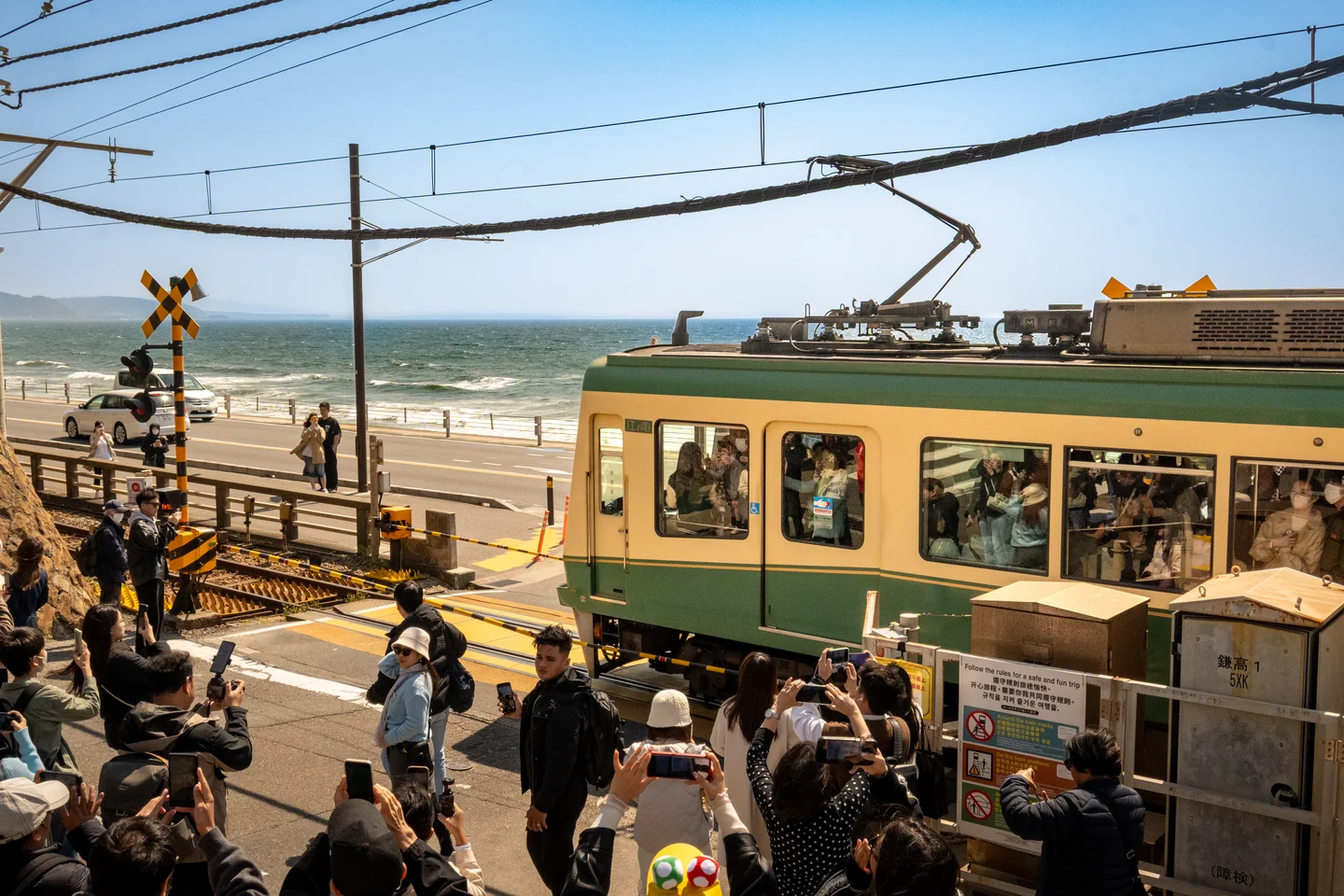
This was the crossing that was featured in the opening of the original Slam Dunk anime, where the main character Hanamichi Sakuragi first meets Haruko Akagi while crossing the street, it's a super iconic scene for any Slam Dunk fan! Just don't come here expecting to reenact the scene unless you get in early at the wee hours of the morning — it's absolutely swamped with people all day long! 😅
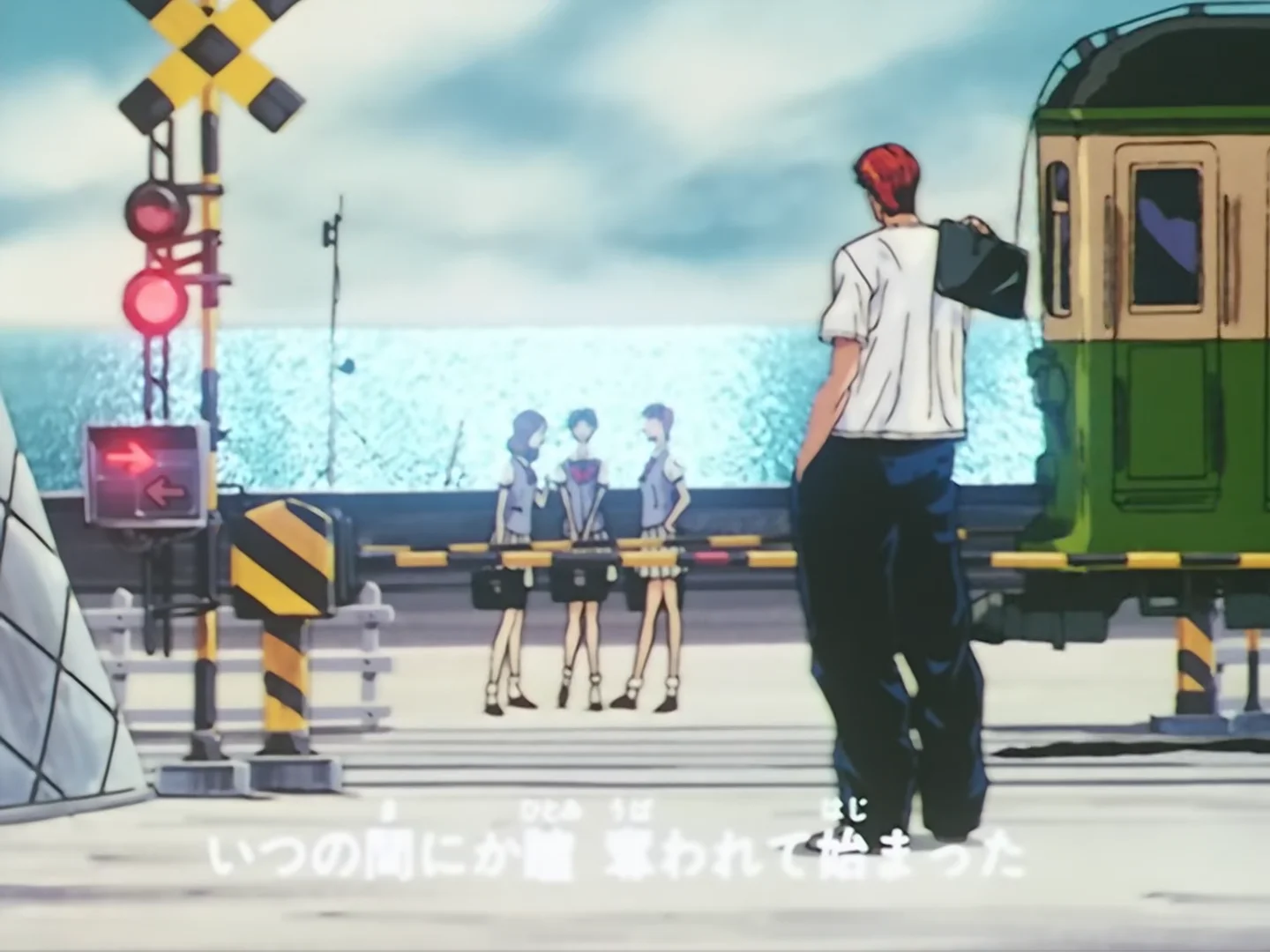
Enoshima Island
After soaking in the picturesque train crossing on the backdrop of the open sea, we head back to the station to continue on our way towards Enoshima Island.

Once we arrive it's only a short walk to the famous Enoshima Benten Bridge, which connects the mainland to Enoshima Island. The bridge is named after Benzaiten, the goddess of everything that flows: water, time, words, speech, eloquence, music and by extension, knowledge.
The length of the bridge is aproximately a herculean 600 meters, on a clear day you can see all the way to Mt. Fuji from the bridge, however unfortunately for us it was a bit hazy, so we couldn't get the postcard view. 😔
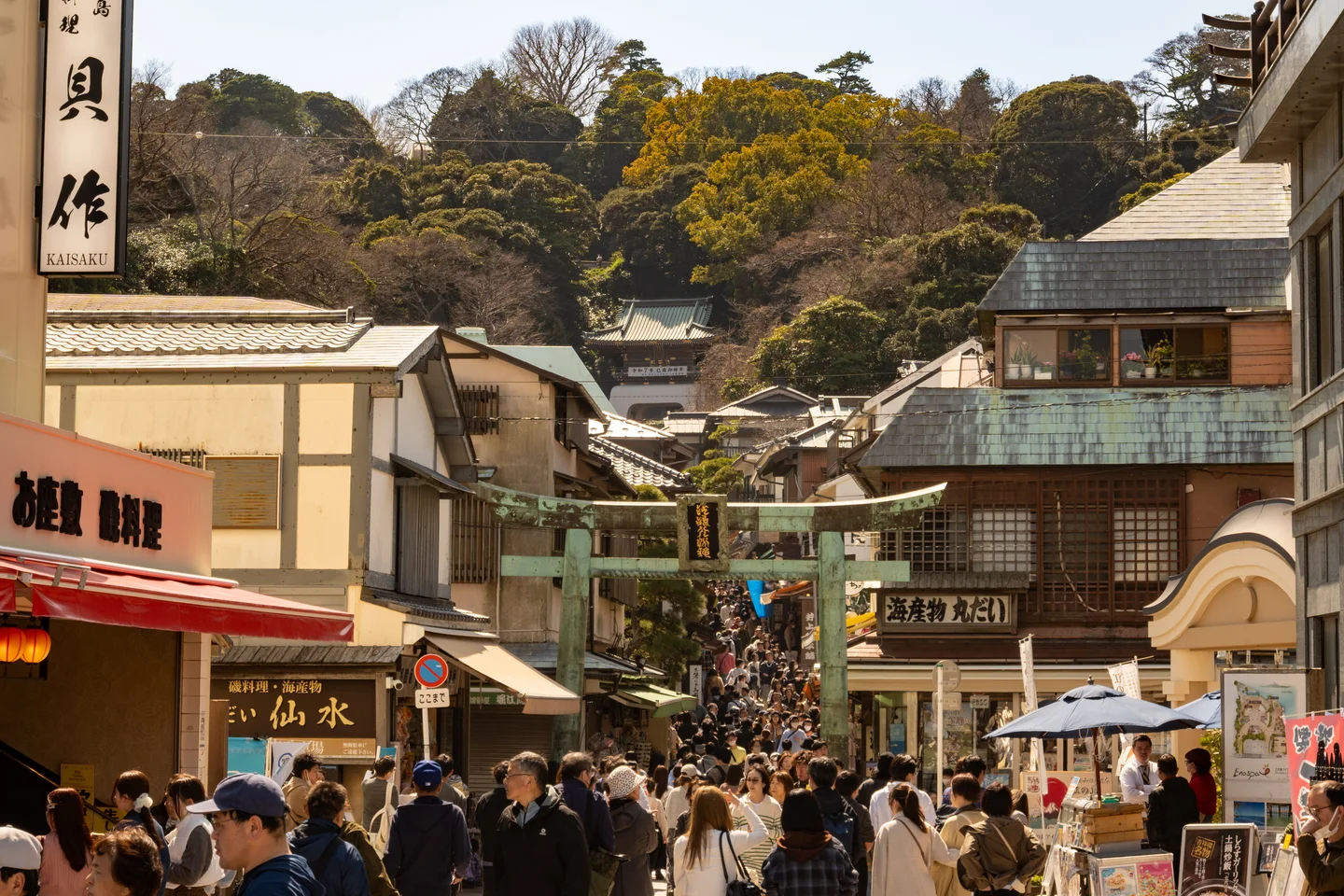
Crossing over the bridge, we arrived at the entrance to Enoshima Island, where the streets are lined with souvenir shops, food stalls, and small restaraunts. Looking towards the center of the island, and with our tour guide leading the way, we make our way towards the torii gate marking the entrance to Benten Nakamise Street which is the main shopping street on the island, and leads up to the Enoshima Shrine.
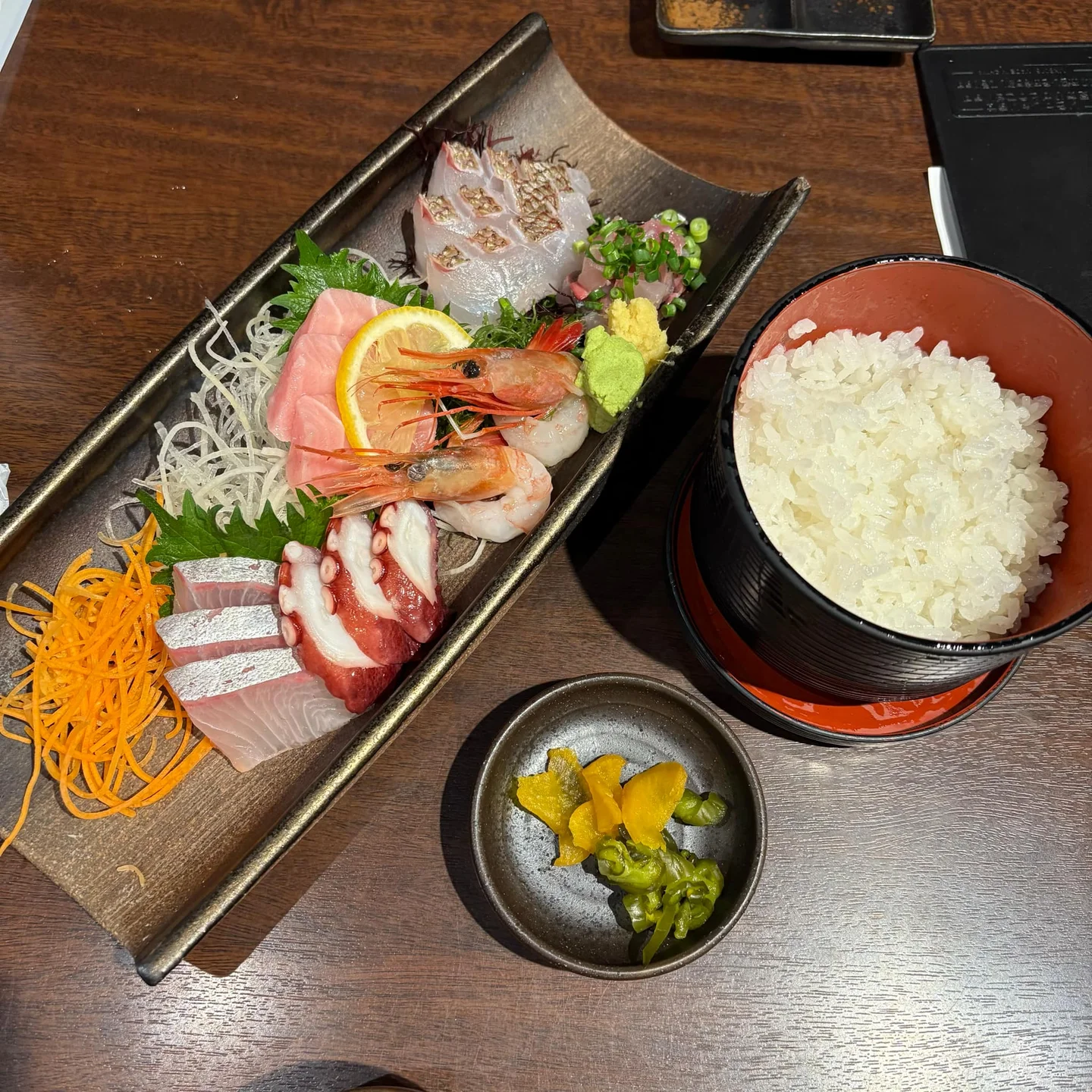
Just before making our way up the street, the group disperses for lunch, and we head into a small little restaraunt called Seafood Ryori Amami which was recommended by our tour guide. It had a really old-school charm to it, with some traditional seated tatami mat areas, as well as some regular table seating.
We get ourselves a modestly sized seafood platter, which we thought might be enough for two, but it ended up leaning a bit on the smaller side — the stars of the lunch were definitely the tuna belly sashimi, and the creamy sweet prawns, it was like the candy of the sea! The size of our lunch turned out to be fine, as we were going to hit the stalls and grab a few snacks after lunch anyway! 🦐
Straight after lunch the super special Shrimp Cracker snack known as Tako Senbai was calling my name, so we made our way over into the long line at Maruyaki Tako Senbei Asahi to grab one of these famous crispy octopus crackers, although we instead opted for the shrimp version as it was one of the "specials" for the spring season.
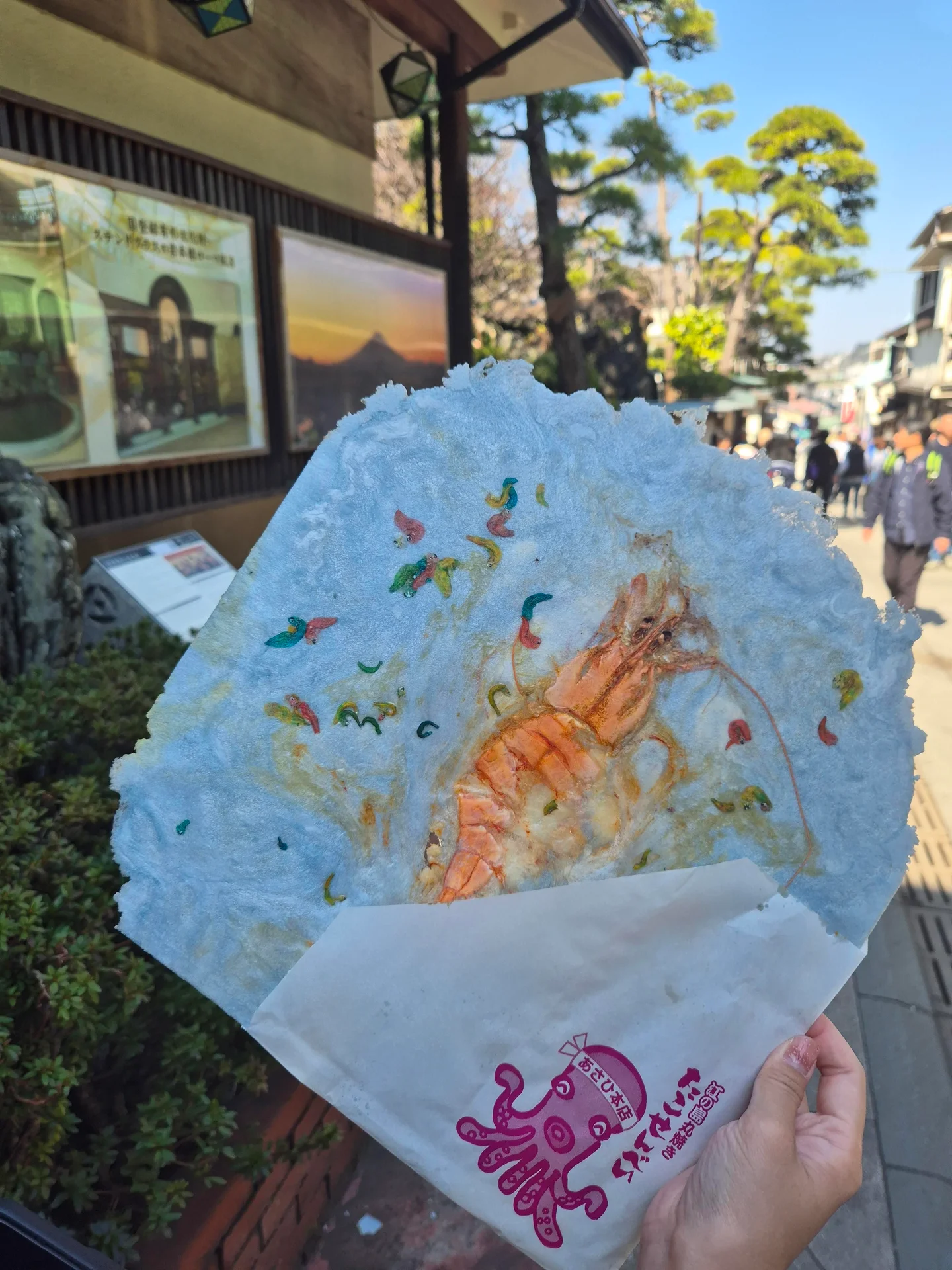
The way these are made is pretty interesting, typically for the standard octopus crackers, they take a whole octopus, and flatten it out, then grill it inside a huge iron press, which is heated up to a very high temperature, and then pressed down onto the octopus, which crisps it up into a thin, crunchy cracker — if you're familiar with Star Wars, it kind of reminded me of when Han Solo got frozen in carbonite! 🗿
The same goes for the big ol' shrimp crackers. If you come here look for the weird looking octopus signage in Benten Nakamise, and you'll find the shop.
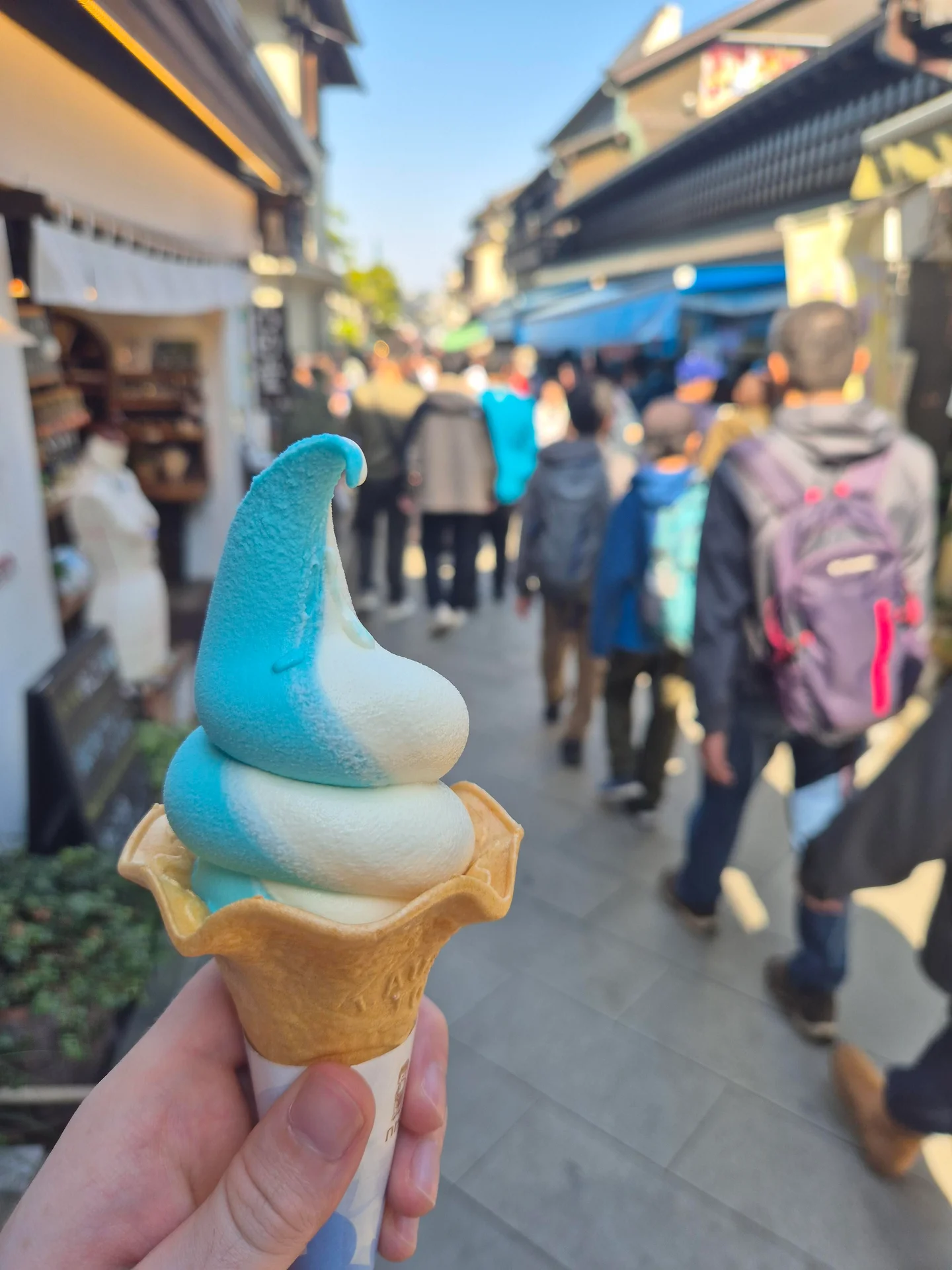
After the salty snack, we needed something sweet to balance it out, and literally 30 seconds up the street, we found an ice-cream shop selling Hokkaido milk ice-cream, mixed with vanilla and a blue soda flavour — my excuse for the sugar-hit was that I needed the energy for the hike up to one of the shrines on the island! 🏃💨
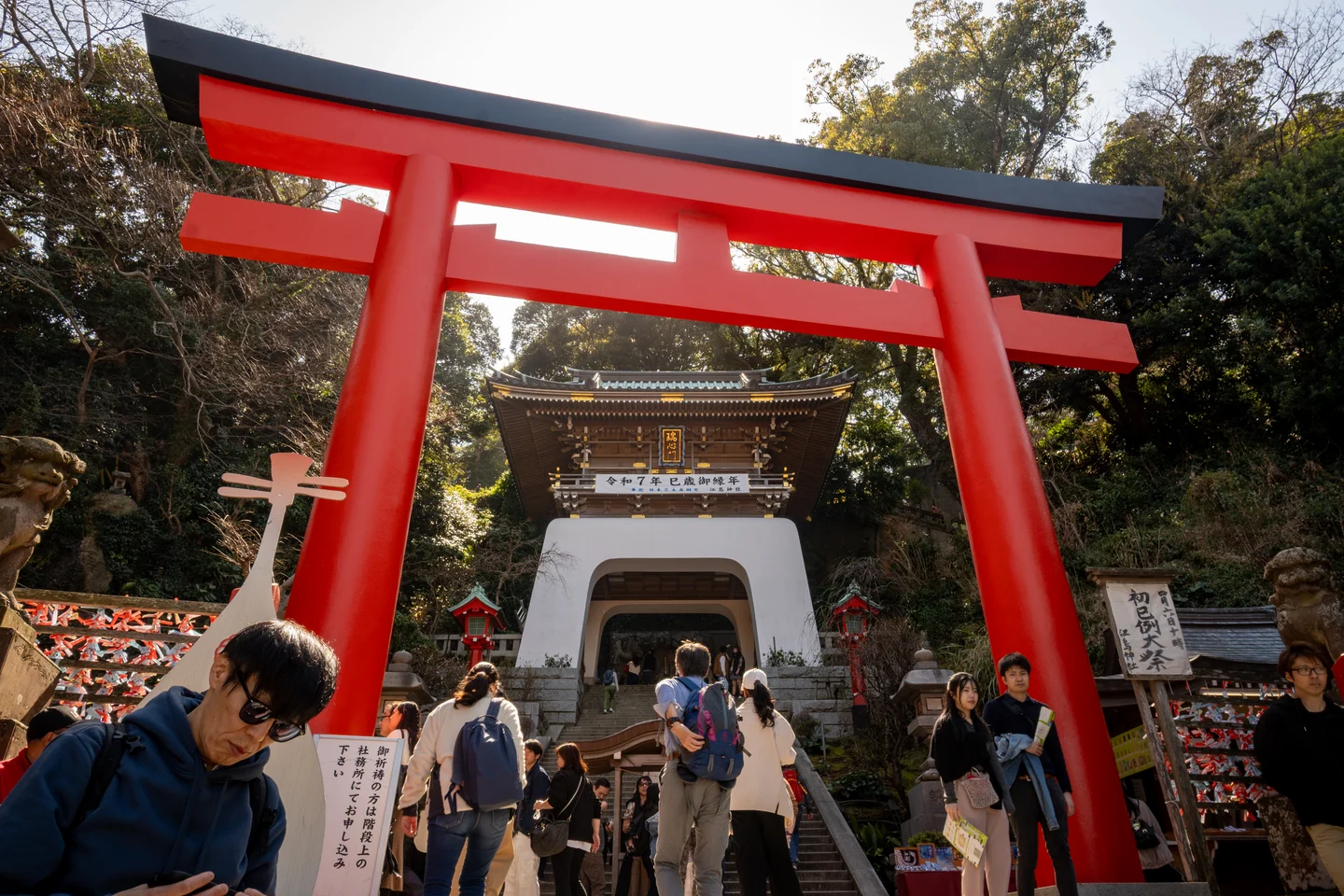
Making our way up the hill through a large red torii gate toward the first of the shrines collectively known as Enoshima Shrine, you feel as if you're stepping through a portal into another world, completely separate from the commotion of the shops and streets below.
Following the stairs, we eventually reach an open area with the first of the three main shrines, and a few other smaller shrines that had a nearby fountain, where you could attempt to throw a coin into a small standing bowl from a distance, to make a wish - which we both fortunately managed to make in! 🙏💰
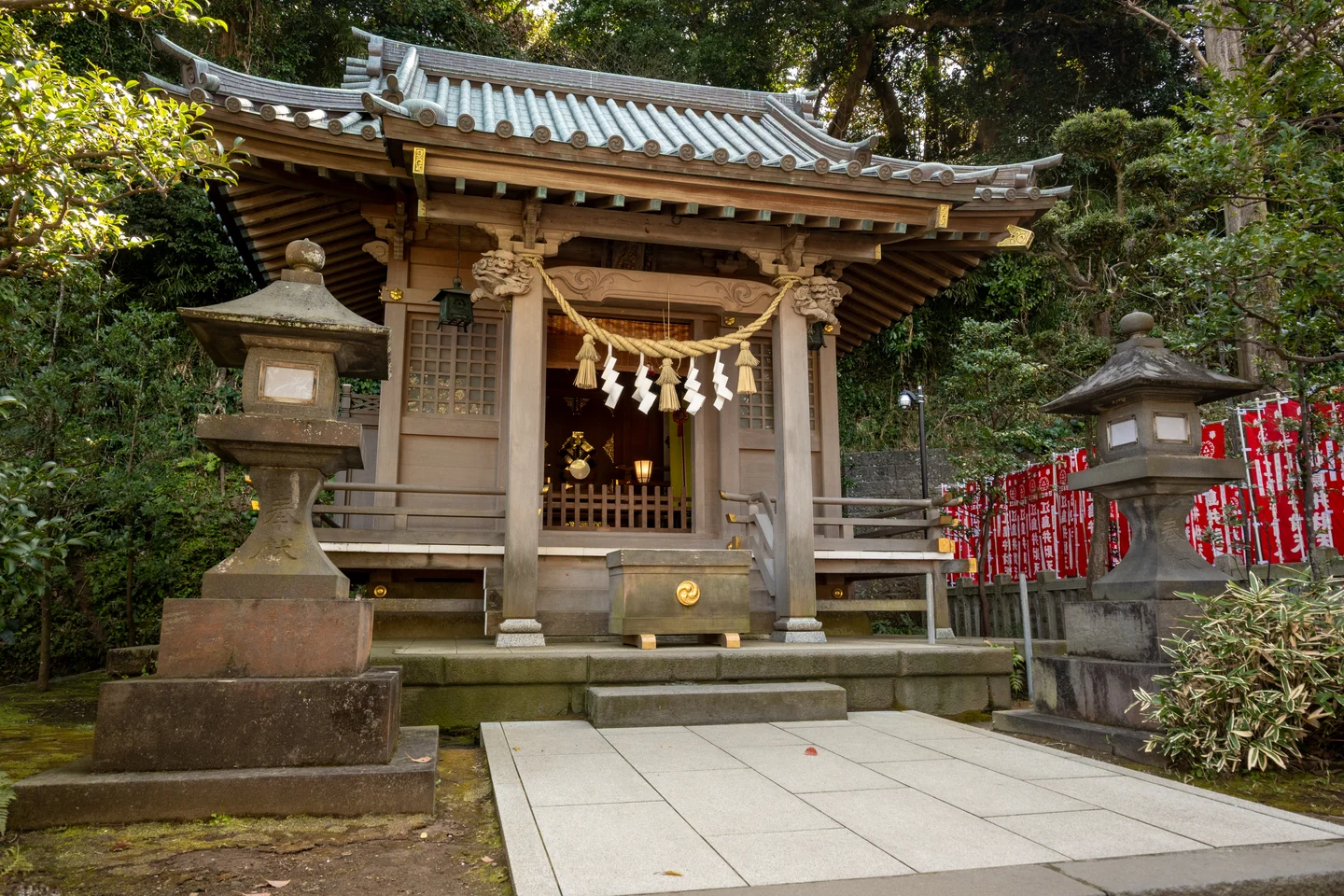
Passersby would walk up to the shrine and offer their prayers—the dragons on the posts making sure that no evil spirits would follow them in!
After spending some time exploring the nearby shrines and gardens, we continued up the hill toward the top of the island. As we walked up, there was a spot to stop and take in the postcard view of the ocean, sailboats, and the nearby coastline of Kamakura — fun fact: the Enoshima Yacht Club was originally built in 1964 for the Tokyo Olympics and upgraded in 2020, also for the Olympics.
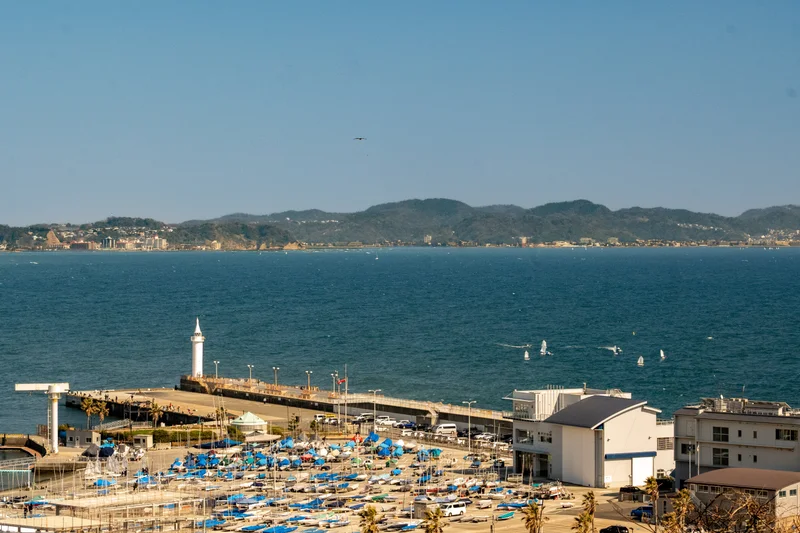
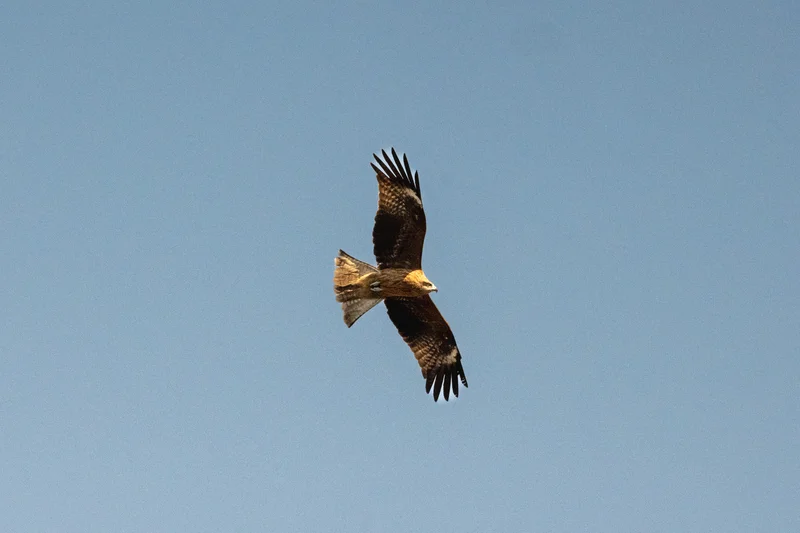
Zooming in on the little dark spot in the distance, I found one of Enoshima's winged troublemakers, a Black-Eared Kite, also locally known as "tobi." These birds are known for their sharp talons, and with the explosion of tourism in the area, they've mostly given up hunting small rodents and instead patrol the island looking for scraps of food from unsuspecting tourists — the general advice is to not have food in the open and avoid walking while eating. 😅
Just a bit further up the hill, we arrived at the middle shrine of Enoshima, known as Nakatsumiya Shrine. It's one of the three shrines on the island, the first being Hetsumiya which we passed through earlier on our way up, the last was Okutsumiya which is at the summit, but unfortunately we didn't have enough time to visit. The red colour of the shrine is much like that of the torii gates, symbolizing protection against evil.
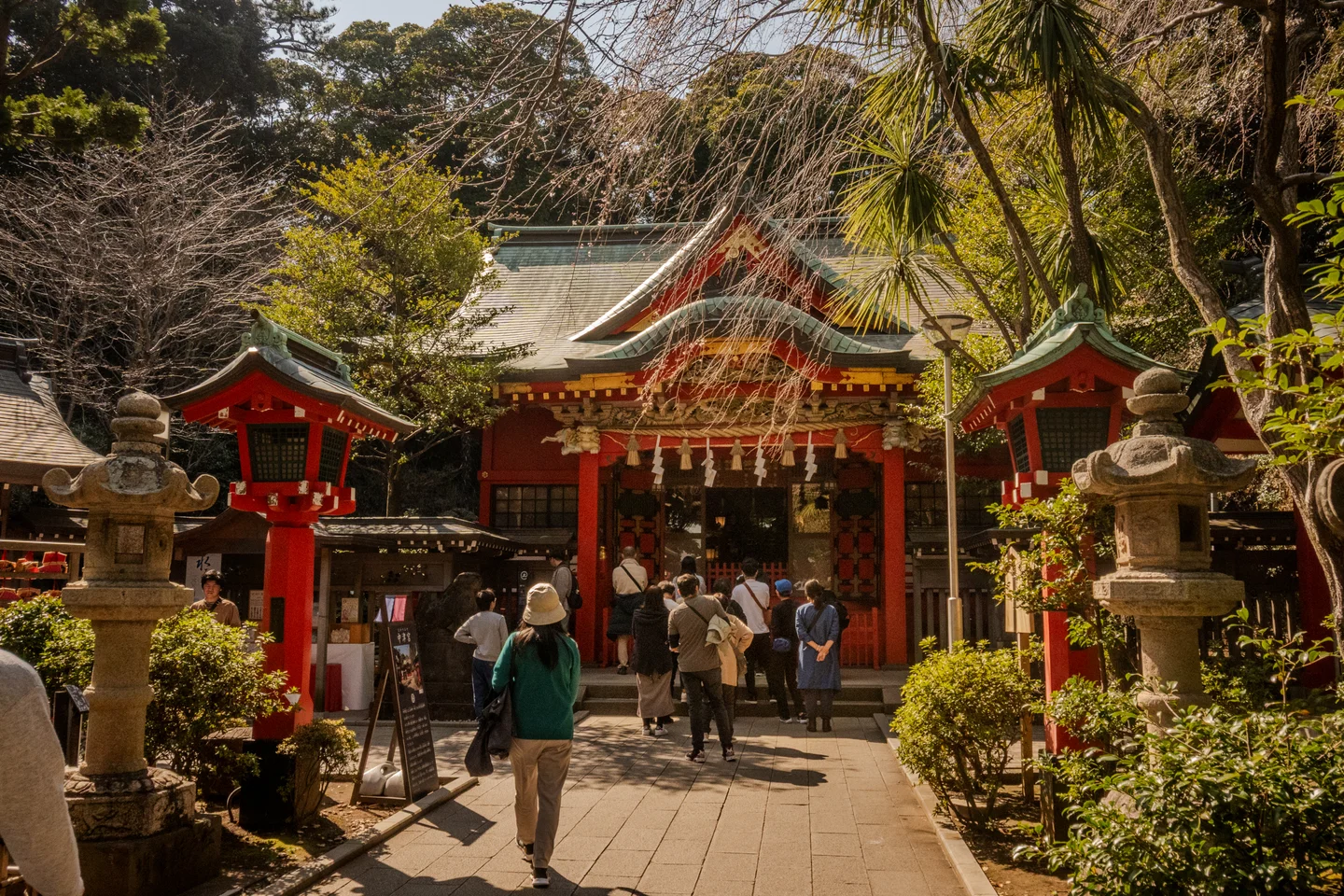
Heading back down toward Benten Nakamise Street, we took one last moment to appreciate the view of the narrow street lined with traditional Japanese shops and the huge crowd of tourists that had gathered now that it was well into the afternoon.

Our time on the island was coming to an end — descending back down proved much easier than the climb up the long street of Benten Nakamise. We had to make our way back down to meet up with our tour group for the bus ride back into the heart of Kamakura for our next stop: Tsurugaoka Hachimangu Shrine, one of the most historically significant Shinto shrines in Japan.
Tsurugaoka Hachimangu Shrine
Now arriving back in the main township of Kamakura, bus parked safely in a small lot, we march with our tour group along the narrow streets before reaching one of the paths leading into the main shrine grounds.
While walking along, we spot probably one of the best cherry blossom trees we've seen in Japan so far, sprouting out from the thick canopy of trees — it was by this point that Cherry Blossom season had finally kicked off! Finally... 😭🌸
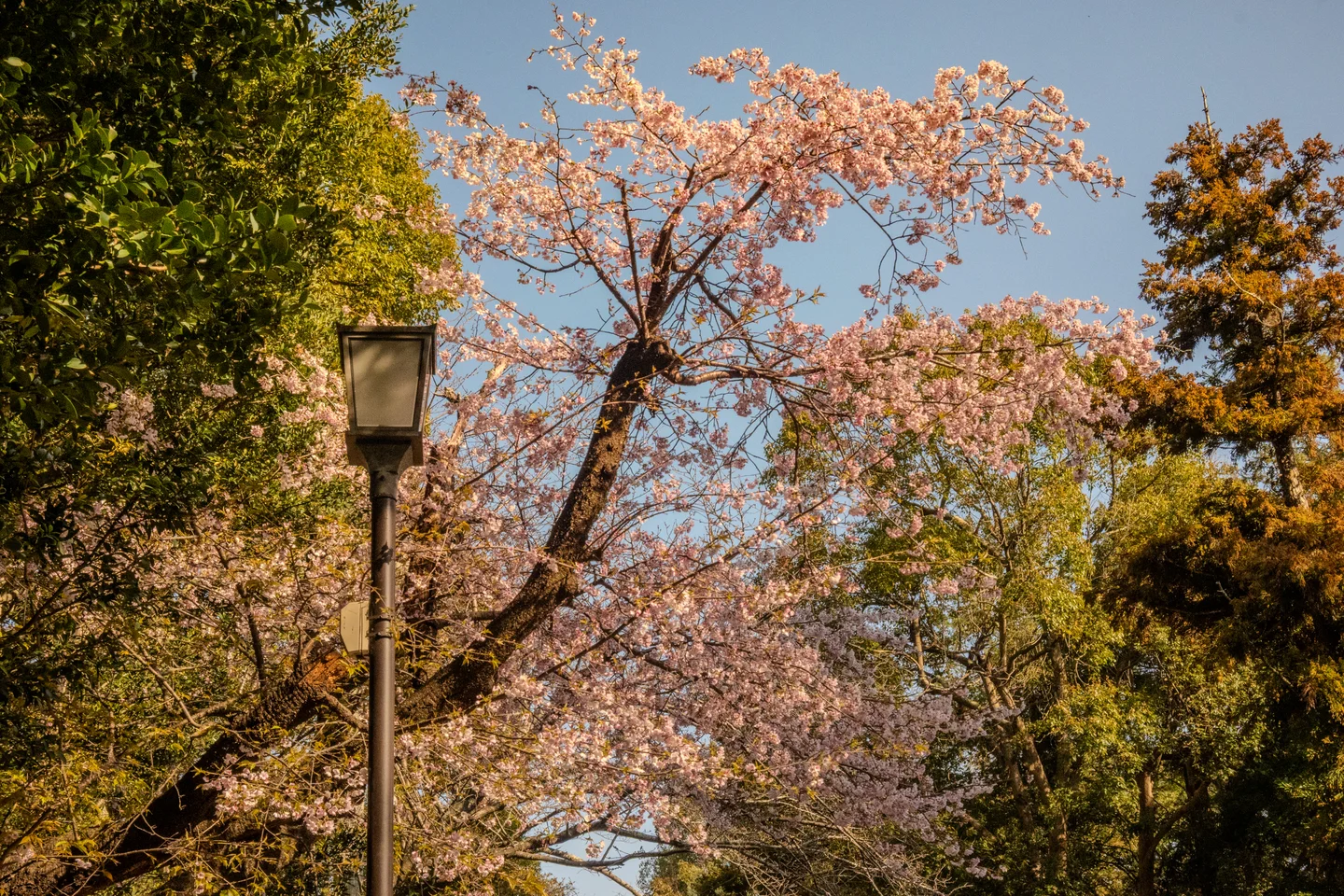
A quick history lesson: Tsurugaoka Hachimangu Shrine was founded in 1063 by Minamoto Yoriyoshi, a Japanese samurai lord. It was later expanded in 1180 by Minamoto no Yoritomo, who established the first military-led government and served as the first shogun of the Kamakura shogunate, as well as the first ruling shogun of Japan.
The shrine itself is dedicated to the god Hachiman, who is the patron deity of warriors and is considered the guardian of the samurai class. It's known for its grand design, with a large torii gate and a large main hall (Hongū) overlooking Komachi-dori street.

After quickly admiring the shrine shrouded in the trees, we made our way up the staircase to find a much smaller shrine that was preceded by a series of equally small torii gates, adorned with the traditional shinto decorations.
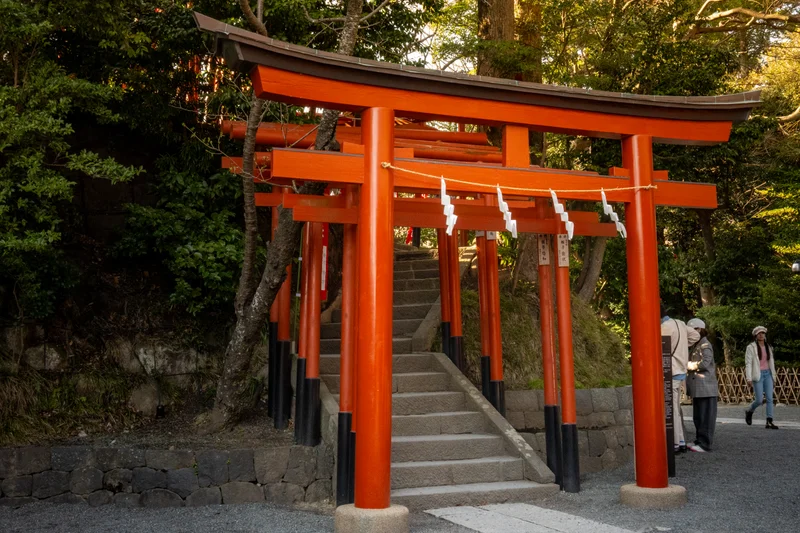

This shrine was an interesting surprise. In typical fashion, you had the red torii gate before the actual shrine, with two fox statues on either side of the gate. These foxes are meant to be the intermediaries between humans and the gods. The red bibs they wear are offered by locals out of respect and are meant to have protective qualities — you'll find they almost always come in pairs, with one representing a male and the other a female.
With the hidden shrine at the top of the grand stairway now explored, we made our way back down the stairs to the main shrine and finally across the bridge that leads into Komachi-dori street. Fun fact: the bridge on the other side of the pedestrian bridge is known as Taikobashi, literally meaning "drum bridge" due to its drum-like shape when reflected in the water. It was exclusively reserved for the Shogun, and this is why you'll see that it remains closed off from the public even today! 🚧
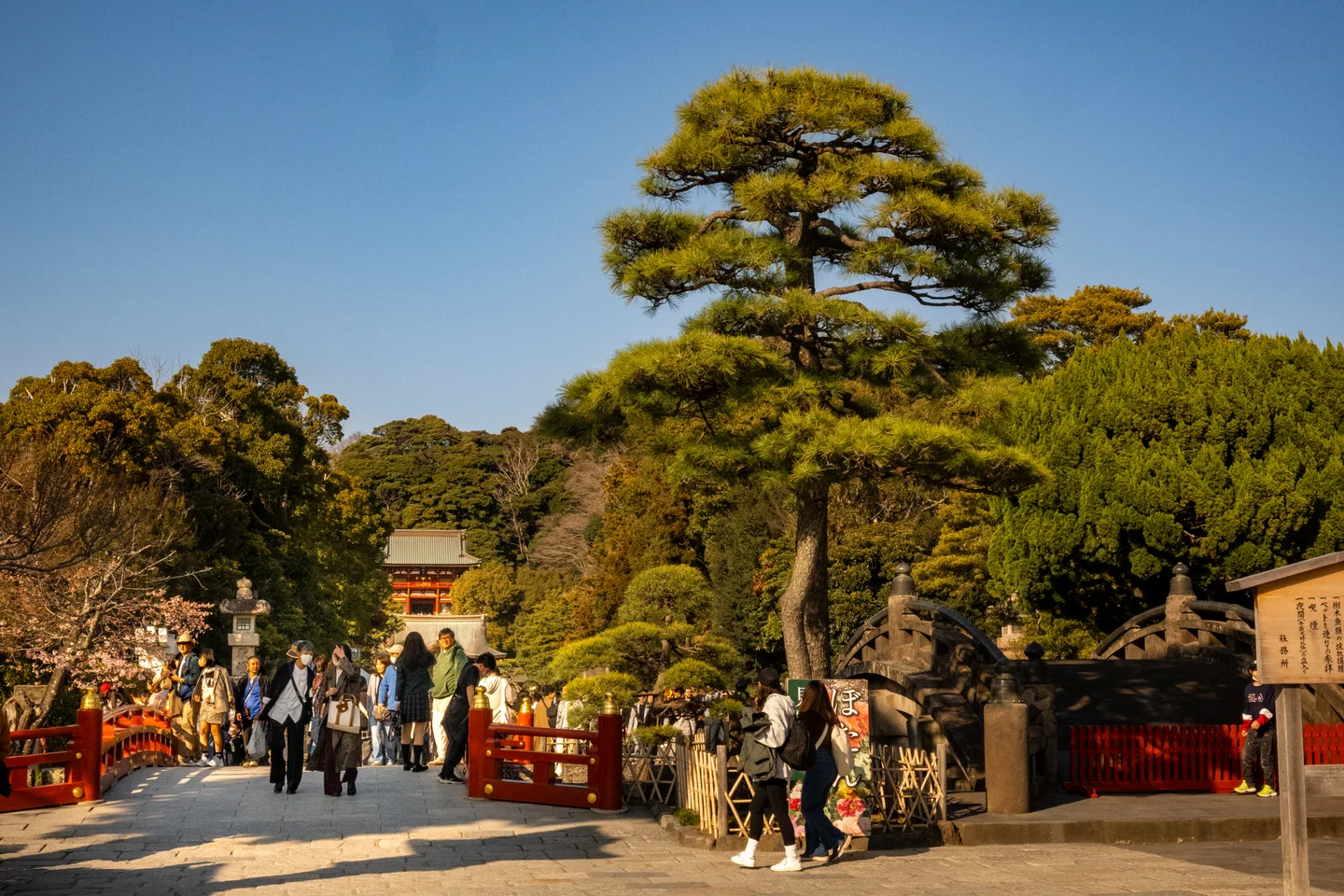
Heading out onto Komachi-dori street, there's a seemingly endless line of shops on both sides. Running parallel to this bustling shopping district is Wakamiya Oji, the historic ceremonial avenue that dates back to 1182 and leads directly to Tsurugaoka Hachimangu Shrine.
This sacred processional route features the famous Dankazura pathway — a raised stone walkway lined with cherry blossom trees that creates a stunning pink tunnel during spring bloom. When we arrived, the trees weren't quite fully in bloom yet, but we still got to enjoy some creamy matcha ice cream from one of the nearby shops! 🍦
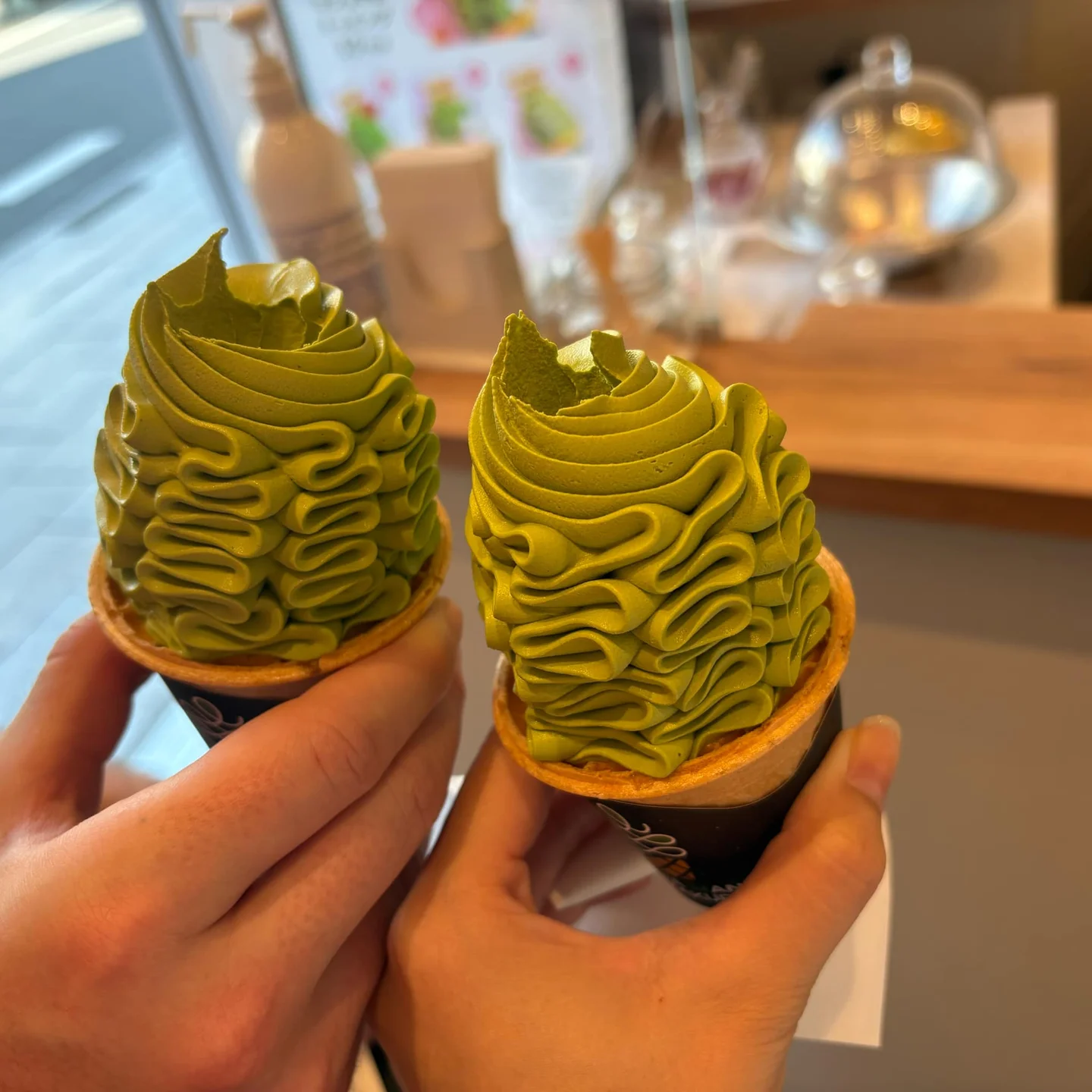
In typical Japanese fashion, we finished our ice-cream in the shop as walking while eating is not really a thing. With the sweet tooth satisfied, we headed back on-to the bus for a quick-"ish" journey back to Shinjuku, with the sun starting to set, we would be getting back just in time for dinner!
After a quick nap on the bus, we arrived in Shinjuku. Hopping off the bus, I pop open Google Maps and type in those magical words: "tempura"... 😏
Target located! Only a short 15 minute walk away, we made our way down some stairs into the basement of the Shinjuku Nomura building, where we ducked into the warmly lit corner marked by white noren curtains and the scent of deep-fried perfection: Tenkichiya.
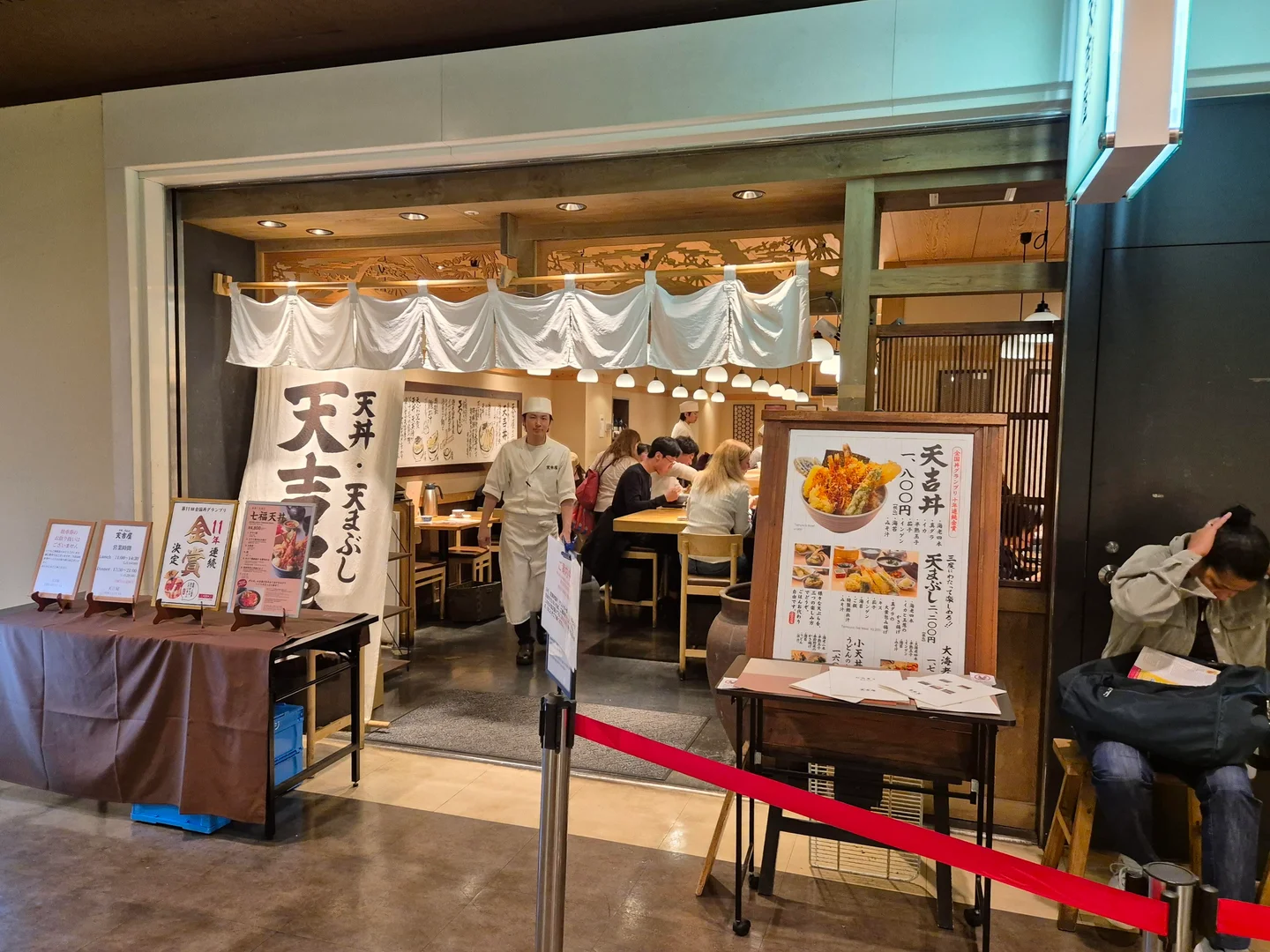
The atmosphere was very cosy, with a warm and inviting ambiance, we were seated at the counter right beside the open kitchen, where the chefs were preparing the tempura and frying them up right in front of us!
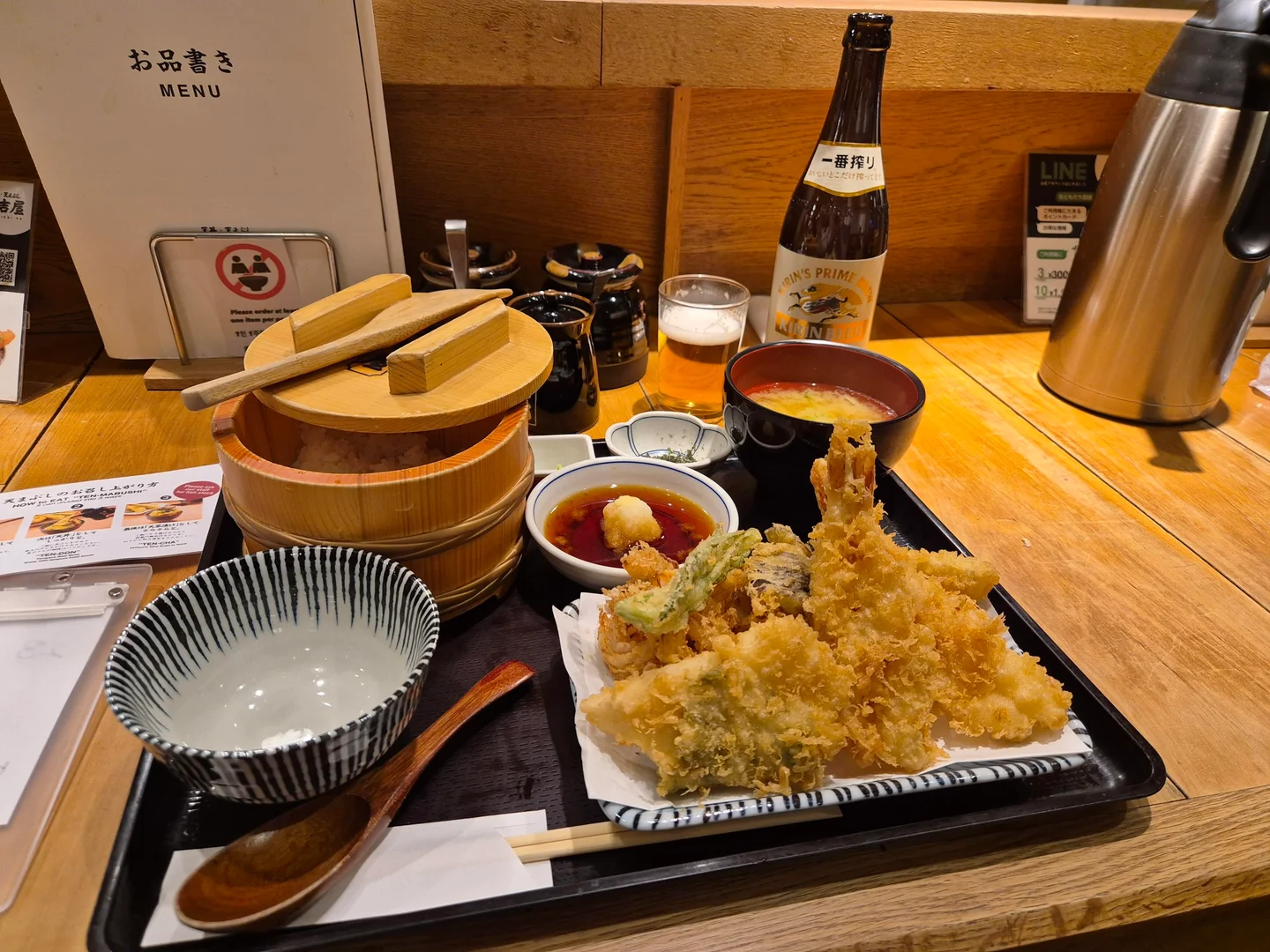
I treated myself to one of the large beer bottles that are usually for sharing, but tonight it was just me and the beer. 🤫 It went really well with the mix of vegetables and seafood tempura, which was slightly nutty, cripsy and light, with a perfect balance of flavors — not greasy at all! Easily one of the best tempura I've ever had (so far)... 😏
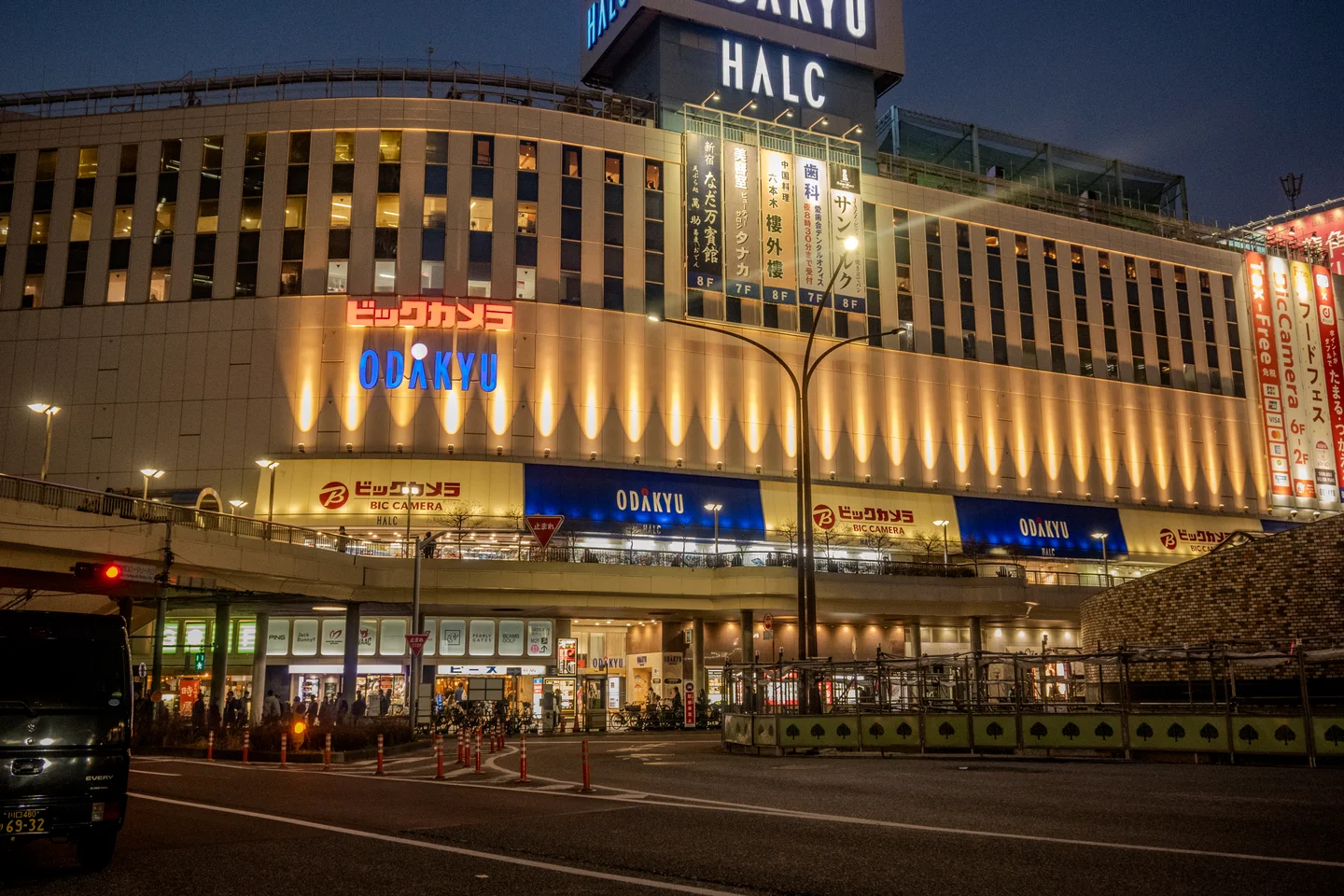
Now refueled, and stomachs full, we headed back towards Shinjuku station to catch the Toei subway back to Asakusa.
Tomorrow morning we were off to Kyoto via the Shinkansen, to be continued!